Quick filters:
China 220 bce Stock Photos and Images
 947 Ornamental Gateway (Pailou) from Han Dynasty (202 BCE – 220 CE) across a Street Lined with Small Shops. Hanzhong, Shaanxi Province, China, 1875 WDL2092 Stock Photohttps://www.alamy.com/image-license-details/?v=1https://www.alamy.com/947-ornamental-gateway-pailou-from-han-dynasty-202-bce-220-ce-across-a-street-lined-with-small-shops-hanzhong-shaanxi-province-china-1875-wdl2092-image185496779.html
947 Ornamental Gateway (Pailou) from Han Dynasty (202 BCE – 220 CE) across a Street Lined with Small Shops. Hanzhong, Shaanxi Province, China, 1875 WDL2092 Stock Photohttps://www.alamy.com/image-license-details/?v=1https://www.alamy.com/947-ornamental-gateway-pailou-from-han-dynasty-202-bce-220-ce-across-a-street-lined-with-small-shops-hanzhong-shaanxi-province-china-1875-wdl2092-image185496779.htmlRMMNP30Y–947 Ornamental Gateway (Pailou) from Han Dynasty (202 BCE – 220 CE) across a Street Lined with Small Shops. Hanzhong, Shaanxi Province, China, 1875 WDL2092
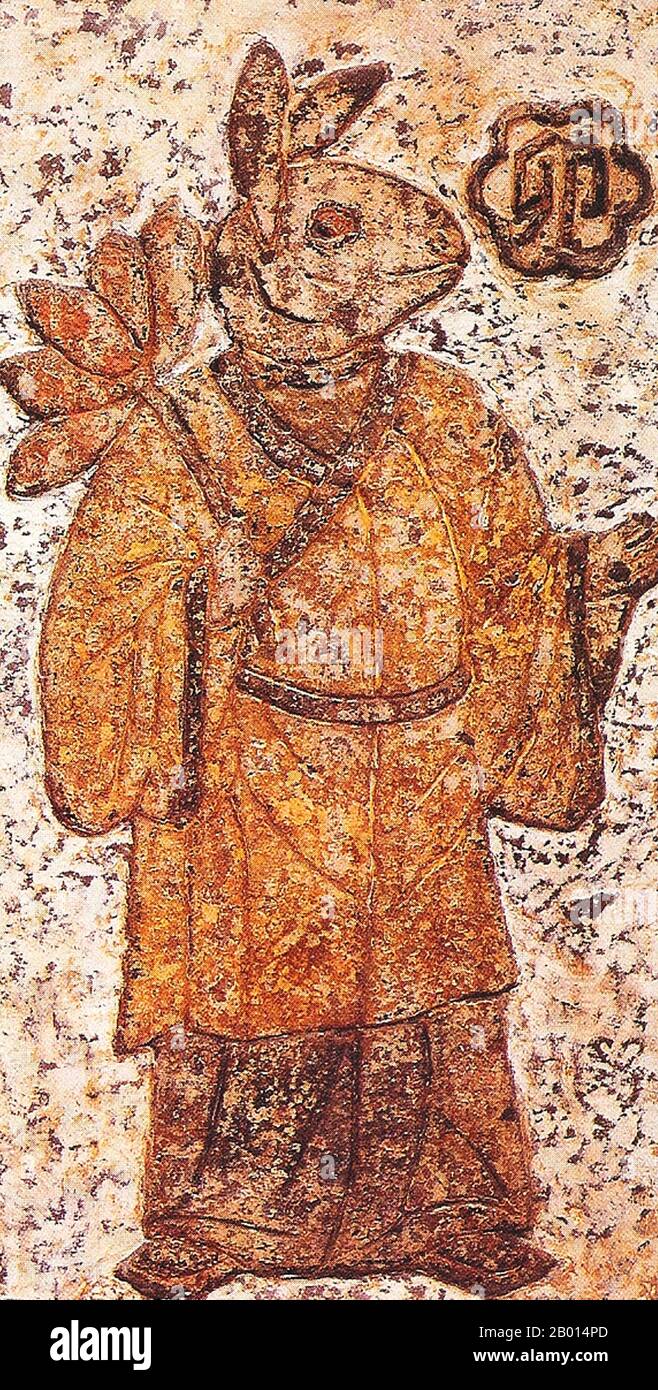 China: Guardian Deity of the Morning, ceramic tile painting, Han Dynasty (202 BCE - 220 CE). Painting on a ceramic tile from the Chinese Han Dynasty. This figure, wearing Han Dynasty robes, represents the Guardian Spirit of Dawn (from 5 to 7 am). Stock Photohttps://www.alamy.com/image-license-details/?v=1https://www.alamy.com/china-guardian-deity-of-the-morning-ceramic-tile-painting-han-dynasty-202-bce-220-ce-painting-on-a-ceramic-tile-from-the-chinese-han-dynasty-this-figure-wearing-han-dynasty-robes-represents-the-guardian-spirit-of-dawn-from-5-to-7-am-image344233077.html
China: Guardian Deity of the Morning, ceramic tile painting, Han Dynasty (202 BCE - 220 CE). Painting on a ceramic tile from the Chinese Han Dynasty. This figure, wearing Han Dynasty robes, represents the Guardian Spirit of Dawn (from 5 to 7 am). Stock Photohttps://www.alamy.com/image-license-details/?v=1https://www.alamy.com/china-guardian-deity-of-the-morning-ceramic-tile-painting-han-dynasty-202-bce-220-ce-painting-on-a-ceramic-tile-from-the-chinese-han-dynasty-this-figure-wearing-han-dynasty-robes-represents-the-guardian-spirit-of-dawn-from-5-to-7-am-image344233077.htmlRM2B014PD–China: Guardian Deity of the Morning, ceramic tile painting, Han Dynasty (202 BCE - 220 CE). Painting on a ceramic tile from the Chinese Han Dynasty. This figure, wearing Han Dynasty robes, represents the Guardian Spirit of Dawn (from 5 to 7 am).
 Dancing Figure, one of a pair, 206 BCE - 220 CE, 4 1/2 in. (11.43 cm), Earthenware, China, 3rd century BCE - 3rd century CE Stock Photohttps://www.alamy.com/image-license-details/?v=1https://www.alamy.com/dancing-figure-one-of-a-pair-206-bce-220-ce-4-12-in-1143-cm-earthenware-china-3rd-century-bce-3rd-century-ce-image573492819.html
Dancing Figure, one of a pair, 206 BCE - 220 CE, 4 1/2 in. (11.43 cm), Earthenware, China, 3rd century BCE - 3rd century CE Stock Photohttps://www.alamy.com/image-license-details/?v=1https://www.alamy.com/dancing-figure-one-of-a-pair-206-bce-220-ce-4-12-in-1143-cm-earthenware-china-3rd-century-bce-3rd-century-ce-image573492819.htmlRM2T90RXB–Dancing Figure, one of a pair, 206 BCE - 220 CE, 4 1/2 in. (11.43 cm), Earthenware, China, 3rd century BCE - 3rd century CE
 Jade burial suit in Han Dynasty China (206 bce–ce 220) exhibited at Capital Museum in Beijing, China. Stock Photohttps://www.alamy.com/image-license-details/?v=1https://www.alamy.com/stock-photo-jade-burial-suit-in-han-dynasty-china-206-bcece-220-exhibited-at-capital-19192703.html
Jade burial suit in Han Dynasty China (206 bce–ce 220) exhibited at Capital Museum in Beijing, China. Stock Photohttps://www.alamy.com/image-license-details/?v=1https://www.alamy.com/stock-photo-jade-burial-suit-in-han-dynasty-china-206-bcece-220-exhibited-at-capital-19192703.htmlRMB368DK–Jade burial suit in Han Dynasty China (206 bce–ce 220) exhibited at Capital Museum in Beijing, China.
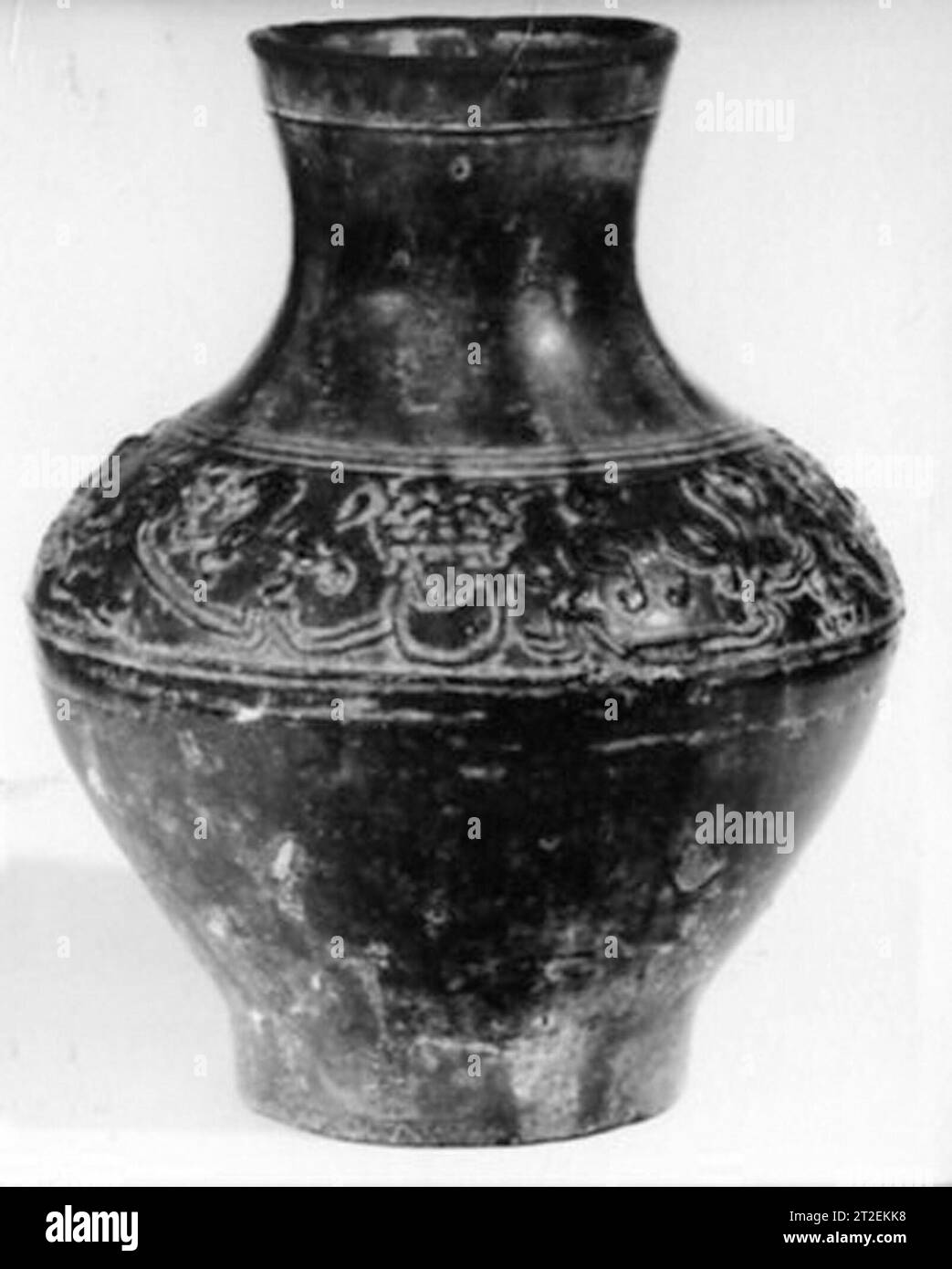 Jar China Han dynasty (206 BCE–220 CE) Stock Photohttps://www.alamy.com/image-license-details/?v=1https://www.alamy.com/jar-china-han-dynasty-206-bce220-ce-image569494220.html
Jar China Han dynasty (206 BCE–220 CE) Stock Photohttps://www.alamy.com/image-license-details/?v=1https://www.alamy.com/jar-china-han-dynasty-206-bce220-ce-image569494220.htmlRM2T2EKK8–Jar China Han dynasty (206 BCE–220 CE)
 Plaque. Culture: China. Dimensions: H. 4 1/4 in. (10.8 cm); W. 5 3/4 in. (14.6 cm). Date: 4th-3rd century B.C.. Museum: Metropolitan Museum of Art, New York, USA. Stock Photohttps://www.alamy.com/image-license-details/?v=1https://www.alamy.com/plaque-culture-china-dimensions-h-4-14-in-108-cm-w-5-34-in-146-cm-date-4th-3rd-century-bc-museum-metropolitan-museum-of-art-new-york-usa-image213397509.html
Plaque. Culture: China. Dimensions: H. 4 1/4 in. (10.8 cm); W. 5 3/4 in. (14.6 cm). Date: 4th-3rd century B.C.. Museum: Metropolitan Museum of Art, New York, USA. Stock Photohttps://www.alamy.com/image-license-details/?v=1https://www.alamy.com/plaque-culture-china-dimensions-h-4-14-in-108-cm-w-5-34-in-146-cm-date-4th-3rd-century-bc-museum-metropolitan-museum-of-art-new-york-usa-image213397509.htmlRMPB52KH–Plaque. Culture: China. Dimensions: H. 4 1/4 in. (10.8 cm); W. 5 3/4 in. (14.6 cm). Date: 4th-3rd century B.C.. Museum: Metropolitan Museum of Art, New York, USA.
 Tomb figure China Han dynasty (206 BCE–220 CE) Stock Photohttps://www.alamy.com/image-license-details/?v=1https://www.alamy.com/tomb-figure-china-han-dynasty-206-bce220-ce-image569498534.html
Tomb figure China Han dynasty (206 BCE–220 CE) Stock Photohttps://www.alamy.com/image-license-details/?v=1https://www.alamy.com/tomb-figure-china-han-dynasty-206-bce220-ce-image569498534.htmlRM2T2EW5A–Tomb figure China Han dynasty (206 BCE–220 CE)
 WASHINGTON DC, United States — The Late Eastern Zhou and Han Dynasties Gallery at the Arthur M. Sackler Gallery in Washington DC. This exhibit showcases artifacts from two pivotal periods in ancient Chinese history, spanning from approximately 500 BCE to 220 CE, offering visitors insights into the artistic, cultural, and technological developments of early imperial China. Stock Photohttps://www.alamy.com/image-license-details/?v=1https://www.alamy.com/washington-dc-united-states-the-late-eastern-zhou-and-han-dynasties-gallery-at-the-arthur-m-sackler-gallery-in-washington-dc-this-exhibit-showcases-artifacts-from-two-pivotal-periods-in-ancient-chinese-history-spanning-from-approximately-500-bce-to-220-ce-offering-visitors-insights-into-the-artistic-cultural-and-technological-developments-of-early-imperial-china-image622400418.html
WASHINGTON DC, United States — The Late Eastern Zhou and Han Dynasties Gallery at the Arthur M. Sackler Gallery in Washington DC. This exhibit showcases artifacts from two pivotal periods in ancient Chinese history, spanning from approximately 500 BCE to 220 CE, offering visitors insights into the artistic, cultural, and technological developments of early imperial China. Stock Photohttps://www.alamy.com/image-license-details/?v=1https://www.alamy.com/washington-dc-united-states-the-late-eastern-zhou-and-han-dynasties-gallery-at-the-arthur-m-sackler-gallery-in-washington-dc-this-exhibit-showcases-artifacts-from-two-pivotal-periods-in-ancient-chinese-history-spanning-from-approximately-500-bce-to-220-ce-offering-visitors-insights-into-the-artistic-cultural-and-technological-developments-of-early-imperial-china-image622400418.htmlRM2Y4GP2A–WASHINGTON DC, United States — The Late Eastern Zhou and Han Dynasties Gallery at the Arthur M. Sackler Gallery in Washington DC. This exhibit showcases artifacts from two pivotal periods in ancient Chinese history, spanning from approximately 500 BCE to 220 CE, offering visitors insights into the artistic, cultural, and technological developments of early imperial China.
 Lamp China Han dynasty (206 BCE–220 CE) View more. Lamp. China. Bronze. Han dynasty (206 BCE–220 CE). Metalwork Stock Photohttps://www.alamy.com/image-license-details/?v=1https://www.alamy.com/lamp-china-han-dynasty-206-bce220-ce-view-more-lamp-china-bronze-han-dynasty-206-bce220-ce-metalwork-image569496905.html
Lamp China Han dynasty (206 BCE–220 CE) View more. Lamp. China. Bronze. Han dynasty (206 BCE–220 CE). Metalwork Stock Photohttps://www.alamy.com/image-license-details/?v=1https://www.alamy.com/lamp-china-han-dynasty-206-bce220-ce-view-more-lamp-china-bronze-han-dynasty-206-bce220-ce-metalwork-image569496905.htmlRM2T2ER35–Lamp China Han dynasty (206 BCE–220 CE) View more. Lamp. China. Bronze. Han dynasty (206 BCE–220 CE). Metalwork
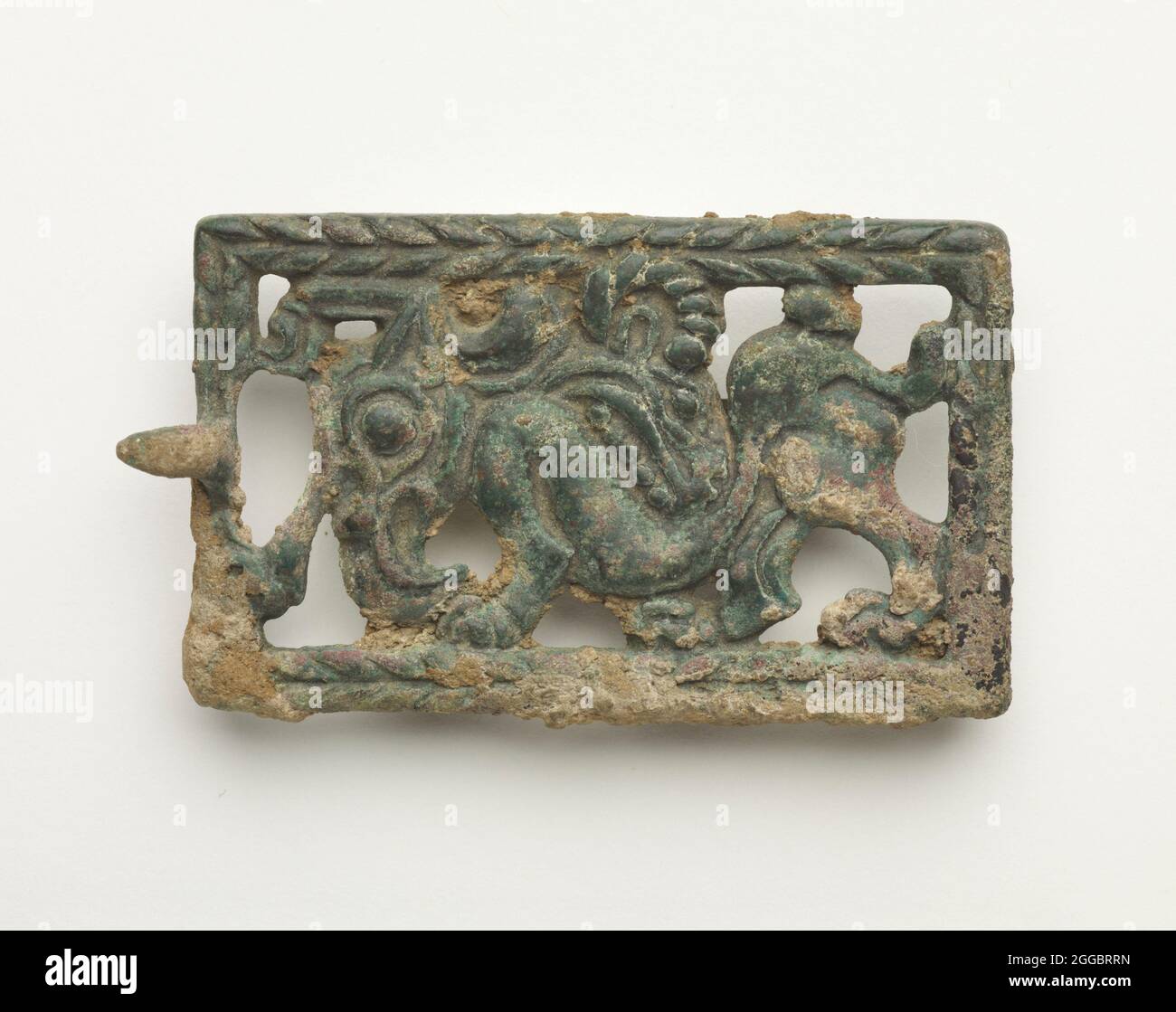 Belt plaque, Han dynasty, 206 BCE-220 CE. Stock Photohttps://www.alamy.com/image-license-details/?v=1https://www.alamy.com/belt-plaque-han-dynasty-206-bce-220-ce-image440353865.html
Belt plaque, Han dynasty, 206 BCE-220 CE. Stock Photohttps://www.alamy.com/image-license-details/?v=1https://www.alamy.com/belt-plaque-han-dynasty-206-bce-220-ce-image440353865.htmlRM2GGBRRN–Belt plaque, Han dynasty, 206 BCE-220 CE.
 Staff Finial with Bell Ring and Bird China Han dynasty (206 BCE–220 CE) View more. Staff Finial with Bell Ring and Bird. China. Nephrite. Han dynasty (206 BCE–220 CE). Jade Stock Photohttps://www.alamy.com/image-license-details/?v=1https://www.alamy.com/staff-finial-with-bell-ring-and-bird-china-han-dynasty-206-bce220-ce-view-more-staff-finial-with-bell-ring-and-bird-china-nephrite-han-dynasty-206-bce220-ce-jade-image569497109.html
Staff Finial with Bell Ring and Bird China Han dynasty (206 BCE–220 CE) View more. Staff Finial with Bell Ring and Bird. China. Nephrite. Han dynasty (206 BCE–220 CE). Jade Stock Photohttps://www.alamy.com/image-license-details/?v=1https://www.alamy.com/staff-finial-with-bell-ring-and-bird-china-han-dynasty-206-bce220-ce-view-more-staff-finial-with-bell-ring-and-bird-china-nephrite-han-dynasty-206-bce220-ce-jade-image569497109.htmlRM2T2ERAD–Staff Finial with Bell Ring and Bird China Han dynasty (206 BCE–220 CE) View more. Staff Finial with Bell Ring and Bird. China. Nephrite. Han dynasty (206 BCE–220 CE). Jade
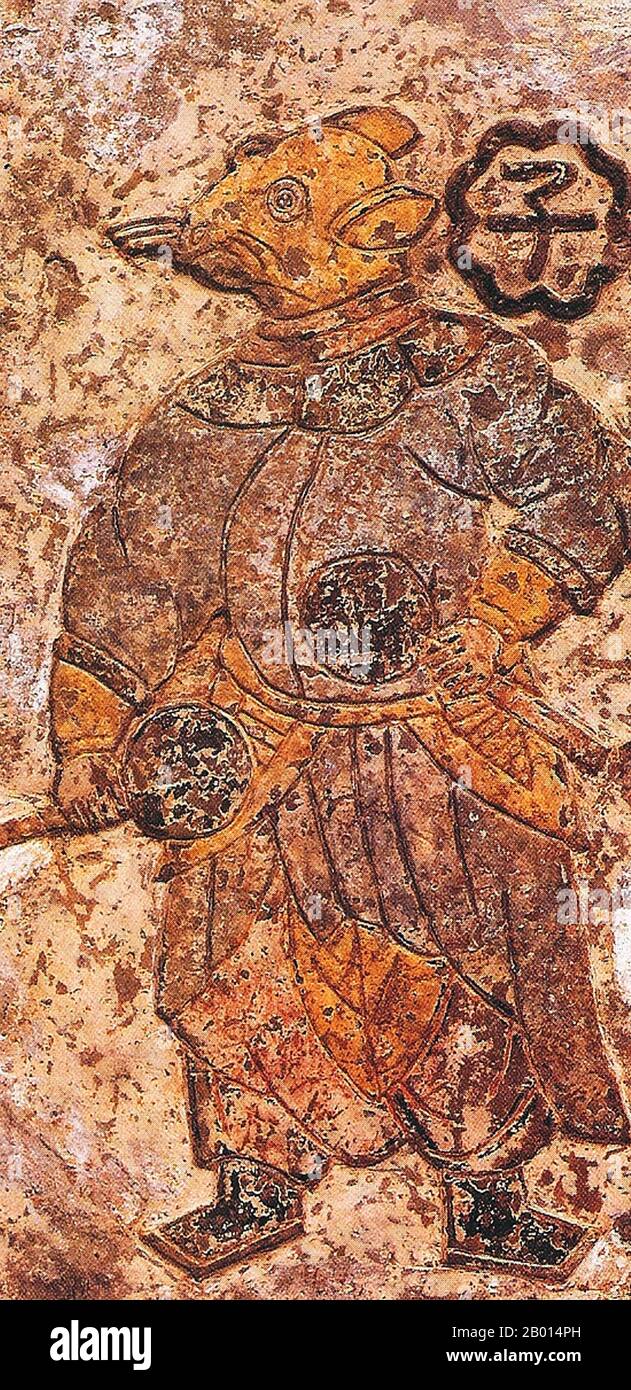 China: Guardian Deity of Midnight, ceramic tile painting, Han Dynasty (202 BCE - 220 CE). Painting on a ceramic tile from the Chinese Han Dynasty. This figure, wearing Han Dynasty robes, represents the Guardian Spirit of Midnight (from 11 pm to 1 am). Stock Photohttps://www.alamy.com/image-license-details/?v=1https://www.alamy.com/china-guardian-deity-of-midnight-ceramic-tile-painting-han-dynasty-202-bce-220-ce-painting-on-a-ceramic-tile-from-the-chinese-han-dynasty-this-figure-wearing-han-dynasty-robes-represents-the-guardian-spirit-of-midnight-from-11-pm-to-1-am-image344233081.html
China: Guardian Deity of Midnight, ceramic tile painting, Han Dynasty (202 BCE - 220 CE). Painting on a ceramic tile from the Chinese Han Dynasty. This figure, wearing Han Dynasty robes, represents the Guardian Spirit of Midnight (from 11 pm to 1 am). Stock Photohttps://www.alamy.com/image-license-details/?v=1https://www.alamy.com/china-guardian-deity-of-midnight-ceramic-tile-painting-han-dynasty-202-bce-220-ce-painting-on-a-ceramic-tile-from-the-chinese-han-dynasty-this-figure-wearing-han-dynasty-robes-represents-the-guardian-spirit-of-midnight-from-11-pm-to-1-am-image344233081.htmlRM2B014PH–China: Guardian Deity of Midnight, ceramic tile painting, Han Dynasty (202 BCE - 220 CE). Painting on a ceramic tile from the Chinese Han Dynasty. This figure, wearing Han Dynasty robes, represents the Guardian Spirit of Midnight (from 11 pm to 1 am).
 Bowl, 206 BCE - 220 CE, 4 3/8 x 8 x 8 in. (11.11 x 20.32 x 20.32 cm), Bronze, China, 3rd century BCE - 3rd century CE Stock Photohttps://www.alamy.com/image-license-details/?v=1https://www.alamy.com/bowl-206-bce-220-ce-4-38-x-8-x-8-in-1111-x-2032-x-2032-cm-bronze-china-3rd-century-bce-3rd-century-ce-image573495031.html
Bowl, 206 BCE - 220 CE, 4 3/8 x 8 x 8 in. (11.11 x 20.32 x 20.32 cm), Bronze, China, 3rd century BCE - 3rd century CE Stock Photohttps://www.alamy.com/image-license-details/?v=1https://www.alamy.com/bowl-206-bce-220-ce-4-38-x-8-x-8-in-1111-x-2032-x-2032-cm-bronze-china-3rd-century-bce-3rd-century-ce-image573495031.htmlRM2T90XNB–Bowl, 206 BCE - 220 CE, 4 3/8 x 8 x 8 in. (11.11 x 20.32 x 20.32 cm), Bronze, China, 3rd century BCE - 3rd century CE
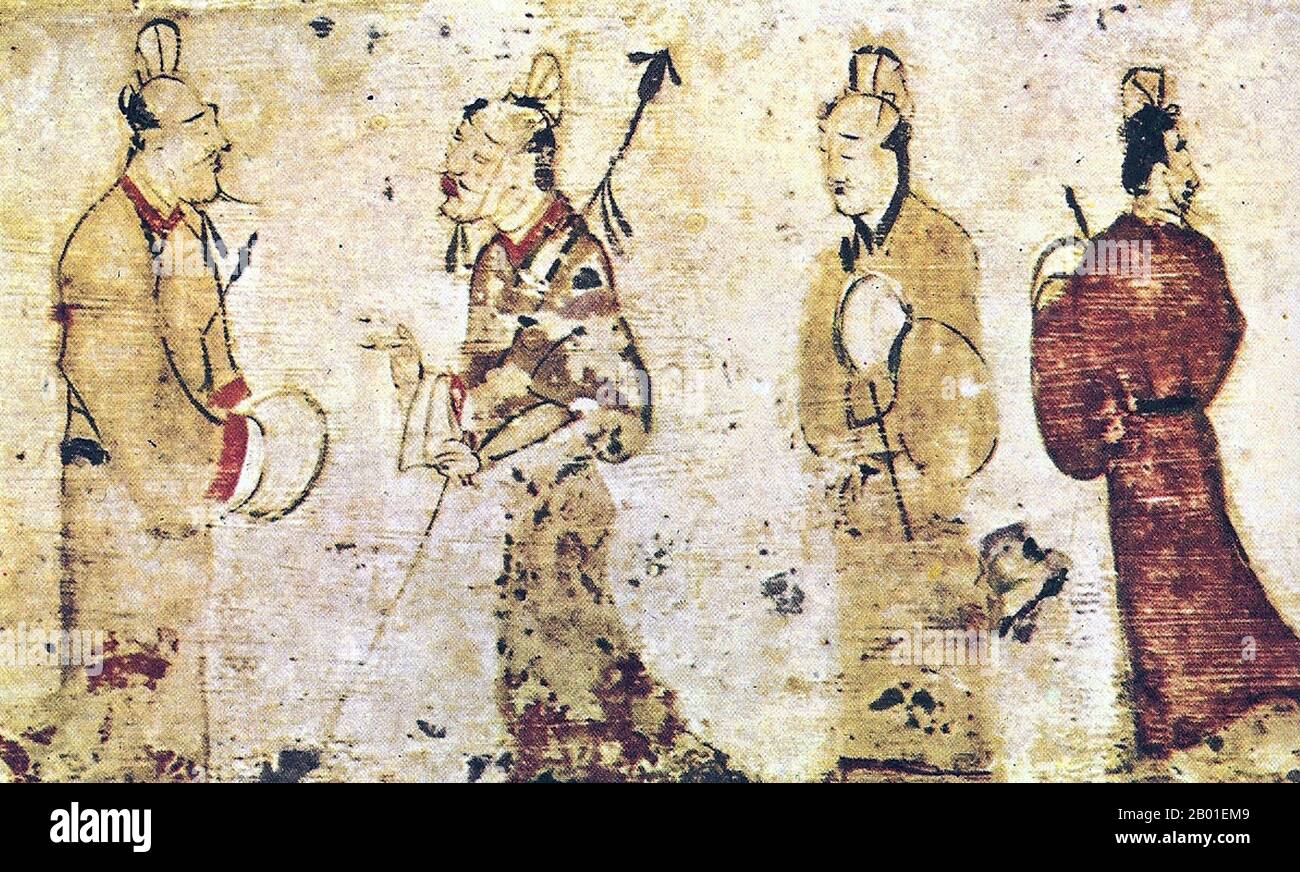 China: Two gentlemen engrossed in conversation while two others look on. Handscroll painting from a tomb near Luoyang, Henan province, dated to the Eastern Han Dynasty (25-220 CE). The Han Dynasty (206 BCE - 220 CE) was the second imperial dynasty of China, preceded by the Qin Dynasty (221-207 BCE) and succeeded by the Three Kingdoms (220-280 CE). It was founded by the peasant rebel leader Liu Bang, known posthumously as Emperor Gaozu of Han. It was briefly interrupted by the Xin Dynasty (9-23 CE) of the former regent Wang Mang. This interregnum separates the Han into two periods. Stock Photohttps://www.alamy.com/image-license-details/?v=1https://www.alamy.com/china-two-gentlemen-engrossed-in-conversation-while-two-others-look-on-handscroll-painting-from-a-tomb-near-luoyang-henan-province-dated-to-the-eastern-han-dynasty-25-220-ce-the-han-dynasty-206-bce-220-ce-was-the-second-imperial-dynasty-of-china-preceded-by-the-qin-dynasty-221-207-bce-and-succeeded-by-the-three-kingdoms-220-280-ce-it-was-founded-by-the-peasant-rebel-leader-liu-bang-known-posthumously-as-emperor-gaozu-of-han-it-was-briefly-interrupted-by-the-xin-dynasty-9-23-ce-of-the-former-regent-wang-mang-this-interregnum-separates-the-han-into-two-periods-image344240857.html
China: Two gentlemen engrossed in conversation while two others look on. Handscroll painting from a tomb near Luoyang, Henan province, dated to the Eastern Han Dynasty (25-220 CE). The Han Dynasty (206 BCE - 220 CE) was the second imperial dynasty of China, preceded by the Qin Dynasty (221-207 BCE) and succeeded by the Three Kingdoms (220-280 CE). It was founded by the peasant rebel leader Liu Bang, known posthumously as Emperor Gaozu of Han. It was briefly interrupted by the Xin Dynasty (9-23 CE) of the former regent Wang Mang. This interregnum separates the Han into two periods. Stock Photohttps://www.alamy.com/image-license-details/?v=1https://www.alamy.com/china-two-gentlemen-engrossed-in-conversation-while-two-others-look-on-handscroll-painting-from-a-tomb-near-luoyang-henan-province-dated-to-the-eastern-han-dynasty-25-220-ce-the-han-dynasty-206-bce-220-ce-was-the-second-imperial-dynasty-of-china-preceded-by-the-qin-dynasty-221-207-bce-and-succeeded-by-the-three-kingdoms-220-280-ce-it-was-founded-by-the-peasant-rebel-leader-liu-bang-known-posthumously-as-emperor-gaozu-of-han-it-was-briefly-interrupted-by-the-xin-dynasty-9-23-ce-of-the-former-regent-wang-mang-this-interregnum-separates-the-han-into-two-periods-image344240857.htmlRM2B01EM9–China: Two gentlemen engrossed in conversation while two others look on. Handscroll painting from a tomb near Luoyang, Henan province, dated to the Eastern Han Dynasty (25-220 CE). The Han Dynasty (206 BCE - 220 CE) was the second imperial dynasty of China, preceded by the Qin Dynasty (221-207 BCE) and succeeded by the Three Kingdoms (220-280 CE). It was founded by the peasant rebel leader Liu Bang, known posthumously as Emperor Gaozu of Han. It was briefly interrupted by the Xin Dynasty (9-23 CE) of the former regent Wang Mang. This interregnum separates the Han into two periods.
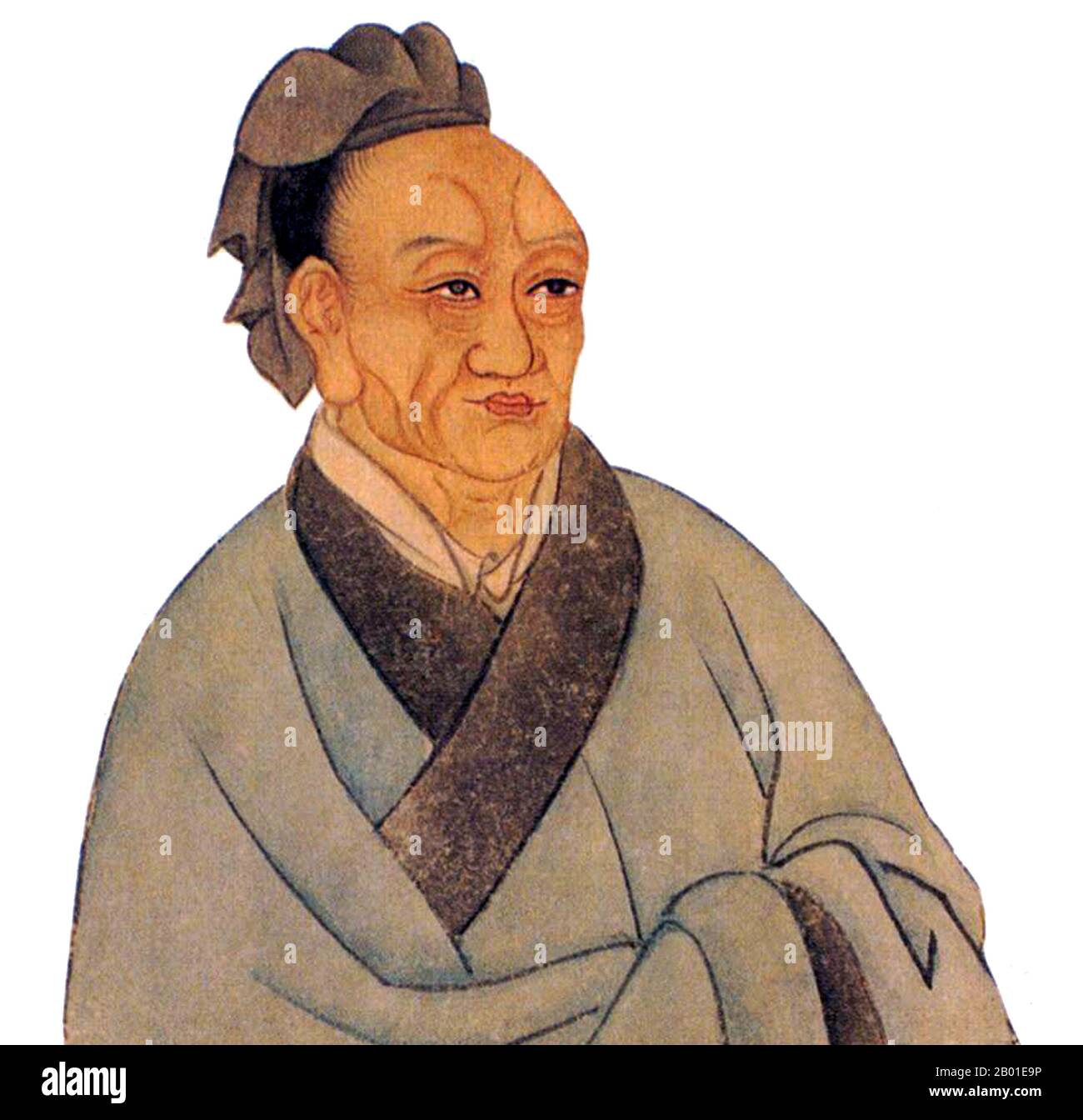 China: Sima Qian (c. 145-86 BCE), Father of Chinese historiography and 'Grand Historian' of China, early Han Dynasty (206 BCE - 220 CE). Sima Qian (Wade-Giles: Ssu-ma Ch'ien) was a Prefect of the Grand Scribes (太史公) of the Han Dynasty. He is regarded as the father of Chinese historiography for his highly praised work, Records of the Grand Historian, a 'Jizhuanti'-style general history of China, covering more than two thousand years from the Yellow Emperor to Emperor Wu of Han. His definitive work laid the foundation for later Chinese historiography. Stock Photohttps://www.alamy.com/image-license-details/?v=1https://www.alamy.com/china-sima-qian-c-145-86-bce-father-of-chinese-historiography-and-grand-historian-of-china-early-han-dynasty-206-bce-220-ce-sima-qian-wade-giles-ssu-ma-chien-was-a-prefect-of-the-grand-scribes-of-the-han-dynasty-he-is-regarded-as-the-father-of-chinese-historiography-for-his-highly-praised-work-records-of-the-grand-historian-a-jizhuanti-style-general-history-of-china-covering-more-than-two-thousand-years-from-the-yellow-emperor-to-emperor-wu-of-han-his-definitive-work-laid-the-foundation-for-later-chinese-historiography-image344240562.html
China: Sima Qian (c. 145-86 BCE), Father of Chinese historiography and 'Grand Historian' of China, early Han Dynasty (206 BCE - 220 CE). Sima Qian (Wade-Giles: Ssu-ma Ch'ien) was a Prefect of the Grand Scribes (太史公) of the Han Dynasty. He is regarded as the father of Chinese historiography for his highly praised work, Records of the Grand Historian, a 'Jizhuanti'-style general history of China, covering more than two thousand years from the Yellow Emperor to Emperor Wu of Han. His definitive work laid the foundation for later Chinese historiography. Stock Photohttps://www.alamy.com/image-license-details/?v=1https://www.alamy.com/china-sima-qian-c-145-86-bce-father-of-chinese-historiography-and-grand-historian-of-china-early-han-dynasty-206-bce-220-ce-sima-qian-wade-giles-ssu-ma-chien-was-a-prefect-of-the-grand-scribes-of-the-han-dynasty-he-is-regarded-as-the-father-of-chinese-historiography-for-his-highly-praised-work-records-of-the-grand-historian-a-jizhuanti-style-general-history-of-china-covering-more-than-two-thousand-years-from-the-yellow-emperor-to-emperor-wu-of-han-his-definitive-work-laid-the-foundation-for-later-chinese-historiography-image344240562.htmlRM2B01E9P–China: Sima Qian (c. 145-86 BCE), Father of Chinese historiography and 'Grand Historian' of China, early Han Dynasty (206 BCE - 220 CE). Sima Qian (Wade-Giles: Ssu-ma Ch'ien) was a Prefect of the Grand Scribes (太史公) of the Han Dynasty. He is regarded as the father of Chinese historiography for his highly praised work, Records of the Grand Historian, a 'Jizhuanti'-style general history of China, covering more than two thousand years from the Yellow Emperor to Emperor Wu of Han. His definitive work laid the foundation for later Chinese historiography.
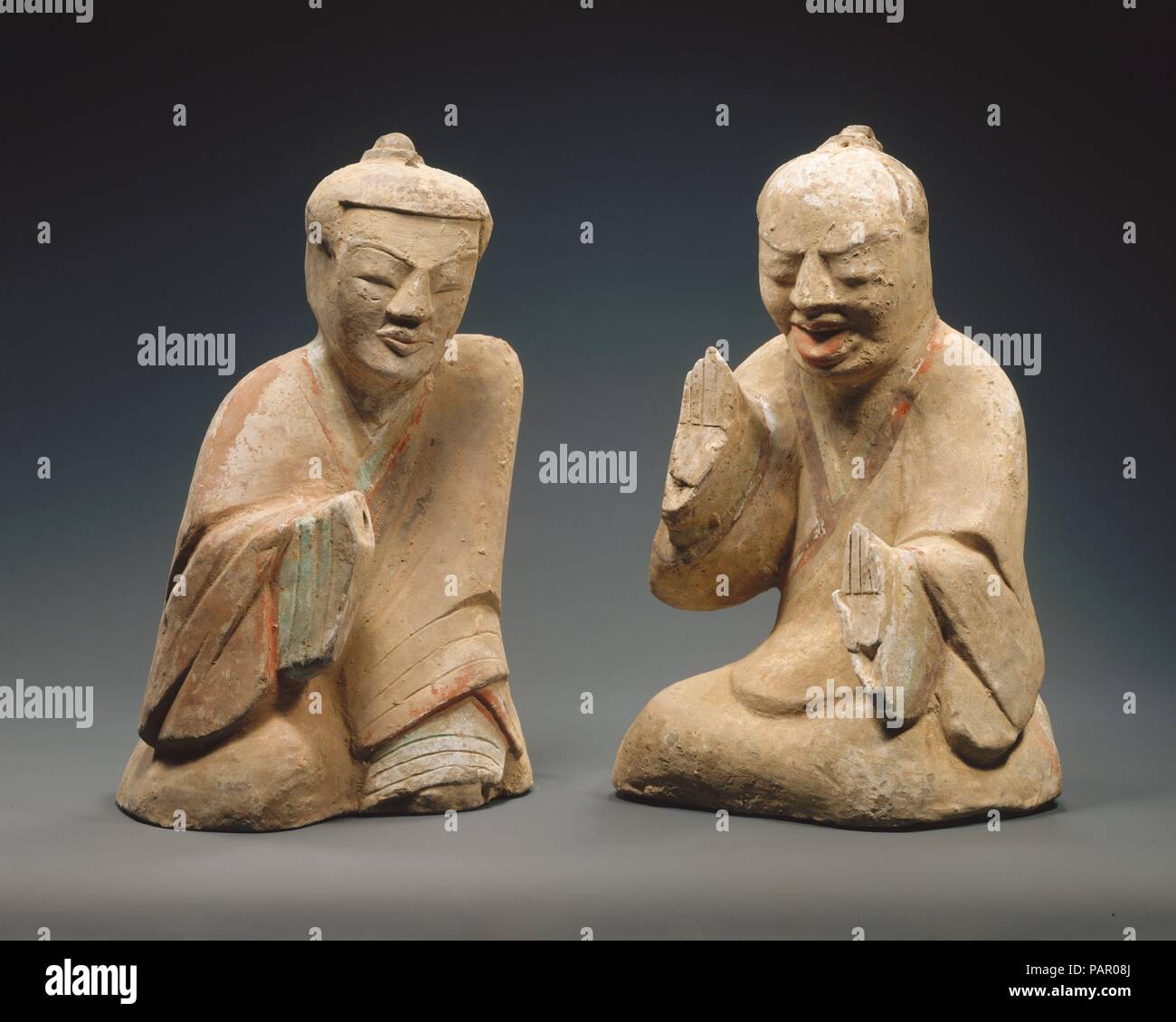 Pair of Seated Figures Playing Liubo. Culture: China. Dimensions: a: H. 13 13/16 in. (35.1 cm); b: H. 13 5/8 in. (34.6 cm). Date: 1st century B.C.-1st century A.D.. Both written records and archaeological finds attest to the popularity of the game of liubo (sometimes translated 'six rods') during the Han dynasty. A board divided into roads, and twelve pieces (six for each players) and dice thrown to determine moves, constitute the basic equipment for the game. It is thought the pattern on the board has cosmological significance illustrative of earlier traditions of divinatory casting. Museum: Stock Photohttps://www.alamy.com/image-license-details/?v=1https://www.alamy.com/pair-of-seated-figures-playing-liubo-culture-china-dimensions-a-h-13-1316-in-351-cm-b-h-13-58-in-346-cm-date-1st-century-bc-1st-century-ad-both-written-records-and-archaeological-finds-attest-to-the-popularity-of-the-game-of-liubo-sometimes-translated-six-rods-during-the-han-dynasty-a-board-divided-into-roads-and-twelve-pieces-six-for-each-players-and-dice-thrown-to-determine-moves-constitute-the-basic-equipment-for-the-game-it-is-thought-the-pattern-on-the-board-has-cosmological-significance-illustrative-of-earlier-traditions-of-divinatory-casting-museum-image213176114.html
Pair of Seated Figures Playing Liubo. Culture: China. Dimensions: a: H. 13 13/16 in. (35.1 cm); b: H. 13 5/8 in. (34.6 cm). Date: 1st century B.C.-1st century A.D.. Both written records and archaeological finds attest to the popularity of the game of liubo (sometimes translated 'six rods') during the Han dynasty. A board divided into roads, and twelve pieces (six for each players) and dice thrown to determine moves, constitute the basic equipment for the game. It is thought the pattern on the board has cosmological significance illustrative of earlier traditions of divinatory casting. Museum: Stock Photohttps://www.alamy.com/image-license-details/?v=1https://www.alamy.com/pair-of-seated-figures-playing-liubo-culture-china-dimensions-a-h-13-1316-in-351-cm-b-h-13-58-in-346-cm-date-1st-century-bc-1st-century-ad-both-written-records-and-archaeological-finds-attest-to-the-popularity-of-the-game-of-liubo-sometimes-translated-six-rods-during-the-han-dynasty-a-board-divided-into-roads-and-twelve-pieces-six-for-each-players-and-dice-thrown-to-determine-moves-constitute-the-basic-equipment-for-the-game-it-is-thought-the-pattern-on-the-board-has-cosmological-significance-illustrative-of-earlier-traditions-of-divinatory-casting-museum-image213176114.htmlRMPAR08J–Pair of Seated Figures Playing Liubo. Culture: China. Dimensions: a: H. 13 13/16 in. (35.1 cm); b: H. 13 5/8 in. (34.6 cm). Date: 1st century B.C.-1st century A.D.. Both written records and archaeological finds attest to the popularity of the game of liubo (sometimes translated 'six rods') during the Han dynasty. A board divided into roads, and twelve pieces (six for each players) and dice thrown to determine moves, constitute the basic equipment for the game. It is thought the pattern on the board has cosmological significance illustrative of earlier traditions of divinatory casting. Museum:
RM2B01D78–China: The Kizilgah Beacon Tower west of Kuqa, Xinjiang Province. The Kizilgah Beacon Tower is about 6km west of Kuqa. This imposing structure, dating from the Han Dynasty (206 BCE - 220 CE), marks an antique Chinese garrison point on the former Northern Silk Road.
 WASHINGTON DC, United States — The Late Eastern Zhou and Han Dynasties Gallery at the Arthur M. Sackler Gallery in Washington DC. This exhibit showcases artifacts from two pivotal periods in ancient Chinese history, spanning from approximately 500 BCE to 220 CE, offering visitors insights into the artistic, cultural, and technological developments of early imperial China. Stock Photohttps://www.alamy.com/image-license-details/?v=1https://www.alamy.com/washington-dc-united-states-the-late-eastern-zhou-and-han-dynasties-gallery-at-the-arthur-m-sackler-gallery-in-washington-dc-this-exhibit-showcases-artifacts-from-two-pivotal-periods-in-ancient-chinese-history-spanning-from-approximately-500-bce-to-220-ce-offering-visitors-insights-into-the-artistic-cultural-and-technological-developments-of-early-imperial-china-image622400527.html
WASHINGTON DC, United States — The Late Eastern Zhou and Han Dynasties Gallery at the Arthur M. Sackler Gallery in Washington DC. This exhibit showcases artifacts from two pivotal periods in ancient Chinese history, spanning from approximately 500 BCE to 220 CE, offering visitors insights into the artistic, cultural, and technological developments of early imperial China. Stock Photohttps://www.alamy.com/image-license-details/?v=1https://www.alamy.com/washington-dc-united-states-the-late-eastern-zhou-and-han-dynasties-gallery-at-the-arthur-m-sackler-gallery-in-washington-dc-this-exhibit-showcases-artifacts-from-two-pivotal-periods-in-ancient-chinese-history-spanning-from-approximately-500-bce-to-220-ce-offering-visitors-insights-into-the-artistic-cultural-and-technological-developments-of-early-imperial-china-image622400527.htmlRM2Y4GP67–WASHINGTON DC, United States — The Late Eastern Zhou and Han Dynasties Gallery at the Arthur M. Sackler Gallery in Washington DC. This exhibit showcases artifacts from two pivotal periods in ancient Chinese history, spanning from approximately 500 BCE to 220 CE, offering visitors insights into the artistic, cultural, and technological developments of early imperial China.
 Belt plaque, Han dynasty, 206 BCE-220 CE. Stock Photohttps://www.alamy.com/image-license-details/?v=1https://www.alamy.com/belt-plaque-han-dynasty-206-bce-220-ce-image440353861.html
Belt plaque, Han dynasty, 206 BCE-220 CE. Stock Photohttps://www.alamy.com/image-license-details/?v=1https://www.alamy.com/belt-plaque-han-dynasty-206-bce-220-ce-image440353861.htmlRM2GGBRRH–Belt plaque, Han dynasty, 206 BCE-220 CE.
 Pendant in the Form of a Reclining Cow, 206 BCE - 220 CE, 1 x 2 in. (2.54 x 5.08 cm), Blue-green jade, China, 3rd century BCE - 3rd century CE Stock Photohttps://www.alamy.com/image-license-details/?v=1https://www.alamy.com/pendant-in-the-form-of-a-reclining-cow-206-bce-220-ce-1-x-2-in-254-x-508-cm-blue-green-jade-china-3rd-century-bce-3rd-century-ce-image573518526.html
Pendant in the Form of a Reclining Cow, 206 BCE - 220 CE, 1 x 2 in. (2.54 x 5.08 cm), Blue-green jade, China, 3rd century BCE - 3rd century CE Stock Photohttps://www.alamy.com/image-license-details/?v=1https://www.alamy.com/pendant-in-the-form-of-a-reclining-cow-206-bce-220-ce-1-x-2-in-254-x-508-cm-blue-green-jade-china-3rd-century-bce-3rd-century-ce-image573518526.htmlRM2T920ME–Pendant in the Form of a Reclining Cow, 206 BCE - 220 CE, 1 x 2 in. (2.54 x 5.08 cm), Blue-green jade, China, 3rd century BCE - 3rd century CE
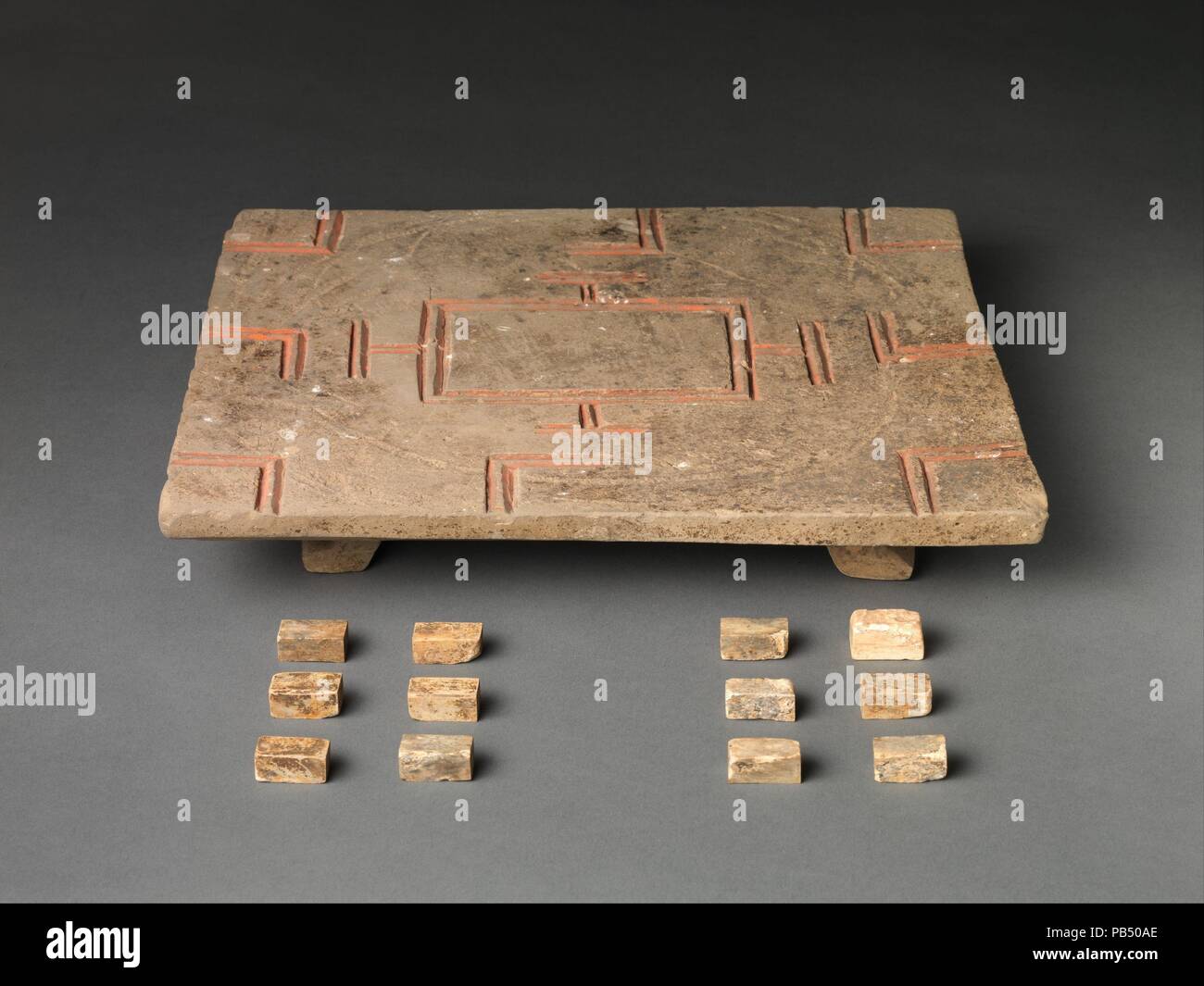 Liubo Board and Pieces. Culture: China. Dimensions: L. 14 1/4 in. (36.2 cm); W. 12 3/8 in. (31.4 cm); H. 2 in. (5.1 cm). Date: 1st century B.C.-1st century A.D.. A popular game in the Han dynasty, liubo involves two players who gamble using dice, counters, gaming pieces, and a marked board. These figures, captured in a dramatic moment, embody the wish for the continuation of life in the tomb. Museum: Metropolitan Museum of Art, New York, USA. Stock Photohttps://www.alamy.com/image-license-details/?v=1https://www.alamy.com/liubo-board-and-pieces-culture-china-dimensions-l-14-14-in-362-cm-w-12-38-in-314-cm-h-2-in-51-cm-date-1st-century-bc-1st-century-ad-a-popular-game-in-the-han-dynasty-liubo-involves-two-players-who-gamble-using-dice-counters-gaming-pieces-and-a-marked-board-these-figures-captured-in-a-dramatic-moment-embody-the-wish-for-the-continuation-of-life-in-the-tomb-museum-metropolitan-museum-of-art-new-york-usa-image213395686.html
Liubo Board and Pieces. Culture: China. Dimensions: L. 14 1/4 in. (36.2 cm); W. 12 3/8 in. (31.4 cm); H. 2 in. (5.1 cm). Date: 1st century B.C.-1st century A.D.. A popular game in the Han dynasty, liubo involves two players who gamble using dice, counters, gaming pieces, and a marked board. These figures, captured in a dramatic moment, embody the wish for the continuation of life in the tomb. Museum: Metropolitan Museum of Art, New York, USA. Stock Photohttps://www.alamy.com/image-license-details/?v=1https://www.alamy.com/liubo-board-and-pieces-culture-china-dimensions-l-14-14-in-362-cm-w-12-38-in-314-cm-h-2-in-51-cm-date-1st-century-bc-1st-century-ad-a-popular-game-in-the-han-dynasty-liubo-involves-two-players-who-gamble-using-dice-counters-gaming-pieces-and-a-marked-board-these-figures-captured-in-a-dramatic-moment-embody-the-wish-for-the-continuation-of-life-in-the-tomb-museum-metropolitan-museum-of-art-new-york-usa-image213395686.htmlRMPB50AE–Liubo Board and Pieces. Culture: China. Dimensions: L. 14 1/4 in. (36.2 cm); W. 12 3/8 in. (31.4 cm); H. 2 in. (5.1 cm). Date: 1st century B.C.-1st century A.D.. A popular game in the Han dynasty, liubo involves two players who gamble using dice, counters, gaming pieces, and a marked board. These figures, captured in a dramatic moment, embody the wish for the continuation of life in the tomb. Museum: Metropolitan Museum of Art, New York, USA.
RM2B01D75–China: The Kizilgah Beacon Tower west of Kuqa, Xinjiang Province. The Kizilgah Beacon Tower is about 6km west of Kuqa. This imposing structure, dating from the Han Dynasty (206 BCE - 220 CE), marks an antique Chinese garrison point on the former Northern Silk Road.
 Belt hook, Han dynasty, 206 BCE-220 CE. Stock Photohttps://www.alamy.com/image-license-details/?v=1https://www.alamy.com/belt-hook-han-dynasty-206-bce-220-ce-image440353863.html
Belt hook, Han dynasty, 206 BCE-220 CE. Stock Photohttps://www.alamy.com/image-license-details/?v=1https://www.alamy.com/belt-hook-han-dynasty-206-bce-220-ce-image440353863.htmlRM2GGBRRK–Belt hook, Han dynasty, 206 BCE-220 CE.
 Xi Pendant, 206 BCE - 220 CE, 2 x 7/8 in. (5.08 x 2.22 cm), White translucent jade with marbled brown striations, China, 3rd century BCE - 3rd century CE Stock Photohttps://www.alamy.com/image-license-details/?v=1https://www.alamy.com/xi-pendant-206-bce-220-ce-2-x-78-in-508-x-222-cm-white-translucent-jade-with-marbled-brown-striations-china-3rd-century-bce-3rd-century-ce-image573479098.html
Xi Pendant, 206 BCE - 220 CE, 2 x 7/8 in. (5.08 x 2.22 cm), White translucent jade with marbled brown striations, China, 3rd century BCE - 3rd century CE Stock Photohttps://www.alamy.com/image-license-details/?v=1https://www.alamy.com/xi-pendant-206-bce-220-ce-2-x-78-in-508-x-222-cm-white-translucent-jade-with-marbled-brown-striations-china-3rd-century-bce-3rd-century-ce-image573479098.htmlRM2T906CA–Xi Pendant, 206 BCE - 220 CE, 2 x 7/8 in. (5.08 x 2.22 cm), White translucent jade with marbled brown striations, China, 3rd century BCE - 3rd century CE
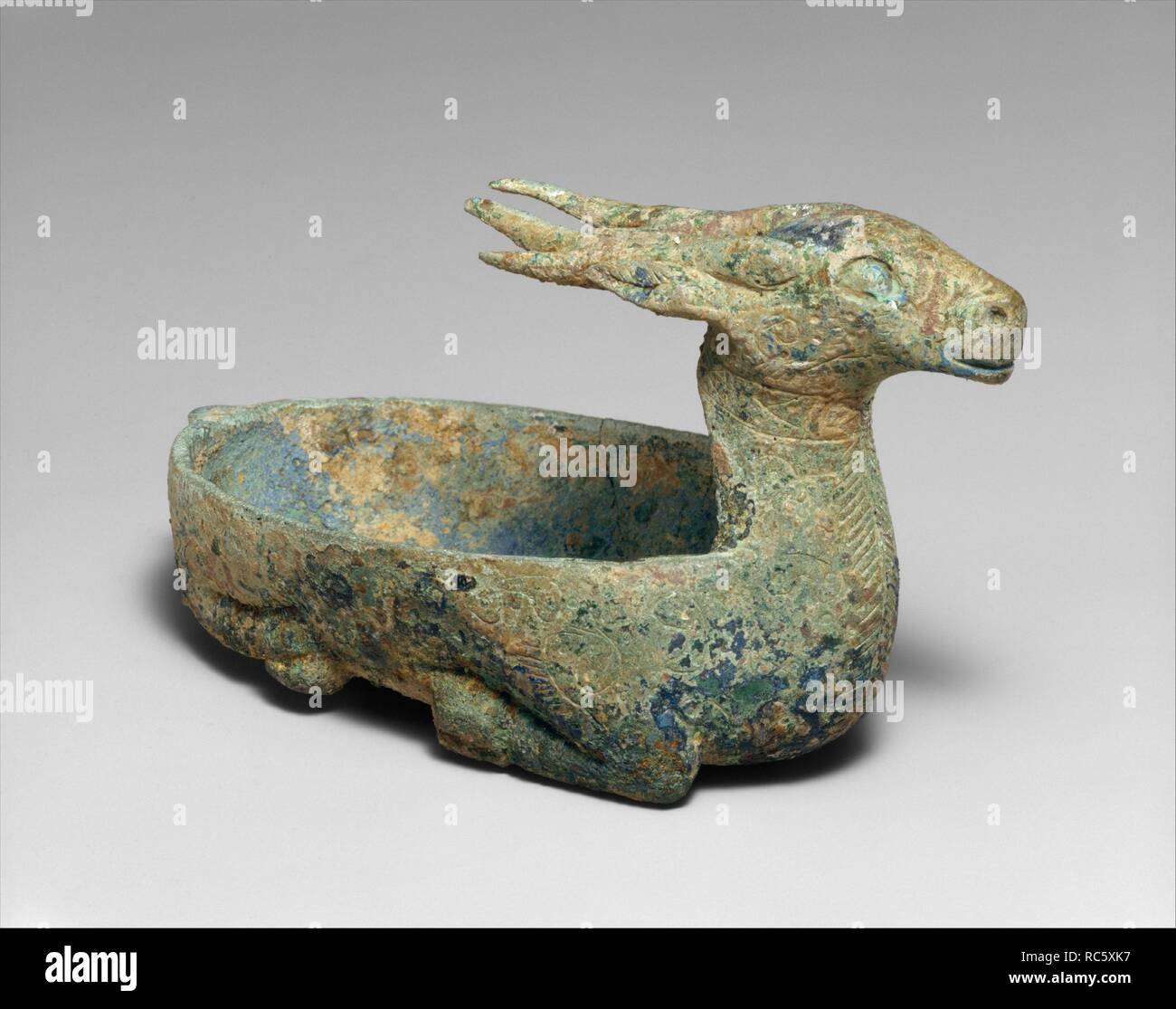 Mat Weight in the Shape of a Doe. Culture: China. Dimensions: H. 2 7/8 in. (7.3 cm); W. 2 3/8 in. (6 cm); D. 4 5/8 in. (11.7 cm). Date: 1st century B.C.-1st century A.D.. A low bed, small table, and screen were often the only furnishings in a Han-dynasty room. The floors were generally covered with mats kept in place with weights in the shape of single animals, fighting beasts, or entertainers. Comparable deer-shaped weights excavated in north China are inlaid with marine shells, suggesting that the back of this was once similarly filled. Museum: Metropolitan Museum of Art, New York, USA. Stock Photohttps://www.alamy.com/image-license-details/?v=1https://www.alamy.com/mat-weight-in-the-shape-of-a-doe-culture-china-dimensions-h-2-78-in-73-cm-w-2-38-in-6-cm-d-4-58-in-117-cm-date-1st-century-bc-1st-century-ad-a-low-bed-small-table-and-screen-were-often-the-only-furnishings-in-a-han-dynasty-room-the-floors-were-generally-covered-with-mats-kept-in-place-with-weights-in-the-shape-of-single-animals-fighting-beasts-or-entertainers-comparable-deer-shaped-weights-excavated-in-north-china-are-inlaid-with-marine-shells-suggesting-that-the-back-of-this-was-once-similarly-filled-museum-metropolitan-museum-of-art-new-york-usa-image231241339.html
Mat Weight in the Shape of a Doe. Culture: China. Dimensions: H. 2 7/8 in. (7.3 cm); W. 2 3/8 in. (6 cm); D. 4 5/8 in. (11.7 cm). Date: 1st century B.C.-1st century A.D.. A low bed, small table, and screen were often the only furnishings in a Han-dynasty room. The floors were generally covered with mats kept in place with weights in the shape of single animals, fighting beasts, or entertainers. Comparable deer-shaped weights excavated in north China are inlaid with marine shells, suggesting that the back of this was once similarly filled. Museum: Metropolitan Museum of Art, New York, USA. Stock Photohttps://www.alamy.com/image-license-details/?v=1https://www.alamy.com/mat-weight-in-the-shape-of-a-doe-culture-china-dimensions-h-2-78-in-73-cm-w-2-38-in-6-cm-d-4-58-in-117-cm-date-1st-century-bc-1st-century-ad-a-low-bed-small-table-and-screen-were-often-the-only-furnishings-in-a-han-dynasty-room-the-floors-were-generally-covered-with-mats-kept-in-place-with-weights-in-the-shape-of-single-animals-fighting-beasts-or-entertainers-comparable-deer-shaped-weights-excavated-in-north-china-are-inlaid-with-marine-shells-suggesting-that-the-back-of-this-was-once-similarly-filled-museum-metropolitan-museum-of-art-new-york-usa-image231241339.htmlRMRC5XK7–Mat Weight in the Shape of a Doe. Culture: China. Dimensions: H. 2 7/8 in. (7.3 cm); W. 2 3/8 in. (6 cm); D. 4 5/8 in. (11.7 cm). Date: 1st century B.C.-1st century A.D.. A low bed, small table, and screen were often the only furnishings in a Han-dynasty room. The floors were generally covered with mats kept in place with weights in the shape of single animals, fighting beasts, or entertainers. Comparable deer-shaped weights excavated in north China are inlaid with marine shells, suggesting that the back of this was once similarly filled. Museum: Metropolitan Museum of Art, New York, USA.
RM2B01D76–China: The Kizilgah Beacon Tower west of Kuqa, Xinjiang Province. The Kizilgah Beacon Tower is about 6km west of Kuqa. This imposing structure, dating from the Han Dynasty (206 BCE - 220 CE), marks an antique Chinese garrison point on the former Northern Silk Road.
 China: A shave in the sun, Kashgar, Xinjiang Province. The earliest mention of Kashgar occurs when a Chinese Han Dynasty (206 BCE – 220 CE) envoy traveled the Northern Silk Road to explore lands to the west. Another early mention of Kashgar is during the Former Han (also known as the Western Han Dynasty), when in 76 BCE the Chinese conquered the Xiongnu, Yutian (Khotan), Sulei (Kashgar), and a group of states in the Tarim basin almost up to the foot of the Tian Shan mountains. Stock Photohttps://www.alamy.com/image-license-details/?v=1https://www.alamy.com/china-a-shave-in-the-sun-kashgar-xinjiang-province-the-earliest-mention-of-kashgar-occurs-when-a-chinese-han-dynasty-206-bce-220-ce-envoy-traveled-the-northern-silk-road-to-explore-lands-to-the-west-another-early-mention-of-kashgar-is-during-the-former-han-also-known-as-the-western-han-dynasty-when-in-76-bce-the-chinese-conquered-the-xiongnu-yutian-khotan-sulei-kashgar-and-a-group-of-states-in-the-tarim-basin-almost-up-to-the-foot-of-the-tian-shan-mountains-image344239450.html
China: A shave in the sun, Kashgar, Xinjiang Province. The earliest mention of Kashgar occurs when a Chinese Han Dynasty (206 BCE – 220 CE) envoy traveled the Northern Silk Road to explore lands to the west. Another early mention of Kashgar is during the Former Han (also known as the Western Han Dynasty), when in 76 BCE the Chinese conquered the Xiongnu, Yutian (Khotan), Sulei (Kashgar), and a group of states in the Tarim basin almost up to the foot of the Tian Shan mountains. Stock Photohttps://www.alamy.com/image-license-details/?v=1https://www.alamy.com/china-a-shave-in-the-sun-kashgar-xinjiang-province-the-earliest-mention-of-kashgar-occurs-when-a-chinese-han-dynasty-206-bce-220-ce-envoy-traveled-the-northern-silk-road-to-explore-lands-to-the-west-another-early-mention-of-kashgar-is-during-the-former-han-also-known-as-the-western-han-dynasty-when-in-76-bce-the-chinese-conquered-the-xiongnu-yutian-khotan-sulei-kashgar-and-a-group-of-states-in-the-tarim-basin-almost-up-to-the-foot-of-the-tian-shan-mountains-image344239450.htmlRM2B01CX2–China: A shave in the sun, Kashgar, Xinjiang Province. The earliest mention of Kashgar occurs when a Chinese Han Dynasty (206 BCE – 220 CE) envoy traveled the Northern Silk Road to explore lands to the west. Another early mention of Kashgar is during the Former Han (also known as the Western Han Dynasty), when in 76 BCE the Chinese conquered the Xiongnu, Yutian (Khotan), Sulei (Kashgar), and a group of states in the Tarim basin almost up to the foot of the Tian Shan mountains.
 A standing deer, Han dynasty, 206 BCE-220 CE. Stock Photohttps://www.alamy.com/image-license-details/?v=1https://www.alamy.com/a-standing-deer-han-dynasty-206-bce-220-ce-image440353860.html
A standing deer, Han dynasty, 206 BCE-220 CE. Stock Photohttps://www.alamy.com/image-license-details/?v=1https://www.alamy.com/a-standing-deer-han-dynasty-206-bce-220-ce-image440353860.htmlRM2GGBRRG–A standing deer, Han dynasty, 206 BCE-220 CE.
 Wei Scabbard Buckle, 206 BCE - 220 CE, 2 15/16 x 1/2 in. (7.46 x 1.27 cm), Opaque yellow jade with brown markings, China, 3rd century BCE - 3rd century CE Stock Photohttps://www.alamy.com/image-license-details/?v=1https://www.alamy.com/wei-scabbard-buckle-206-bce-220-ce-2-1516-x-12-in-746-x-127-cm-opaque-yellow-jade-with-brown-markings-china-3rd-century-bce-3rd-century-ce-image573479677.html
Wei Scabbard Buckle, 206 BCE - 220 CE, 2 15/16 x 1/2 in. (7.46 x 1.27 cm), Opaque yellow jade with brown markings, China, 3rd century BCE - 3rd century CE Stock Photohttps://www.alamy.com/image-license-details/?v=1https://www.alamy.com/wei-scabbard-buckle-206-bce-220-ce-2-1516-x-12-in-746-x-127-cm-opaque-yellow-jade-with-brown-markings-china-3rd-century-bce-3rd-century-ce-image573479677.htmlRM2T90751–Wei Scabbard Buckle, 206 BCE - 220 CE, 2 15/16 x 1/2 in. (7.46 x 1.27 cm), Opaque yellow jade with brown markings, China, 3rd century BCE - 3rd century CE
 Dancer and Musicians. Culture: China. Dimensions: (a) dancer: H. 5 1/4 in. (13.3 cm); W. 5 1/4 in. (13.3 cm); D. 2 1/4 in. (5.7 cm) (c) musician: H. 5 3/8 in. (13.7 cm); W. 4 1/4 in. (10.8 cm); W. 4 3/8 in. (11.1 cm). Date: 1st century B.C.-1st century A.D.. Pottery figures of entertainers often accompanied the deceased in the afterlife. Here, a female dancer performs the popular 'seven dish dance,' tapping dishes with her feet as musicians play a zither and clap. One dish, the only surviving example of the original set of seven, rests under the dancer's left foot. Museum: Metropolitan Museu Stock Photohttps://www.alamy.com/image-license-details/?v=1https://www.alamy.com/dancer-and-musicians-culture-china-dimensions-a-dancer-h-5-14-in-133-cm-w-5-14-in-133-cm-d-2-14-in-57-cm-c-musician-h-5-38-in-137-cm-w-4-14-in-108-cm-w-4-38-in-111-cm-date-1st-century-bc-1st-century-ad-pottery-figures-of-entertainers-often-accompanied-the-deceased-in-the-afterlife-here-a-female-dancer-performs-the-popular-seven-dish-dance-tapping-dishes-with-her-feet-as-musicians-play-a-zither-and-clap-one-dish-the-only-surviving-example-of-the-original-set-of-seven-rests-under-the-dancers-left-foot-museum-metropolitan-museu-image213207366.html
Dancer and Musicians. Culture: China. Dimensions: (a) dancer: H. 5 1/4 in. (13.3 cm); W. 5 1/4 in. (13.3 cm); D. 2 1/4 in. (5.7 cm) (c) musician: H. 5 3/8 in. (13.7 cm); W. 4 1/4 in. (10.8 cm); W. 4 3/8 in. (11.1 cm). Date: 1st century B.C.-1st century A.D.. Pottery figures of entertainers often accompanied the deceased in the afterlife. Here, a female dancer performs the popular 'seven dish dance,' tapping dishes with her feet as musicians play a zither and clap. One dish, the only surviving example of the original set of seven, rests under the dancer's left foot. Museum: Metropolitan Museu Stock Photohttps://www.alamy.com/image-license-details/?v=1https://www.alamy.com/dancer-and-musicians-culture-china-dimensions-a-dancer-h-5-14-in-133-cm-w-5-14-in-133-cm-d-2-14-in-57-cm-c-musician-h-5-38-in-137-cm-w-4-14-in-108-cm-w-4-38-in-111-cm-date-1st-century-bc-1st-century-ad-pottery-figures-of-entertainers-often-accompanied-the-deceased-in-the-afterlife-here-a-female-dancer-performs-the-popular-seven-dish-dance-tapping-dishes-with-her-feet-as-musicians-play-a-zither-and-clap-one-dish-the-only-surviving-example-of-the-original-set-of-seven-rests-under-the-dancers-left-foot-museum-metropolitan-museu-image213207366.htmlRMPATC4P–Dancer and Musicians. Culture: China. Dimensions: (a) dancer: H. 5 1/4 in. (13.3 cm); W. 5 1/4 in. (13.3 cm); D. 2 1/4 in. (5.7 cm) (c) musician: H. 5 3/8 in. (13.7 cm); W. 4 1/4 in. (10.8 cm); W. 4 3/8 in. (11.1 cm). Date: 1st century B.C.-1st century A.D.. Pottery figures of entertainers often accompanied the deceased in the afterlife. Here, a female dancer performs the popular 'seven dish dance,' tapping dishes with her feet as musicians play a zither and clap. One dish, the only surviving example of the original set of seven, rests under the dancer's left foot. Museum: Metropolitan Museu
 China: A shave in the sun, Kashgar, Xinjiang Province. The earliest mention of Kashgar occurs when a Chinese Han Dynasty (206 BCE – 220 CE) envoy traveled the Northern Silk Road to explore lands to the west. Another early mention of Kashgar is during the Former Han (also known as the Western Han Dynasty), when in 76 BCE the Chinese conquered the Xiongnu, Yutian (Khotan), Sulei (Kashgar), and a group of states in the Tarim basin almost up to the foot of the Tian Shan mountains. Stock Photohttps://www.alamy.com/image-license-details/?v=1https://www.alamy.com/china-a-shave-in-the-sun-kashgar-xinjiang-province-the-earliest-mention-of-kashgar-occurs-when-a-chinese-han-dynasty-206-bce-220-ce-envoy-traveled-the-northern-silk-road-to-explore-lands-to-the-west-another-early-mention-of-kashgar-is-during-the-former-han-also-known-as-the-western-han-dynasty-when-in-76-bce-the-chinese-conquered-the-xiongnu-yutian-khotan-sulei-kashgar-and-a-group-of-states-in-the-tarim-basin-almost-up-to-the-foot-of-the-tian-shan-mountains-image344239452.html
China: A shave in the sun, Kashgar, Xinjiang Province. The earliest mention of Kashgar occurs when a Chinese Han Dynasty (206 BCE – 220 CE) envoy traveled the Northern Silk Road to explore lands to the west. Another early mention of Kashgar is during the Former Han (also known as the Western Han Dynasty), when in 76 BCE the Chinese conquered the Xiongnu, Yutian (Khotan), Sulei (Kashgar), and a group of states in the Tarim basin almost up to the foot of the Tian Shan mountains. Stock Photohttps://www.alamy.com/image-license-details/?v=1https://www.alamy.com/china-a-shave-in-the-sun-kashgar-xinjiang-province-the-earliest-mention-of-kashgar-occurs-when-a-chinese-han-dynasty-206-bce-220-ce-envoy-traveled-the-northern-silk-road-to-explore-lands-to-the-west-another-early-mention-of-kashgar-is-during-the-former-han-also-known-as-the-western-han-dynasty-when-in-76-bce-the-chinese-conquered-the-xiongnu-yutian-khotan-sulei-kashgar-and-a-group-of-states-in-the-tarim-basin-almost-up-to-the-foot-of-the-tian-shan-mountains-image344239452.htmlRM2B01CX4–China: A shave in the sun, Kashgar, Xinjiang Province. The earliest mention of Kashgar occurs when a Chinese Han Dynasty (206 BCE – 220 CE) envoy traveled the Northern Silk Road to explore lands to the west. Another early mention of Kashgar is during the Former Han (also known as the Western Han Dynasty), when in 76 BCE the Chinese conquered the Xiongnu, Yutian (Khotan), Sulei (Kashgar), and a group of states in the Tarim basin almost up to the foot of the Tian Shan mountains.
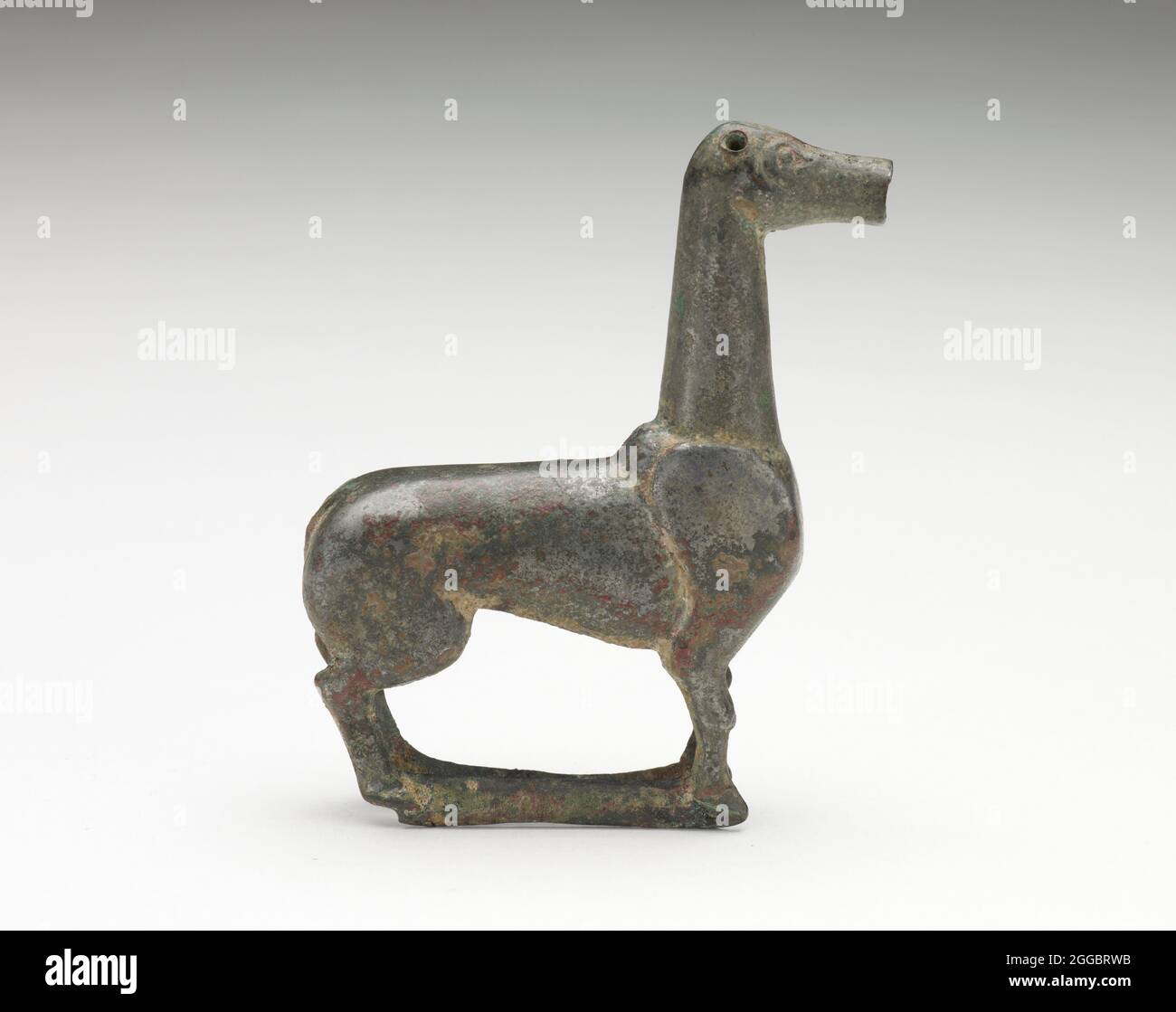 A standing deer, Han dynasty, 206 BCE-220 CE. Stock Photohttps://www.alamy.com/image-license-details/?v=1https://www.alamy.com/a-standing-deer-han-dynasty-206-bce-220-ce-image440353911.html
A standing deer, Han dynasty, 206 BCE-220 CE. Stock Photohttps://www.alamy.com/image-license-details/?v=1https://www.alamy.com/a-standing-deer-han-dynasty-206-bce-220-ce-image440353911.htmlRM2GGBRWB–A standing deer, Han dynasty, 206 BCE-220 CE.
 Sword Pommel Jian Shou, 206 BCE - 220 CE, 1 7/8 x 3/16 in. (4.76 x 0.48 cm), Translucent tan jade with brown markings, China, 3rd century BCE - 3rd century CE Stock Photohttps://www.alamy.com/image-license-details/?v=1https://www.alamy.com/sword-pommel-jian-shou-206-bce-220-ce-1-78-x-316-in-476-x-048-cm-translucent-tan-jade-with-brown-markings-china-3rd-century-bce-3rd-century-ce-image573516504.html
Sword Pommel Jian Shou, 206 BCE - 220 CE, 1 7/8 x 3/16 in. (4.76 x 0.48 cm), Translucent tan jade with brown markings, China, 3rd century BCE - 3rd century CE Stock Photohttps://www.alamy.com/image-license-details/?v=1https://www.alamy.com/sword-pommel-jian-shou-206-bce-220-ce-1-78-x-316-in-476-x-048-cm-translucent-tan-jade-with-brown-markings-china-3rd-century-bce-3rd-century-ce-image573516504.htmlRM2T91X48–Sword Pommel Jian Shou, 206 BCE - 220 CE, 1 7/8 x 3/16 in. (4.76 x 0.48 cm), Translucent tan jade with brown markings, China, 3rd century BCE - 3rd century CE
 China: A shave in the sun, Kashgar, Xinjiang Province. The earliest mention of Kashgar occurs when a Chinese Han Dynasty (206 BCE – 220 CE) envoy traveled the Northern Silk Road to explore lands to the west. Another early mention of Kashgar is during the Former Han (also known as the Western Han Dynasty), when in 76 BCE the Chinese conquered the Xiongnu, Yutian (Khotan), Sulei (Kashgar), and a group of states in the Tarim basin almost up to the foot of the Tian Shan mountains. Stock Photohttps://www.alamy.com/image-license-details/?v=1https://www.alamy.com/china-a-shave-in-the-sun-kashgar-xinjiang-province-the-earliest-mention-of-kashgar-occurs-when-a-chinese-han-dynasty-206-bce-220-ce-envoy-traveled-the-northern-silk-road-to-explore-lands-to-the-west-another-early-mention-of-kashgar-is-during-the-former-han-also-known-as-the-western-han-dynasty-when-in-76-bce-the-chinese-conquered-the-xiongnu-yutian-khotan-sulei-kashgar-and-a-group-of-states-in-the-tarim-basin-almost-up-to-the-foot-of-the-tian-shan-mountains-image344239451.html
China: A shave in the sun, Kashgar, Xinjiang Province. The earliest mention of Kashgar occurs when a Chinese Han Dynasty (206 BCE – 220 CE) envoy traveled the Northern Silk Road to explore lands to the west. Another early mention of Kashgar is during the Former Han (also known as the Western Han Dynasty), when in 76 BCE the Chinese conquered the Xiongnu, Yutian (Khotan), Sulei (Kashgar), and a group of states in the Tarim basin almost up to the foot of the Tian Shan mountains. Stock Photohttps://www.alamy.com/image-license-details/?v=1https://www.alamy.com/china-a-shave-in-the-sun-kashgar-xinjiang-province-the-earliest-mention-of-kashgar-occurs-when-a-chinese-han-dynasty-206-bce-220-ce-envoy-traveled-the-northern-silk-road-to-explore-lands-to-the-west-another-early-mention-of-kashgar-is-during-the-former-han-also-known-as-the-western-han-dynasty-when-in-76-bce-the-chinese-conquered-the-xiongnu-yutian-khotan-sulei-kashgar-and-a-group-of-states-in-the-tarim-basin-almost-up-to-the-foot-of-the-tian-shan-mountains-image344239451.htmlRM2B01CX3–China: A shave in the sun, Kashgar, Xinjiang Province. The earliest mention of Kashgar occurs when a Chinese Han Dynasty (206 BCE – 220 CE) envoy traveled the Northern Silk Road to explore lands to the west. Another early mention of Kashgar is during the Former Han (also known as the Western Han Dynasty), when in 76 BCE the Chinese conquered the Xiongnu, Yutian (Khotan), Sulei (Kashgar), and a group of states in the Tarim basin almost up to the foot of the Tian Shan mountains.
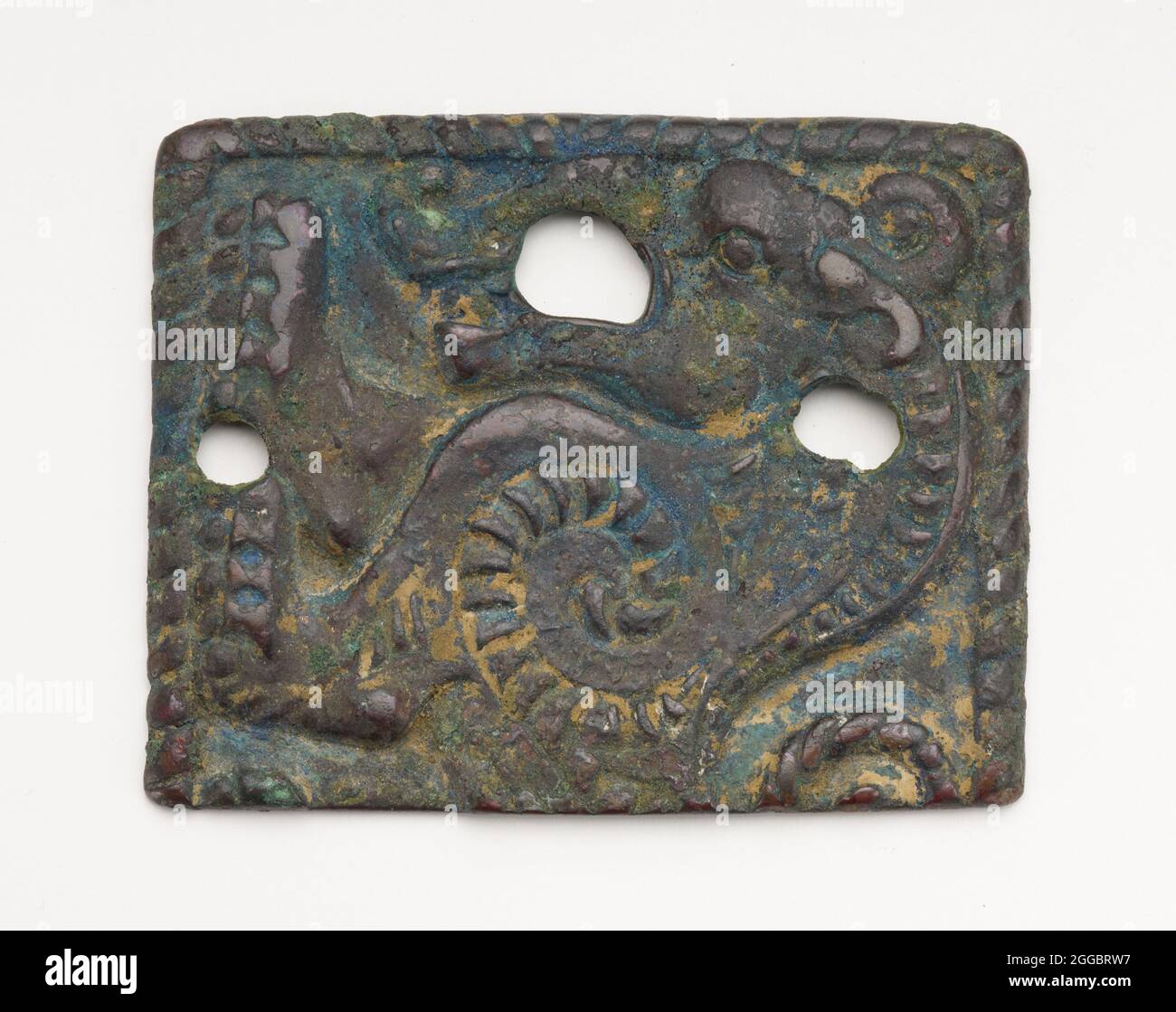 A pair of belt plaques, Han dynasty, 206 BCE-220 CE. Stock Photohttps://www.alamy.com/image-license-details/?v=1https://www.alamy.com/a-pair-of-belt-plaques-han-dynasty-206-bce-220-ce-image440353907.html
A pair of belt plaques, Han dynasty, 206 BCE-220 CE. Stock Photohttps://www.alamy.com/image-license-details/?v=1https://www.alamy.com/a-pair-of-belt-plaques-han-dynasty-206-bce-220-ce-image440353907.htmlRM2GGBRW7–A pair of belt plaques, Han dynasty, 206 BCE-220 CE.
 China: Confucius (Kong Zi, K'ung-tzu, K'ung-fu-tzu, 551– 479 BCE), celebrated Chinese philosopher of the Spring and Autumn Period. Black print portrait. The philosophy of Confucius emphasises personal and governmental morality, correctness of social relationships, justice and sincerity. These values gained prominence in China during the Han Dynasty(206 BC – 220 AD). Confucius' thoughts have been developed into a system of philosophy known as Confucianism. It was introduced to Europe by the Italian Jesuit Matteo Ricci, who was the first to Latinise the name as 'Confucius'. Stock Photohttps://www.alamy.com/image-license-details/?v=1https://www.alamy.com/china-confucius-kong-zi-kung-tzu-kung-fu-tzu-551-479-bce-celebrated-chinese-philosopher-of-the-spring-and-autumn-period-black-print-portrait-the-philosophy-of-confucius-emphasises-personal-and-governmental-morality-correctness-of-social-relationships-justice-and-sincerity-these-values-gained-prominence-in-china-during-the-han-dynasty206-bc-220-ad-confucius-thoughts-have-been-developed-into-a-system-of-philosophy-known-as-confucianism-it-was-introduced-to-europe-by-the-italian-jesuit-matteo-ricci-who-was-the-first-to-latinise-the-name-as-confucius-image344231267.html
China: Confucius (Kong Zi, K'ung-tzu, K'ung-fu-tzu, 551– 479 BCE), celebrated Chinese philosopher of the Spring and Autumn Period. Black print portrait. The philosophy of Confucius emphasises personal and governmental morality, correctness of social relationships, justice and sincerity. These values gained prominence in China during the Han Dynasty(206 BC – 220 AD). Confucius' thoughts have been developed into a system of philosophy known as Confucianism. It was introduced to Europe by the Italian Jesuit Matteo Ricci, who was the first to Latinise the name as 'Confucius'. Stock Photohttps://www.alamy.com/image-license-details/?v=1https://www.alamy.com/china-confucius-kong-zi-kung-tzu-kung-fu-tzu-551-479-bce-celebrated-chinese-philosopher-of-the-spring-and-autumn-period-black-print-portrait-the-philosophy-of-confucius-emphasises-personal-and-governmental-morality-correctness-of-social-relationships-justice-and-sincerity-these-values-gained-prominence-in-china-during-the-han-dynasty206-bc-220-ad-confucius-thoughts-have-been-developed-into-a-system-of-philosophy-known-as-confucianism-it-was-introduced-to-europe-by-the-italian-jesuit-matteo-ricci-who-was-the-first-to-latinise-the-name-as-confucius-image344231267.htmlRM2B012DR–China: Confucius (Kong Zi, K'ung-tzu, K'ung-fu-tzu, 551– 479 BCE), celebrated Chinese philosopher of the Spring and Autumn Period. Black print portrait. The philosophy of Confucius emphasises personal and governmental morality, correctness of social relationships, justice and sincerity. These values gained prominence in China during the Han Dynasty(206 BC – 220 AD). Confucius' thoughts have been developed into a system of philosophy known as Confucianism. It was introduced to Europe by the Italian Jesuit Matteo Ricci, who was the first to Latinise the name as 'Confucius'.
 Belt Hook, 206 BCE - 220 CE, 4 3/4 x 7/8 x 3/8 in. (12.07 x 2.22 x 0.95 cm), White jade, China, 3rd century BCE - 3rd century CE Stock Photohttps://www.alamy.com/image-license-details/?v=1https://www.alamy.com/belt-hook-206-bce-220-ce-4-34-x-78-x-38-in-1207-x-222-x-095-cm-white-jade-china-3rd-century-bce-3rd-century-ce-image573479998.html
Belt Hook, 206 BCE - 220 CE, 4 3/4 x 7/8 x 3/8 in. (12.07 x 2.22 x 0.95 cm), White jade, China, 3rd century BCE - 3rd century CE Stock Photohttps://www.alamy.com/image-license-details/?v=1https://www.alamy.com/belt-hook-206-bce-220-ce-4-34-x-78-x-38-in-1207-x-222-x-095-cm-white-jade-china-3rd-century-bce-3rd-century-ce-image573479998.htmlRM2T907GE–Belt Hook, 206 BCE - 220 CE, 4 3/4 x 7/8 x 3/8 in. (12.07 x 2.22 x 0.95 cm), White jade, China, 3rd century BCE - 3rd century CE
 Ornament in the form of a boar, Han dynasty, 206 BCE-220 CE. Stock Photohttps://www.alamy.com/image-license-details/?v=1https://www.alamy.com/ornament-in-the-form-of-a-boar-han-dynasty-206-bce-220-ce-image440353901.html
Ornament in the form of a boar, Han dynasty, 206 BCE-220 CE. Stock Photohttps://www.alamy.com/image-license-details/?v=1https://www.alamy.com/ornament-in-the-form-of-a-boar-han-dynasty-206-bce-220-ce-image440353901.htmlRM2GGBRW1–Ornament in the form of a boar, Han dynasty, 206 BCE-220 CE.
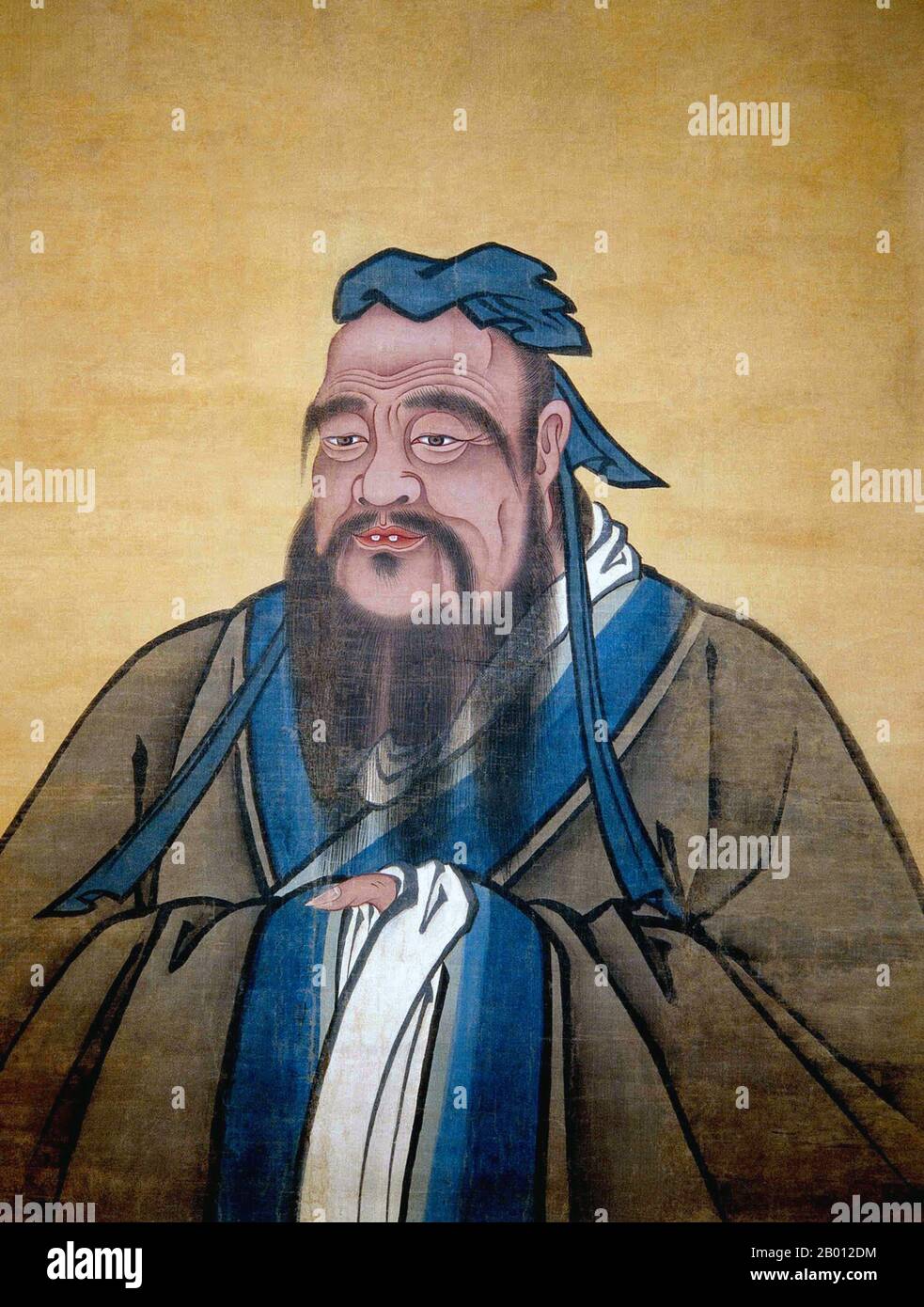 China: Confucius (Kong Zi, K'ung-tzu, K'ung-fu-tzu, 551– 479 BCE), celebrated Chinese philosopher of the Spring and Autumn Period. The philosophy of Confucius emphasises personal and governmental morality, correctness of social relationships, justice and sincerity. These values gained prominence in China during the Han Dynasty(206 BC – 220 AD). Confucius' thoughts have been developed into a system of philosophy known as Confucianism. It was introduced to Europe by the Italian Jesuit Matteo Ricci, who was the first to Latinise the name as 'Confucius'. Stock Photohttps://www.alamy.com/image-license-details/?v=1https://www.alamy.com/china-confucius-kong-zi-kung-tzu-kung-fu-tzu-551-479-bce-celebrated-chinese-philosopher-of-the-spring-and-autumn-period-the-philosophy-of-confucius-emphasises-personal-and-governmental-morality-correctness-of-social-relationships-justice-and-sincerity-these-values-gained-prominence-in-china-during-the-han-dynasty206-bc-220-ad-confucius-thoughts-have-been-developed-into-a-system-of-philosophy-known-as-confucianism-it-was-introduced-to-europe-by-the-italian-jesuit-matteo-ricci-who-was-the-first-to-latinise-the-name-as-confucius-image344231264.html
China: Confucius (Kong Zi, K'ung-tzu, K'ung-fu-tzu, 551– 479 BCE), celebrated Chinese philosopher of the Spring and Autumn Period. The philosophy of Confucius emphasises personal and governmental morality, correctness of social relationships, justice and sincerity. These values gained prominence in China during the Han Dynasty(206 BC – 220 AD). Confucius' thoughts have been developed into a system of philosophy known as Confucianism. It was introduced to Europe by the Italian Jesuit Matteo Ricci, who was the first to Latinise the name as 'Confucius'. Stock Photohttps://www.alamy.com/image-license-details/?v=1https://www.alamy.com/china-confucius-kong-zi-kung-tzu-kung-fu-tzu-551-479-bce-celebrated-chinese-philosopher-of-the-spring-and-autumn-period-the-philosophy-of-confucius-emphasises-personal-and-governmental-morality-correctness-of-social-relationships-justice-and-sincerity-these-values-gained-prominence-in-china-during-the-han-dynasty206-bc-220-ad-confucius-thoughts-have-been-developed-into-a-system-of-philosophy-known-as-confucianism-it-was-introduced-to-europe-by-the-italian-jesuit-matteo-ricci-who-was-the-first-to-latinise-the-name-as-confucius-image344231264.htmlRM2B012DM–China: Confucius (Kong Zi, K'ung-tzu, K'ung-fu-tzu, 551– 479 BCE), celebrated Chinese philosopher of the Spring and Autumn Period. The philosophy of Confucius emphasises personal and governmental morality, correctness of social relationships, justice and sincerity. These values gained prominence in China during the Han Dynasty(206 BC – 220 AD). Confucius' thoughts have been developed into a system of philosophy known as Confucianism. It was introduced to Europe by the Italian Jesuit Matteo Ricci, who was the first to Latinise the name as 'Confucius'.
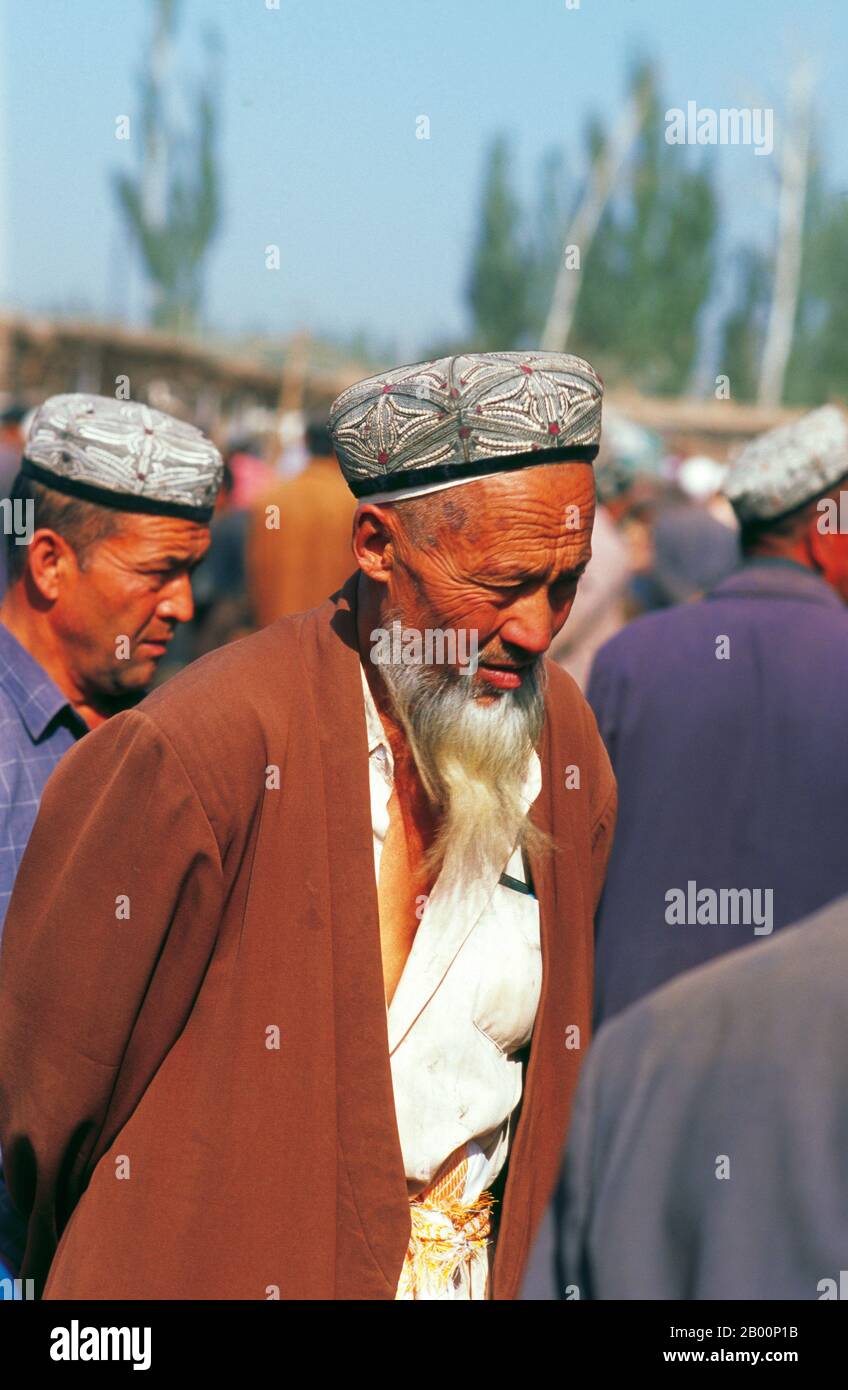 China: Elderly Uighur man at the Sunday Livestock Market, Kashgar, Xinjiang. The earliest mention of Kashgar occurs when a Chinese Han Dynasty (206 BCE – 220 CE) envoy traveled the Northern Silk Road to explore lands to the west. Another early mention of Kashgar is during the Former Han (also known as the Western Han Dynasty), when in 76 BCE the Chinese conquered the Xiongnu, Yutian (Khotan), Sulei (Kashgar), and a group of states in the Tarim basin almost up to the foot of the Tian Shan mountains. Stock Photohttps://www.alamy.com/image-license-details/?v=1https://www.alamy.com/china-elderly-uighur-man-at-the-sunday-livestock-market-kashgar-xinjiang-the-earliest-mention-of-kashgar-occurs-when-a-chinese-han-dynasty-206-bce-220-ce-envoy-traveled-the-northern-silk-road-to-explore-lands-to-the-west-another-early-mention-of-kashgar-is-during-the-former-han-also-known-as-the-western-han-dynasty-when-in-76-bce-the-chinese-conquered-the-xiongnu-yutian-khotan-sulei-kashgar-and-a-group-of-states-in-the-tarim-basin-almost-up-to-the-foot-of-the-tian-shan-mountains-image344224647.html
China: Elderly Uighur man at the Sunday Livestock Market, Kashgar, Xinjiang. The earliest mention of Kashgar occurs when a Chinese Han Dynasty (206 BCE – 220 CE) envoy traveled the Northern Silk Road to explore lands to the west. Another early mention of Kashgar is during the Former Han (also known as the Western Han Dynasty), when in 76 BCE the Chinese conquered the Xiongnu, Yutian (Khotan), Sulei (Kashgar), and a group of states in the Tarim basin almost up to the foot of the Tian Shan mountains. Stock Photohttps://www.alamy.com/image-license-details/?v=1https://www.alamy.com/china-elderly-uighur-man-at-the-sunday-livestock-market-kashgar-xinjiang-the-earliest-mention-of-kashgar-occurs-when-a-chinese-han-dynasty-206-bce-220-ce-envoy-traveled-the-northern-silk-road-to-explore-lands-to-the-west-another-early-mention-of-kashgar-is-during-the-former-han-also-known-as-the-western-han-dynasty-when-in-76-bce-the-chinese-conquered-the-xiongnu-yutian-khotan-sulei-kashgar-and-a-group-of-states-in-the-tarim-basin-almost-up-to-the-foot-of-the-tian-shan-mountains-image344224647.htmlRM2B00P1B–China: Elderly Uighur man at the Sunday Livestock Market, Kashgar, Xinjiang. The earliest mention of Kashgar occurs when a Chinese Han Dynasty (206 BCE – 220 CE) envoy traveled the Northern Silk Road to explore lands to the west. Another early mention of Kashgar is during the Former Han (also known as the Western Han Dynasty), when in 76 BCE the Chinese conquered the Xiongnu, Yutian (Khotan), Sulei (Kashgar), and a group of states in the Tarim basin almost up to the foot of the Tian Shan mountains.
 China: Woman awaiting alms at the 'Id gah Mosque, Kashgar, Xinjiang. The earliest mention of Kashgar occurs when a Chinese Han Dynasty (206 BCE – 220 CE) envoy traveled the Northern Silk Road to explore lands to the west. Another early mention of Kashgar is during the Former Han (also known as the Western Han Dynasty), when in 76 BCE the Chinese conquered the Xiongnu, Yutian (Khotan), Sulei (Kashgar), and a group of states in the Tarim basin almost up to the foot of the Tian Shan mountains. Stock Photohttps://www.alamy.com/image-license-details/?v=1https://www.alamy.com/china-woman-awaiting-alms-at-the-id-gah-mosque-kashgar-xinjiang-the-earliest-mention-of-kashgar-occurs-when-a-chinese-han-dynasty-206-bce-220-ce-envoy-traveled-the-northern-silk-road-to-explore-lands-to-the-west-another-early-mention-of-kashgar-is-during-the-former-han-also-known-as-the-western-han-dynasty-when-in-76-bce-the-chinese-conquered-the-xiongnu-yutian-khotan-sulei-kashgar-and-a-group-of-states-in-the-tarim-basin-almost-up-to-the-foot-of-the-tian-shan-mountains-image344224650.html
China: Woman awaiting alms at the 'Id gah Mosque, Kashgar, Xinjiang. The earliest mention of Kashgar occurs when a Chinese Han Dynasty (206 BCE – 220 CE) envoy traveled the Northern Silk Road to explore lands to the west. Another early mention of Kashgar is during the Former Han (also known as the Western Han Dynasty), when in 76 BCE the Chinese conquered the Xiongnu, Yutian (Khotan), Sulei (Kashgar), and a group of states in the Tarim basin almost up to the foot of the Tian Shan mountains. Stock Photohttps://www.alamy.com/image-license-details/?v=1https://www.alamy.com/china-woman-awaiting-alms-at-the-id-gah-mosque-kashgar-xinjiang-the-earliest-mention-of-kashgar-occurs-when-a-chinese-han-dynasty-206-bce-220-ce-envoy-traveled-the-northern-silk-road-to-explore-lands-to-the-west-another-early-mention-of-kashgar-is-during-the-former-han-also-known-as-the-western-han-dynasty-when-in-76-bce-the-chinese-conquered-the-xiongnu-yutian-khotan-sulei-kashgar-and-a-group-of-states-in-the-tarim-basin-almost-up-to-the-foot-of-the-tian-shan-mountains-image344224650.htmlRM2B00P1E–China: Woman awaiting alms at the 'Id gah Mosque, Kashgar, Xinjiang. The earliest mention of Kashgar occurs when a Chinese Han Dynasty (206 BCE – 220 CE) envoy traveled the Northern Silk Road to explore lands to the west. Another early mention of Kashgar is during the Former Han (also known as the Western Han Dynasty), when in 76 BCE the Chinese conquered the Xiongnu, Yutian (Khotan), Sulei (Kashgar), and a group of states in the Tarim basin almost up to the foot of the Tian Shan mountains.
 Rectangular Pendant, 206 BCE - 220 CE, 5 1/2 x 5/8 x 1/4 in. (13.97 x 1.59 x 0.56 cm), Green jade, China, 3rd century BCE - 3rd century CE Stock Photohttps://www.alamy.com/image-license-details/?v=1https://www.alamy.com/rectangular-pendant-206-bce-220-ce-5-12-x-58-x-14-in-1397-x-159-x-056-cm-green-jade-china-3rd-century-bce-3rd-century-ce-image573479343.html
Rectangular Pendant, 206 BCE - 220 CE, 5 1/2 x 5/8 x 1/4 in. (13.97 x 1.59 x 0.56 cm), Green jade, China, 3rd century BCE - 3rd century CE Stock Photohttps://www.alamy.com/image-license-details/?v=1https://www.alamy.com/rectangular-pendant-206-bce-220-ce-5-12-x-58-x-14-in-1397-x-159-x-056-cm-green-jade-china-3rd-century-bce-3rd-century-ce-image573479343.htmlRM2T906N3–Rectangular Pendant, 206 BCE - 220 CE, 5 1/2 x 5/8 x 1/4 in. (13.97 x 1.59 x 0.56 cm), Green jade, China, 3rd century BCE - 3rd century CE
 Ornament in the form of a seated person, Possibly Han dynasty, 206 BCE-220 CE. Stock Photohttps://www.alamy.com/image-license-details/?v=1https://www.alamy.com/ornament-in-the-form-of-a-seated-person-possibly-han-dynasty-206-bce-220-ce-image440353850.html
Ornament in the form of a seated person, Possibly Han dynasty, 206 BCE-220 CE. Stock Photohttps://www.alamy.com/image-license-details/?v=1https://www.alamy.com/ornament-in-the-form-of-a-seated-person-possibly-han-dynasty-206-bce-220-ce-image440353850.htmlRM2GGBRR6–Ornament in the form of a seated person, Possibly Han dynasty, 206 BCE-220 CE.
 China: Uighur watermelon vendors near the Animal Market, Kashgar, Xinjiang. The earliest mention of Kashgar occurs when a Chinese Han Dynasty (206 BCE – 220 CE) envoy traveled the Northern Silk Road to explore lands to the west. Another early mention of Kashgar is during the Former Han (also known as the Western Han Dynasty), when in 76 BCE the Chinese conquered the Xiongnu, Yutian (Khotan), Sulei (Kashgar), and a group of states in the Tarim basin almost up to the foot of the Tian Shan mountains. Stock Photohttps://www.alamy.com/image-license-details/?v=1https://www.alamy.com/china-uighur-watermelon-vendors-near-the-animal-market-kashgar-xinjiang-the-earliest-mention-of-kashgar-occurs-when-a-chinese-han-dynasty-206-bce-220-ce-envoy-traveled-the-northern-silk-road-to-explore-lands-to-the-west-another-early-mention-of-kashgar-is-during-the-former-han-also-known-as-the-western-han-dynasty-when-in-76-bce-the-chinese-conquered-the-xiongnu-yutian-khotan-sulei-kashgar-and-a-group-of-states-in-the-tarim-basin-almost-up-to-the-foot-of-the-tian-shan-mountains-image344224646.html
China: Uighur watermelon vendors near the Animal Market, Kashgar, Xinjiang. The earliest mention of Kashgar occurs when a Chinese Han Dynasty (206 BCE – 220 CE) envoy traveled the Northern Silk Road to explore lands to the west. Another early mention of Kashgar is during the Former Han (also known as the Western Han Dynasty), when in 76 BCE the Chinese conquered the Xiongnu, Yutian (Khotan), Sulei (Kashgar), and a group of states in the Tarim basin almost up to the foot of the Tian Shan mountains. Stock Photohttps://www.alamy.com/image-license-details/?v=1https://www.alamy.com/china-uighur-watermelon-vendors-near-the-animal-market-kashgar-xinjiang-the-earliest-mention-of-kashgar-occurs-when-a-chinese-han-dynasty-206-bce-220-ce-envoy-traveled-the-northern-silk-road-to-explore-lands-to-the-west-another-early-mention-of-kashgar-is-during-the-former-han-also-known-as-the-western-han-dynasty-when-in-76-bce-the-chinese-conquered-the-xiongnu-yutian-khotan-sulei-kashgar-and-a-group-of-states-in-the-tarim-basin-almost-up-to-the-foot-of-the-tian-shan-mountains-image344224646.htmlRM2B00P1A–China: Uighur watermelon vendors near the Animal Market, Kashgar, Xinjiang. The earliest mention of Kashgar occurs when a Chinese Han Dynasty (206 BCE – 220 CE) envoy traveled the Northern Silk Road to explore lands to the west. Another early mention of Kashgar is during the Former Han (also known as the Western Han Dynasty), when in 76 BCE the Chinese conquered the Xiongnu, Yutian (Khotan), Sulei (Kashgar), and a group of states in the Tarim basin almost up to the foot of the Tian Shan mountains.
 China: Elderly Uighur man outside the 'Id Gah Mosque, Kashgar, Xinjiang. The earliest mention of Kashgar occurs when a Chinese Han Dynasty (206 BCE – 220 CE) envoy traveled the Northern Silk Road to explore lands to the west. Another early mention of Kashgar is during the Former Han (also known as the Western Han Dynasty), when in 76 BCE the Chinese conquered the Xiongnu, Yutian (Khotan), Sulei (Kashgar), and a group of states in the Tarim basin almost up to the foot of the Tian Shan mountains. Stock Photohttps://www.alamy.com/image-license-details/?v=1https://www.alamy.com/china-elderly-uighur-man-outside-the-id-gah-mosque-kashgar-xinjiang-the-earliest-mention-of-kashgar-occurs-when-a-chinese-han-dynasty-206-bce-220-ce-envoy-traveled-the-northern-silk-road-to-explore-lands-to-the-west-another-early-mention-of-kashgar-is-during-the-former-han-also-known-as-the-western-han-dynasty-when-in-76-bce-the-chinese-conquered-the-xiongnu-yutian-khotan-sulei-kashgar-and-a-group-of-states-in-the-tarim-basin-almost-up-to-the-foot-of-the-tian-shan-mountains-image344224649.html
China: Elderly Uighur man outside the 'Id Gah Mosque, Kashgar, Xinjiang. The earliest mention of Kashgar occurs when a Chinese Han Dynasty (206 BCE – 220 CE) envoy traveled the Northern Silk Road to explore lands to the west. Another early mention of Kashgar is during the Former Han (also known as the Western Han Dynasty), when in 76 BCE the Chinese conquered the Xiongnu, Yutian (Khotan), Sulei (Kashgar), and a group of states in the Tarim basin almost up to the foot of the Tian Shan mountains. Stock Photohttps://www.alamy.com/image-license-details/?v=1https://www.alamy.com/china-elderly-uighur-man-outside-the-id-gah-mosque-kashgar-xinjiang-the-earliest-mention-of-kashgar-occurs-when-a-chinese-han-dynasty-206-bce-220-ce-envoy-traveled-the-northern-silk-road-to-explore-lands-to-the-west-another-early-mention-of-kashgar-is-during-the-former-han-also-known-as-the-western-han-dynasty-when-in-76-bce-the-chinese-conquered-the-xiongnu-yutian-khotan-sulei-kashgar-and-a-group-of-states-in-the-tarim-basin-almost-up-to-the-foot-of-the-tian-shan-mountains-image344224649.htmlRM2B00P1D–China: Elderly Uighur man outside the 'Id Gah Mosque, Kashgar, Xinjiang. The earliest mention of Kashgar occurs when a Chinese Han Dynasty (206 BCE – 220 CE) envoy traveled the Northern Silk Road to explore lands to the west. Another early mention of Kashgar is during the Former Han (also known as the Western Han Dynasty), when in 76 BCE the Chinese conquered the Xiongnu, Yutian (Khotan), Sulei (Kashgar), and a group of states in the Tarim basin almost up to the foot of the Tian Shan mountains.
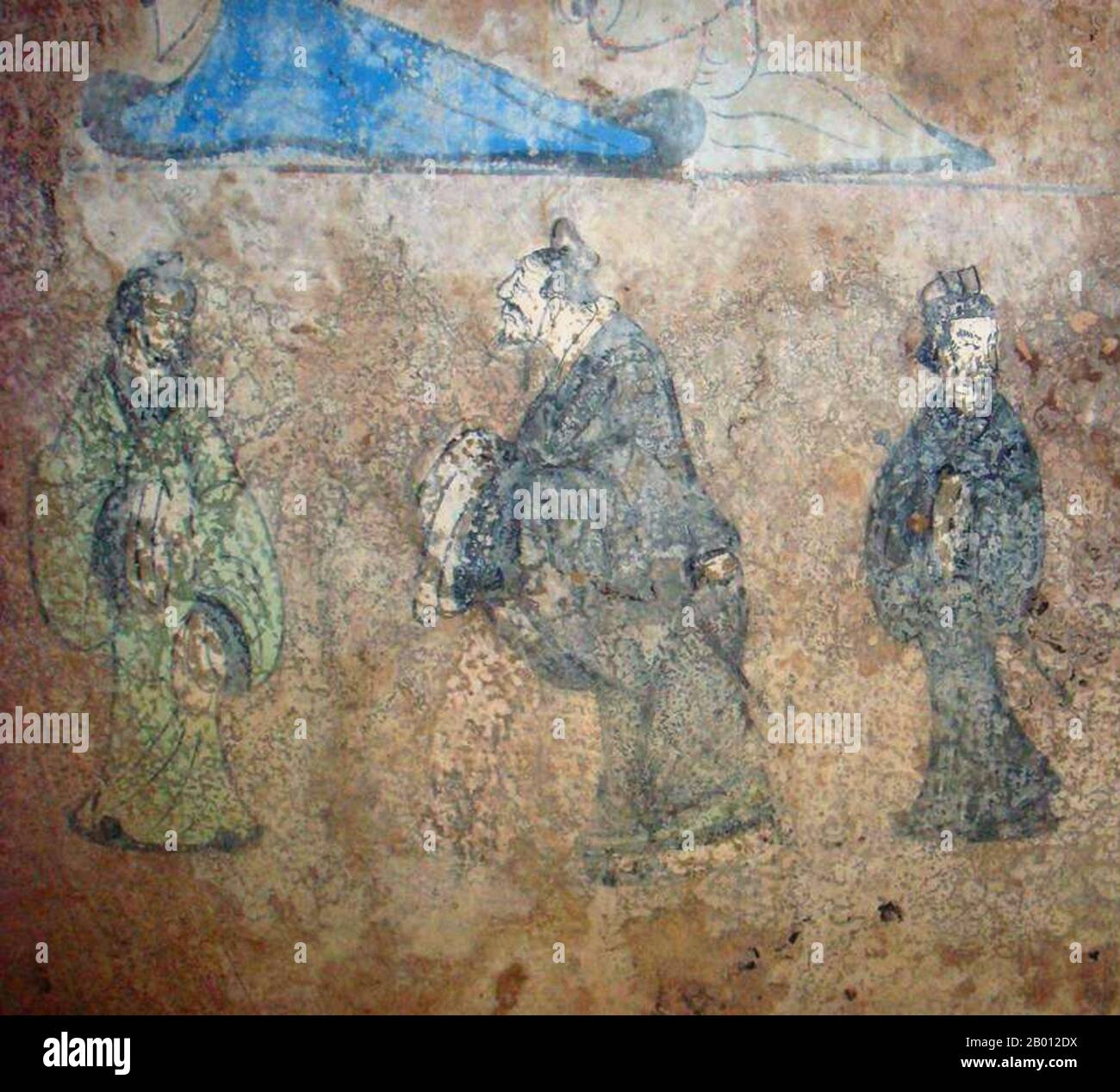 China: Laozi (Lao Tzu, c. 6th century BCE, left), meeting with Confucius (Kong Zi, K'ung-tzu, K'ung-fu-tzu, 551– 479 BCE) in a Han Dynasty (206 BCE– 220 CE) fresco from Dongping County, Shandong Province. The fresco, painted with blue, green, black and red colours is found on the walls of a tomb at an old residential yard in Dongping county, southwestern Shandong, and is estimated to be about 2,000 years old. Stock Photohttps://www.alamy.com/image-license-details/?v=1https://www.alamy.com/china-laozi-lao-tzu-c-6th-century-bce-left-meeting-with-confucius-kong-zi-kung-tzu-kung-fu-tzu-551-479-bce-in-a-han-dynasty-206-bce-220-ce-fresco-from-dongping-county-shandong-province-the-fresco-painted-with-blue-green-black-and-red-colours-is-found-on-the-walls-of-a-tomb-at-an-old-residential-yard-in-dongping-county-southwestern-shandong-and-is-estimated-to-be-about-2000-years-old-image344231270.html
China: Laozi (Lao Tzu, c. 6th century BCE, left), meeting with Confucius (Kong Zi, K'ung-tzu, K'ung-fu-tzu, 551– 479 BCE) in a Han Dynasty (206 BCE– 220 CE) fresco from Dongping County, Shandong Province. The fresco, painted with blue, green, black and red colours is found on the walls of a tomb at an old residential yard in Dongping county, southwestern Shandong, and is estimated to be about 2,000 years old. Stock Photohttps://www.alamy.com/image-license-details/?v=1https://www.alamy.com/china-laozi-lao-tzu-c-6th-century-bce-left-meeting-with-confucius-kong-zi-kung-tzu-kung-fu-tzu-551-479-bce-in-a-han-dynasty-206-bce-220-ce-fresco-from-dongping-county-shandong-province-the-fresco-painted-with-blue-green-black-and-red-colours-is-found-on-the-walls-of-a-tomb-at-an-old-residential-yard-in-dongping-county-southwestern-shandong-and-is-estimated-to-be-about-2000-years-old-image344231270.htmlRM2B012DX–China: Laozi (Lao Tzu, c. 6th century BCE, left), meeting with Confucius (Kong Zi, K'ung-tzu, K'ung-fu-tzu, 551– 479 BCE) in a Han Dynasty (206 BCE– 220 CE) fresco from Dongping County, Shandong Province. The fresco, painted with blue, green, black and red colours is found on the walls of a tomb at an old residential yard in Dongping county, southwestern Shandong, and is estimated to be about 2,000 years old.
 Bi (Ceremonial Disk Symbolizing Heaven), 206 BCE - 220 CE, 12 1/2 x 1/4 in. (31.75 x 0.64 cm) (outer diameter), Mottled green jade, China, 3rd century BCE - 3rd century CE Stock Photohttps://www.alamy.com/image-license-details/?v=1https://www.alamy.com/bi-ceremonial-disk-symbolizing-heaven-206-bce-220-ce-12-12-x-14-in-3175-x-064-cm-outer-diameter-mottled-green-jade-china-3rd-century-bce-3rd-century-ce-image573518282.html
Bi (Ceremonial Disk Symbolizing Heaven), 206 BCE - 220 CE, 12 1/2 x 1/4 in. (31.75 x 0.64 cm) (outer diameter), Mottled green jade, China, 3rd century BCE - 3rd century CE Stock Photohttps://www.alamy.com/image-license-details/?v=1https://www.alamy.com/bi-ceremonial-disk-symbolizing-heaven-206-bce-220-ce-12-12-x-14-in-3175-x-064-cm-outer-diameter-mottled-green-jade-china-3rd-century-bce-3rd-century-ce-image573518282.htmlRM2T920BP–Bi (Ceremonial Disk Symbolizing Heaven), 206 BCE - 220 CE, 12 1/2 x 1/4 in. (31.75 x 0.64 cm) (outer diameter), Mottled green jade, China, 3rd century BCE - 3rd century CE
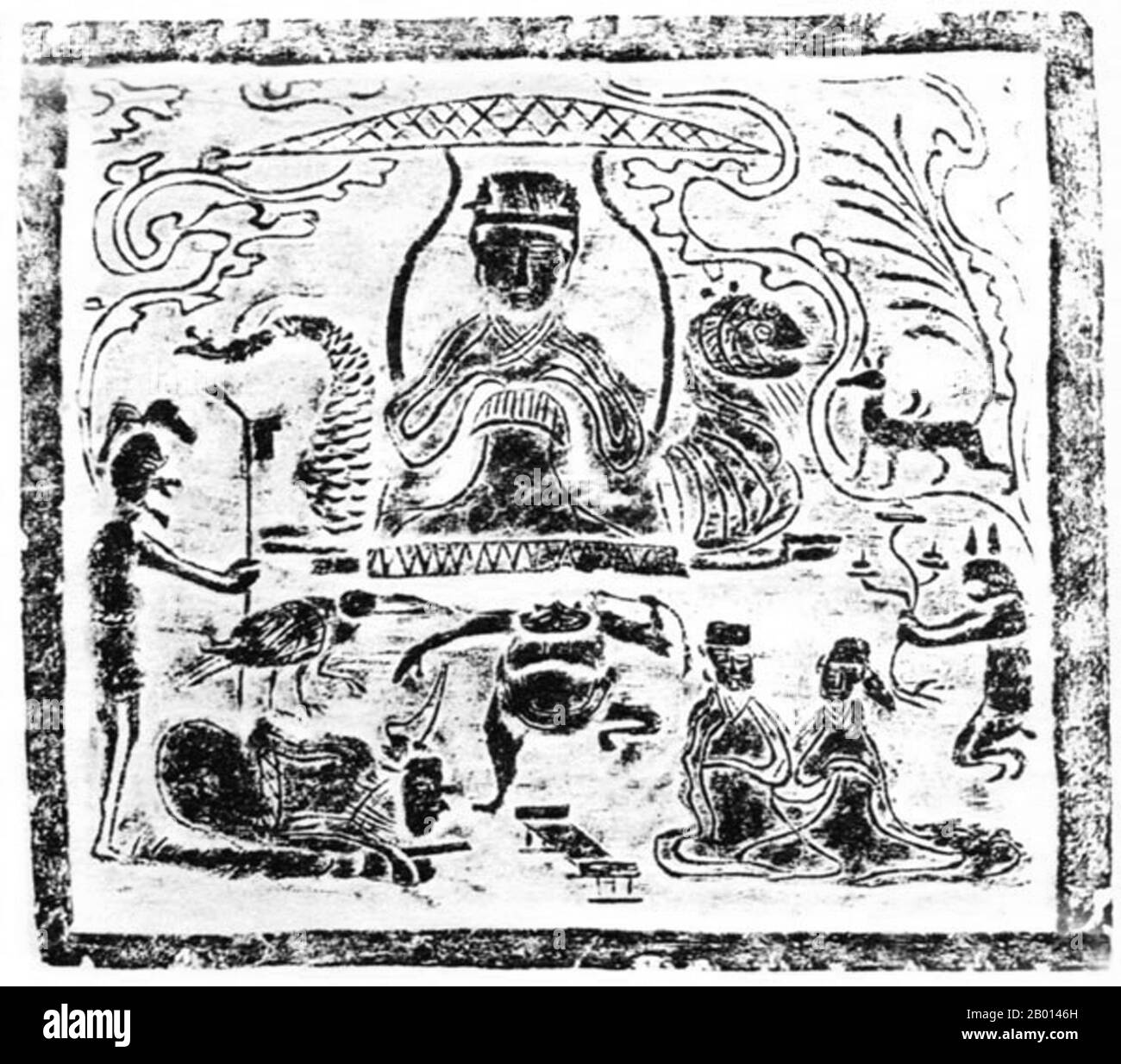 China: Xiwangmu, The Queen Mother of the West. Han Dynasty (202 BCE - 220 CE) mural. Xiwangmu, the Queen Mother of the West, is a goddess in Chinese religion. Though she is most often connected to Daoism, her existence and worship predates organised Daoism, with information tracing back to oracle bone inscriptions form the 15th century BCE. She is believed to be the dispenser of longevity, prosperity and eternal bliss. As the ancestor of Female Immortals, Xiwangmu lives in the Kunlun Mountains. All women who have attained immortality are under her rule. Stock Photohttps://www.alamy.com/image-license-details/?v=1https://www.alamy.com/china-xiwangmu-the-queen-mother-of-the-west-han-dynasty-202-bce-220-ce-mural-xiwangmu-the-queen-mother-of-the-west-is-a-goddess-in-chinese-religion-though-she-is-most-often-connected-to-daoism-her-existence-and-worship-predates-organised-daoism-with-information-tracing-back-to-oracle-bone-inscriptions-form-the-15th-century-bce-she-is-believed-to-be-the-dispenser-of-longevity-prosperity-and-eternal-bliss-as-the-ancestor-of-female-immortals-xiwangmu-lives-in-the-kunlun-mountains-all-women-who-have-attained-immortality-are-under-her-rule-image344232633.html
China: Xiwangmu, The Queen Mother of the West. Han Dynasty (202 BCE - 220 CE) mural. Xiwangmu, the Queen Mother of the West, is a goddess in Chinese religion. Though she is most often connected to Daoism, her existence and worship predates organised Daoism, with information tracing back to oracle bone inscriptions form the 15th century BCE. She is believed to be the dispenser of longevity, prosperity and eternal bliss. As the ancestor of Female Immortals, Xiwangmu lives in the Kunlun Mountains. All women who have attained immortality are under her rule. Stock Photohttps://www.alamy.com/image-license-details/?v=1https://www.alamy.com/china-xiwangmu-the-queen-mother-of-the-west-han-dynasty-202-bce-220-ce-mural-xiwangmu-the-queen-mother-of-the-west-is-a-goddess-in-chinese-religion-though-she-is-most-often-connected-to-daoism-her-existence-and-worship-predates-organised-daoism-with-information-tracing-back-to-oracle-bone-inscriptions-form-the-15th-century-bce-she-is-believed-to-be-the-dispenser-of-longevity-prosperity-and-eternal-bliss-as-the-ancestor-of-female-immortals-xiwangmu-lives-in-the-kunlun-mountains-all-women-who-have-attained-immortality-are-under-her-rule-image344232633.htmlRM2B0146H–China: Xiwangmu, The Queen Mother of the West. Han Dynasty (202 BCE - 220 CE) mural. Xiwangmu, the Queen Mother of the West, is a goddess in Chinese religion. Though she is most often connected to Daoism, her existence and worship predates organised Daoism, with information tracing back to oracle bone inscriptions form the 15th century BCE. She is believed to be the dispenser of longevity, prosperity and eternal bliss. As the ancestor of Female Immortals, Xiwangmu lives in the Kunlun Mountains. All women who have attained immortality are under her rule.
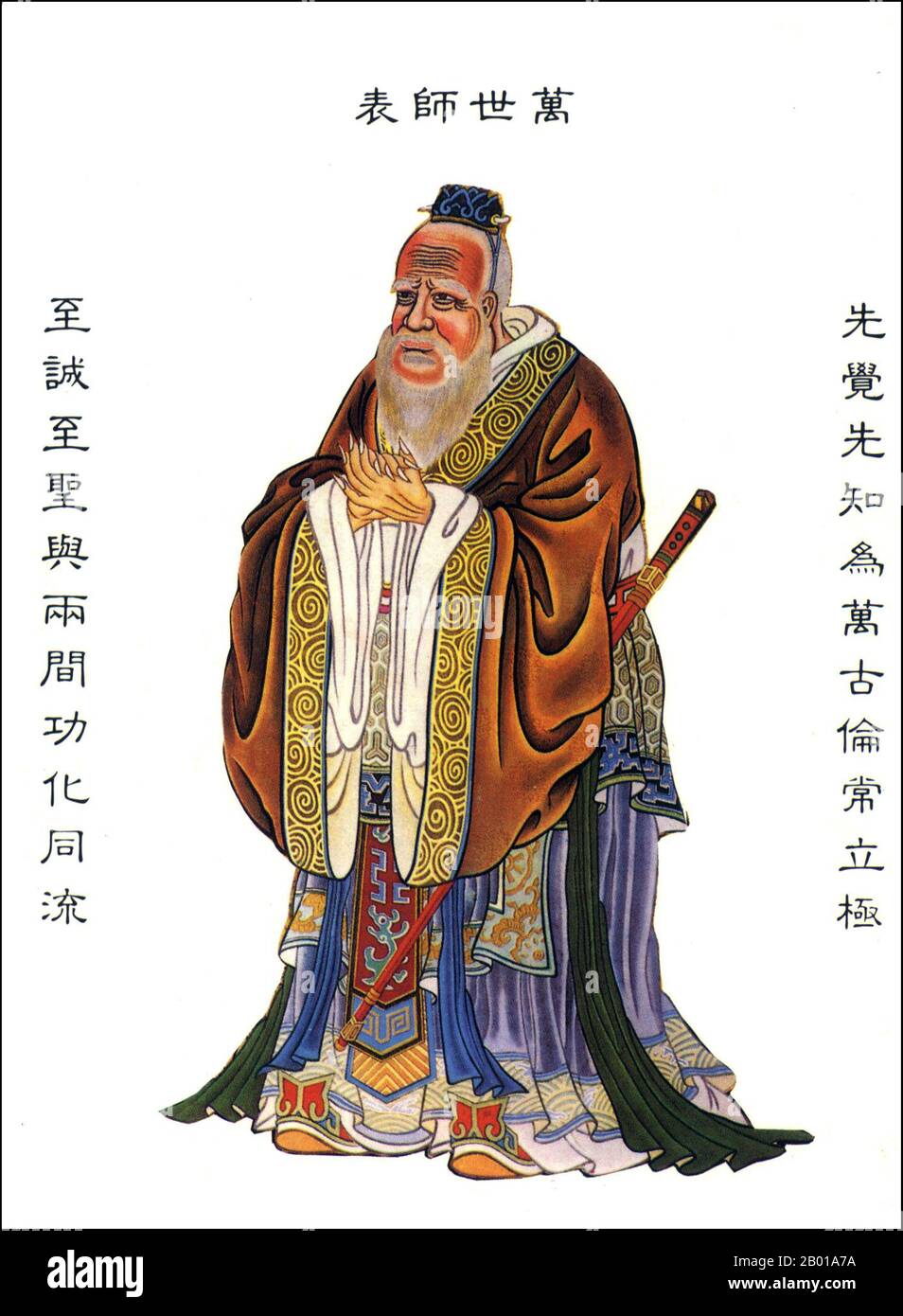 China: Confucius (551– 479 BCE), celebrated Chinese philosopher of the Spring and Autumn Period. Illustration, c. 19th century. The philosophy of Confucius (Kong Zi, K'ung-tzu, K'ung-fu-tzu) emphasises personal and governmental morality, correctness of social relationships, justice and sincerity. These values gained prominence in China during the Han Dynasty (206 BC – 220 AD). Confucius' thoughts have been developed into a system of philosophy known as Confucianism. It was introduced to Europe by the Italian Jesuit Matteo Ricci, who was the first to Latinise the name as 'Confucius'. Stock Photohttps://www.alamy.com/image-license-details/?v=1https://www.alamy.com/china-confucius-551-479-bce-celebrated-chinese-philosopher-of-the-spring-and-autumn-period-illustration-c-19th-century-the-philosophy-of-confucius-kong-zi-kung-tzu-kung-fu-tzu-emphasises-personal-and-governmental-morality-correctness-of-social-relationships-justice-and-sincerity-these-values-gained-prominence-in-china-during-the-han-dynasty-206-bc-220-ad-confucius-thoughts-have-been-developed-into-a-system-of-philosophy-known-as-confucianism-it-was-introduced-to-europe-by-the-italian-jesuit-matteo-ricci-who-was-the-first-to-latinise-the-name-as-confucius-image344237358.html
China: Confucius (551– 479 BCE), celebrated Chinese philosopher of the Spring and Autumn Period. Illustration, c. 19th century. The philosophy of Confucius (Kong Zi, K'ung-tzu, K'ung-fu-tzu) emphasises personal and governmental morality, correctness of social relationships, justice and sincerity. These values gained prominence in China during the Han Dynasty (206 BC – 220 AD). Confucius' thoughts have been developed into a system of philosophy known as Confucianism. It was introduced to Europe by the Italian Jesuit Matteo Ricci, who was the first to Latinise the name as 'Confucius'. Stock Photohttps://www.alamy.com/image-license-details/?v=1https://www.alamy.com/china-confucius-551-479-bce-celebrated-chinese-philosopher-of-the-spring-and-autumn-period-illustration-c-19th-century-the-philosophy-of-confucius-kong-zi-kung-tzu-kung-fu-tzu-emphasises-personal-and-governmental-morality-correctness-of-social-relationships-justice-and-sincerity-these-values-gained-prominence-in-china-during-the-han-dynasty-206-bc-220-ad-confucius-thoughts-have-been-developed-into-a-system-of-philosophy-known-as-confucianism-it-was-introduced-to-europe-by-the-italian-jesuit-matteo-ricci-who-was-the-first-to-latinise-the-name-as-confucius-image344237358.htmlRM2B01A7A–China: Confucius (551– 479 BCE), celebrated Chinese philosopher of the Spring and Autumn Period. Illustration, c. 19th century. The philosophy of Confucius (Kong Zi, K'ung-tzu, K'ung-fu-tzu) emphasises personal and governmental morality, correctness of social relationships, justice and sincerity. These values gained prominence in China during the Han Dynasty (206 BC – 220 AD). Confucius' thoughts have been developed into a system of philosophy known as Confucianism. It was introduced to Europe by the Italian Jesuit Matteo Ricci, who was the first to Latinise the name as 'Confucius'.
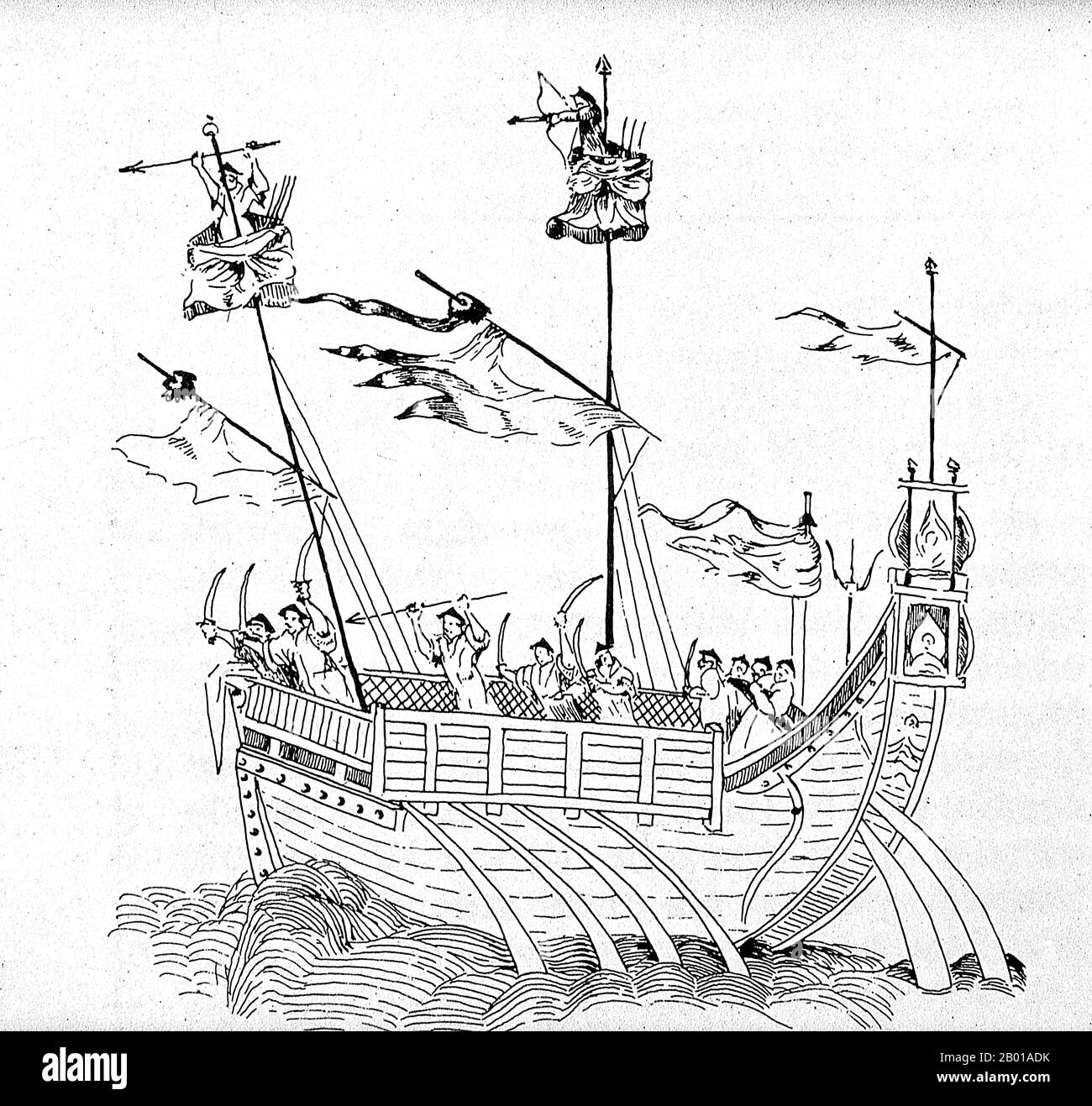 China: A two-masted Ming Dynasty war junk, c. early 17th century. A junk is an ancient Chinese sailing vessel design still in use today. Junks were developed during the Han Dynasty (206 BCE – 220 CE) and were used as sea-going vessels as early as the 2nd century CE. They evolved in the later dynasties, and were used throughout Asia for extensive ocean voyages. They were found, and in lesser numbers are still found, throughout Southeast Asia and India, but primarily in China, perhaps most famously in Hong Kong. Stock Photohttps://www.alamy.com/image-license-details/?v=1https://www.alamy.com/china-a-two-masted-ming-dynasty-war-junk-c-early-17th-century-a-junk-is-an-ancient-chinese-sailing-vessel-design-still-in-use-today-junks-were-developed-during-the-han-dynasty-206-bce-220-ce-and-were-used-as-sea-going-vessels-as-early-as-the-2nd-century-ce-they-evolved-in-the-later-dynasties-and-were-used-throughout-asia-for-extensive-ocean-voyages-they-were-found-and-in-lesser-numbers-are-still-found-throughout-southeast-asia-and-india-but-primarily-in-china-perhaps-most-famously-in-hong-kong-image344237535.html
China: A two-masted Ming Dynasty war junk, c. early 17th century. A junk is an ancient Chinese sailing vessel design still in use today. Junks were developed during the Han Dynasty (206 BCE – 220 CE) and were used as sea-going vessels as early as the 2nd century CE. They evolved in the later dynasties, and were used throughout Asia for extensive ocean voyages. They were found, and in lesser numbers are still found, throughout Southeast Asia and India, but primarily in China, perhaps most famously in Hong Kong. Stock Photohttps://www.alamy.com/image-license-details/?v=1https://www.alamy.com/china-a-two-masted-ming-dynasty-war-junk-c-early-17th-century-a-junk-is-an-ancient-chinese-sailing-vessel-design-still-in-use-today-junks-were-developed-during-the-han-dynasty-206-bce-220-ce-and-were-used-as-sea-going-vessels-as-early-as-the-2nd-century-ce-they-evolved-in-the-later-dynasties-and-were-used-throughout-asia-for-extensive-ocean-voyages-they-were-found-and-in-lesser-numbers-are-still-found-throughout-southeast-asia-and-india-but-primarily-in-china-perhaps-most-famously-in-hong-kong-image344237535.htmlRM2B01ADK–China: A two-masted Ming Dynasty war junk, c. early 17th century. A junk is an ancient Chinese sailing vessel design still in use today. Junks were developed during the Han Dynasty (206 BCE – 220 CE) and were used as sea-going vessels as early as the 2nd century CE. They evolved in the later dynasties, and were used throughout Asia for extensive ocean voyages. They were found, and in lesser numbers are still found, throughout Southeast Asia and India, but primarily in China, perhaps most famously in Hong Kong.
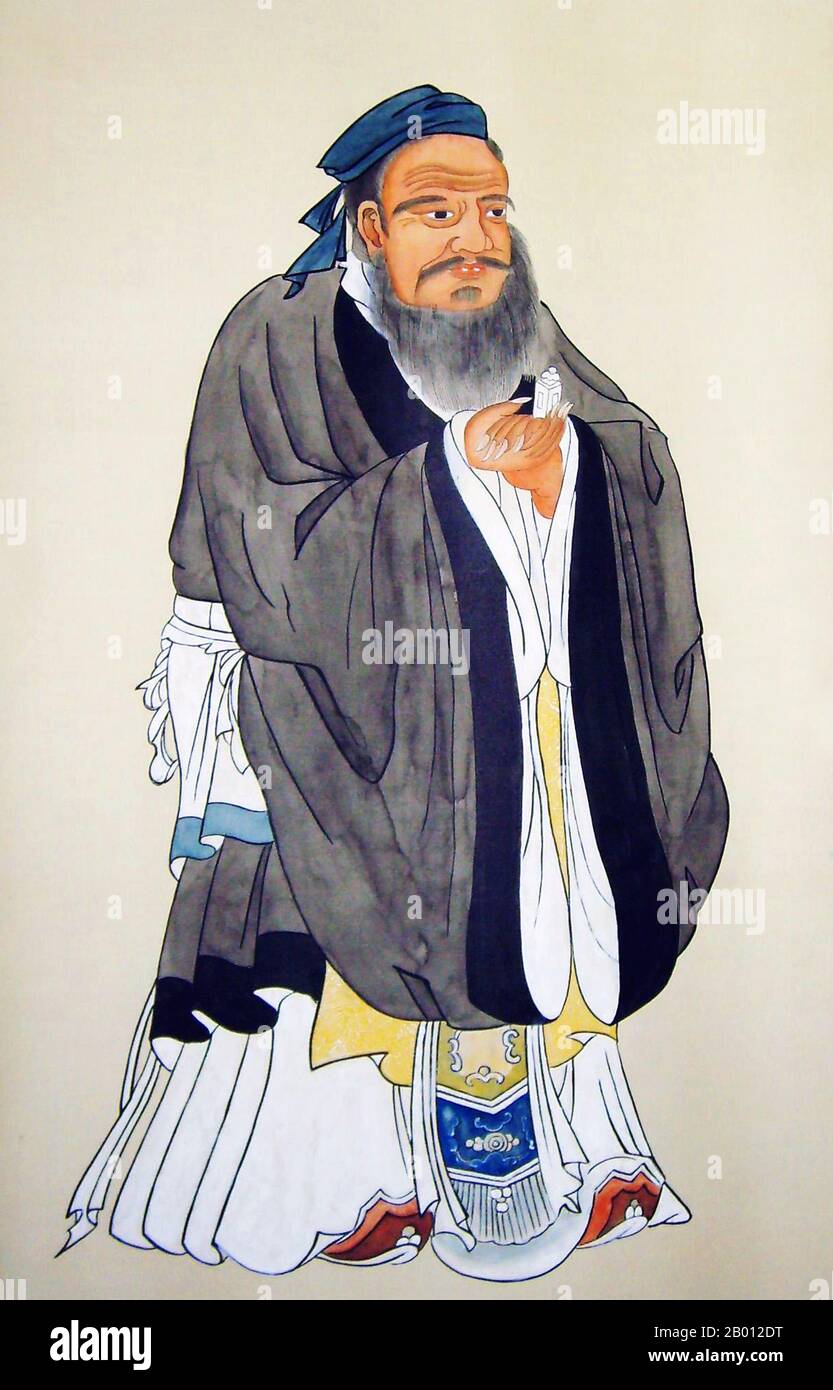 China: Confucius (Kong Zi, K'ung-tzu, K'ung-fu-tzu, 551– 479 BCE), Chinese philosopher of the Spring and Autumn Period. Portrait by Qiu Ying (1494-1552), 16th century. The philosophy of Confucius emphasises personal and governmental morality, correctness of social relationships, justice and sincerity. These values gained prominence in China during the Han Dynasty(206 BC – 220 AD). Confucius' thoughts have been developed into a system of philosophy known as Confucianism. It was introduced to Europe by the Italian Jesuit Matteo Ricci, who was the first to Latinise the name as 'Confucius'. Stock Photohttps://www.alamy.com/image-license-details/?v=1https://www.alamy.com/china-confucius-kong-zi-kung-tzu-kung-fu-tzu-551-479-bce-chinese-philosopher-of-the-spring-and-autumn-period-portrait-by-qiu-ying-1494-1552-16th-century-the-philosophy-of-confucius-emphasises-personal-and-governmental-morality-correctness-of-social-relationships-justice-and-sincerity-these-values-gained-prominence-in-china-during-the-han-dynasty206-bc-220-ad-confucius-thoughts-have-been-developed-into-a-system-of-philosophy-known-as-confucianism-it-was-introduced-to-europe-by-the-italian-jesuit-matteo-ricci-who-was-the-first-to-latinise-the-name-as-confucius-image344231268.html
China: Confucius (Kong Zi, K'ung-tzu, K'ung-fu-tzu, 551– 479 BCE), Chinese philosopher of the Spring and Autumn Period. Portrait by Qiu Ying (1494-1552), 16th century. The philosophy of Confucius emphasises personal and governmental morality, correctness of social relationships, justice and sincerity. These values gained prominence in China during the Han Dynasty(206 BC – 220 AD). Confucius' thoughts have been developed into a system of philosophy known as Confucianism. It was introduced to Europe by the Italian Jesuit Matteo Ricci, who was the first to Latinise the name as 'Confucius'. Stock Photohttps://www.alamy.com/image-license-details/?v=1https://www.alamy.com/china-confucius-kong-zi-kung-tzu-kung-fu-tzu-551-479-bce-chinese-philosopher-of-the-spring-and-autumn-period-portrait-by-qiu-ying-1494-1552-16th-century-the-philosophy-of-confucius-emphasises-personal-and-governmental-morality-correctness-of-social-relationships-justice-and-sincerity-these-values-gained-prominence-in-china-during-the-han-dynasty206-bc-220-ad-confucius-thoughts-have-been-developed-into-a-system-of-philosophy-known-as-confucianism-it-was-introduced-to-europe-by-the-italian-jesuit-matteo-ricci-who-was-the-first-to-latinise-the-name-as-confucius-image344231268.htmlRM2B012DT–China: Confucius (Kong Zi, K'ung-tzu, K'ung-fu-tzu, 551– 479 BCE), Chinese philosopher of the Spring and Autumn Period. Portrait by Qiu Ying (1494-1552), 16th century. The philosophy of Confucius emphasises personal and governmental morality, correctness of social relationships, justice and sincerity. These values gained prominence in China during the Han Dynasty(206 BC – 220 AD). Confucius' thoughts have been developed into a system of philosophy known as Confucianism. It was introduced to Europe by the Italian Jesuit Matteo Ricci, who was the first to Latinise the name as 'Confucius'.
 Ornament in the form of a feline-like animal on a foot-shaped stand, Han dynasty, 206 BCE-220 CE. Stock Photohttps://www.alamy.com/image-license-details/?v=1https://www.alamy.com/ornament-in-the-form-of-a-feline-like-animal-on-a-foot-shaped-stand-han-dynasty-206-bce-220-ce-image440353898.html
Ornament in the form of a feline-like animal on a foot-shaped stand, Han dynasty, 206 BCE-220 CE. Stock Photohttps://www.alamy.com/image-license-details/?v=1https://www.alamy.com/ornament-in-the-form-of-a-feline-like-animal-on-a-foot-shaped-stand-han-dynasty-206-bce-220-ce-image440353898.htmlRM2GGBRTX–Ornament in the form of a feline-like animal on a foot-shaped stand, Han dynasty, 206 BCE-220 CE.
 Xi Bi Disc, 206 BCE - 220 CE, 2 1/8 x 1/8 in. (5.4 x 0.4 cm) (outer diameter), Tannish brown jade with dark brown clouds, China, 3rd century BCE - 3rd century CE Stock Photohttps://www.alamy.com/image-license-details/?v=1https://www.alamy.com/xi-bi-disc-206-bce-220-ce-2-18-x-18-in-54-x-04-cm-outer-diameter-tannish-brown-jade-with-dark-brown-clouds-china-3rd-century-bce-3rd-century-ce-image573516584.html
Xi Bi Disc, 206 BCE - 220 CE, 2 1/8 x 1/8 in. (5.4 x 0.4 cm) (outer diameter), Tannish brown jade with dark brown clouds, China, 3rd century BCE - 3rd century CE Stock Photohttps://www.alamy.com/image-license-details/?v=1https://www.alamy.com/xi-bi-disc-206-bce-220-ce-2-18-x-18-in-54-x-04-cm-outer-diameter-tannish-brown-jade-with-dark-brown-clouds-china-3rd-century-bce-3rd-century-ce-image573516584.htmlRM2T91X74–Xi Bi Disc, 206 BCE - 220 CE, 2 1/8 x 1/8 in. (5.4 x 0.4 cm) (outer diameter), Tannish brown jade with dark brown clouds, China, 3rd century BCE - 3rd century CE
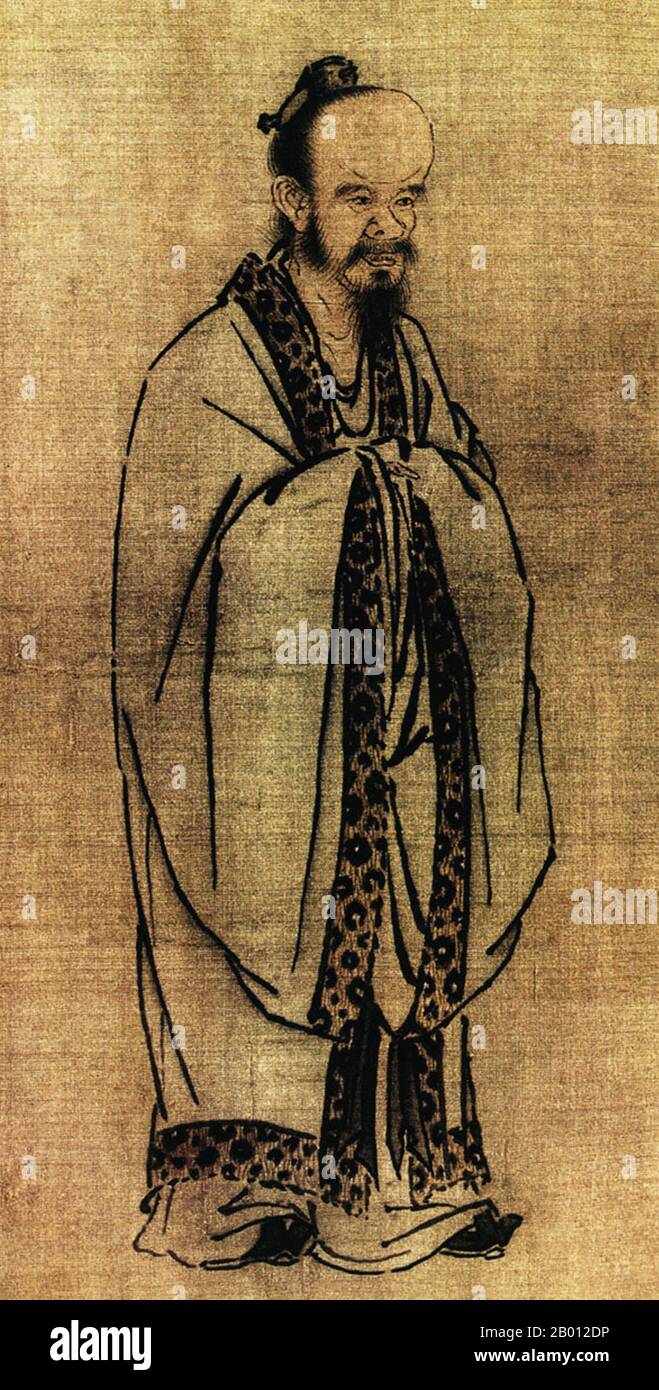 China: Confucius (Kong Zi, K'ung-tzu, K'ung-fu-tzu, 551– 479 BCE), celebrated Chinese philosopher of the Spring and Autumn Period. Silk painting by Ma Yuan (1160-1225), late 12th - early 13th century. The philosophy of Confucius emphasises personal and governmental morality, correctness of social relationships, justice and sincerity. These values gained prominence in China during the Han Dynasty(206 BC – 220 AD). Confucius' thoughts have been developed into a system of philosophy known as Confucianism. It was introduced to Europe by the Italian Jesuit Matteo Ricci. Stock Photohttps://www.alamy.com/image-license-details/?v=1https://www.alamy.com/china-confucius-kong-zi-kung-tzu-kung-fu-tzu-551-479-bce-celebrated-chinese-philosopher-of-the-spring-and-autumn-period-silk-painting-by-ma-yuan-1160-1225-late-12th-early-13th-century-the-philosophy-of-confucius-emphasises-personal-and-governmental-morality-correctness-of-social-relationships-justice-and-sincerity-these-values-gained-prominence-in-china-during-the-han-dynasty206-bc-220-ad-confucius-thoughts-have-been-developed-into-a-system-of-philosophy-known-as-confucianism-it-was-introduced-to-europe-by-the-italian-jesuit-matteo-ricci-image344231266.html
China: Confucius (Kong Zi, K'ung-tzu, K'ung-fu-tzu, 551– 479 BCE), celebrated Chinese philosopher of the Spring and Autumn Period. Silk painting by Ma Yuan (1160-1225), late 12th - early 13th century. The philosophy of Confucius emphasises personal and governmental morality, correctness of social relationships, justice and sincerity. These values gained prominence in China during the Han Dynasty(206 BC – 220 AD). Confucius' thoughts have been developed into a system of philosophy known as Confucianism. It was introduced to Europe by the Italian Jesuit Matteo Ricci. Stock Photohttps://www.alamy.com/image-license-details/?v=1https://www.alamy.com/china-confucius-kong-zi-kung-tzu-kung-fu-tzu-551-479-bce-celebrated-chinese-philosopher-of-the-spring-and-autumn-period-silk-painting-by-ma-yuan-1160-1225-late-12th-early-13th-century-the-philosophy-of-confucius-emphasises-personal-and-governmental-morality-correctness-of-social-relationships-justice-and-sincerity-these-values-gained-prominence-in-china-during-the-han-dynasty206-bc-220-ad-confucius-thoughts-have-been-developed-into-a-system-of-philosophy-known-as-confucianism-it-was-introduced-to-europe-by-the-italian-jesuit-matteo-ricci-image344231266.htmlRM2B012DP–China: Confucius (Kong Zi, K'ung-tzu, K'ung-fu-tzu, 551– 479 BCE), celebrated Chinese philosopher of the Spring and Autumn Period. Silk painting by Ma Yuan (1160-1225), late 12th - early 13th century. The philosophy of Confucius emphasises personal and governmental morality, correctness of social relationships, justice and sincerity. These values gained prominence in China during the Han Dynasty(206 BC – 220 AD). Confucius' thoughts have been developed into a system of philosophy known as Confucianism. It was introduced to Europe by the Italian Jesuit Matteo Ricci.
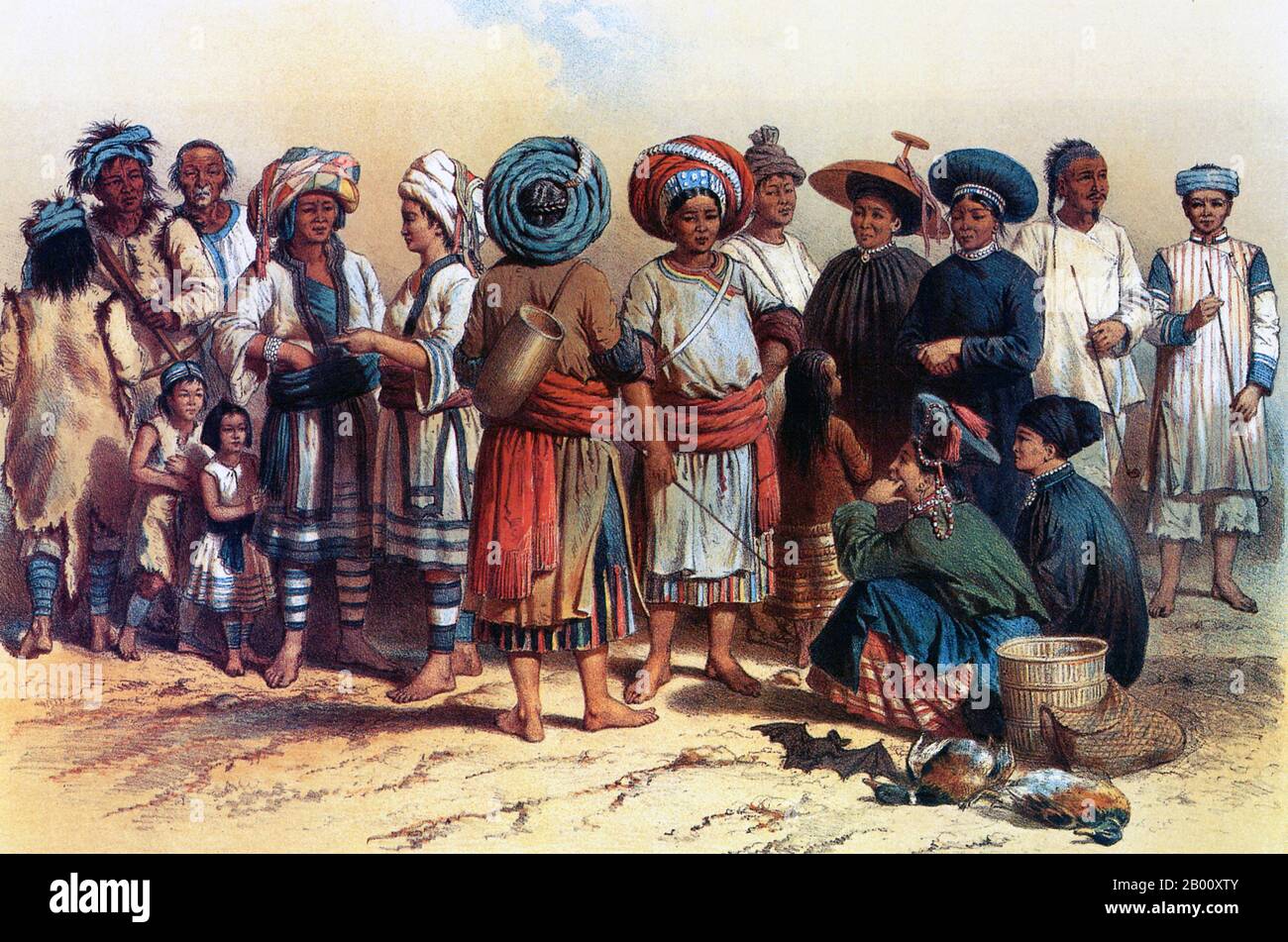 China: Engraving by Louis Delaporte (1842-1925) showing the various ethnicities of southern Yunnan province, including ethnic Lisu (far left), Yao (middle), and Bai (far right), 1873. Yunnan became part of the Han Dynasty (206 BCE-220 CE) during 2nd century BCE. It became the seat of a Tibeto-Burman speaking kingdom known as Nanzhao in the 8th century. Nanzhao was multi-ethnic, but the elite most likely spoke a northern dialect of Yi, which became established as the prestige dialect (see Nuosu language). Stock Photohttps://www.alamy.com/image-license-details/?v=1https://www.alamy.com/china-engraving-by-louis-delaporte-1842-1925-showing-the-various-ethnicities-of-southern-yunnan-province-including-ethnic-lisu-far-left-yao-middle-and-bai-far-right-1873-yunnan-became-part-of-the-han-dynasty-206-bce-220-ce-during-2nd-century-bce-it-became-the-seat-of-a-tibeto-burman-speaking-kingdom-known-as-nanzhao-in-the-8th-century-nanzhao-was-multi-ethnic-but-the-elite-most-likely-spoke-a-northern-dialect-of-yi-which-became-established-as-the-prestige-dialect-see-nuosu-language-image344228443.html
China: Engraving by Louis Delaporte (1842-1925) showing the various ethnicities of southern Yunnan province, including ethnic Lisu (far left), Yao (middle), and Bai (far right), 1873. Yunnan became part of the Han Dynasty (206 BCE-220 CE) during 2nd century BCE. It became the seat of a Tibeto-Burman speaking kingdom known as Nanzhao in the 8th century. Nanzhao was multi-ethnic, but the elite most likely spoke a northern dialect of Yi, which became established as the prestige dialect (see Nuosu language). Stock Photohttps://www.alamy.com/image-license-details/?v=1https://www.alamy.com/china-engraving-by-louis-delaporte-1842-1925-showing-the-various-ethnicities-of-southern-yunnan-province-including-ethnic-lisu-far-left-yao-middle-and-bai-far-right-1873-yunnan-became-part-of-the-han-dynasty-206-bce-220-ce-during-2nd-century-bce-it-became-the-seat-of-a-tibeto-burman-speaking-kingdom-known-as-nanzhao-in-the-8th-century-nanzhao-was-multi-ethnic-but-the-elite-most-likely-spoke-a-northern-dialect-of-yi-which-became-established-as-the-prestige-dialect-see-nuosu-language-image344228443.htmlRM2B00XTY–China: Engraving by Louis Delaporte (1842-1925) showing the various ethnicities of southern Yunnan province, including ethnic Lisu (far left), Yao (middle), and Bai (far right), 1873. Yunnan became part of the Han Dynasty (206 BCE-220 CE) during 2nd century BCE. It became the seat of a Tibeto-Burman speaking kingdom known as Nanzhao in the 8th century. Nanzhao was multi-ethnic, but the elite most likely spoke a northern dialect of Yi, which became established as the prestige dialect (see Nuosu language).
 China: A crowd listening to a storyteller, Kashgar bazaar, Xinjiang. Photograph by Dutch botanist Frank Nicholas Meyer (1875-1918), 1911. The earliest mention of Kashgar occurs when a Chinese Han Dynasty (206 BCE – 220 CE) envoy traveled the Northern Silk Road to explore lands to the west. Another early mention of Kashgar is during the Former Han (also known as the Western Han Dynasty), when in 76 BCE the Chinese conquered the Xiongnu, Yutian (Khotan), Sulei (Kashgar), and a group of states in the Tarim basin almost up to the foot of the Tian Shan mountains. Stock Photohttps://www.alamy.com/image-license-details/?v=1https://www.alamy.com/china-a-crowd-listening-to-a-storyteller-kashgar-bazaar-xinjiang-photograph-by-dutch-botanist-frank-nicholas-meyer-1875-1918-1911-the-earliest-mention-of-kashgar-occurs-when-a-chinese-han-dynasty-206-bce-220-ce-envoy-traveled-the-northern-silk-road-to-explore-lands-to-the-west-another-early-mention-of-kashgar-is-during-the-former-han-also-known-as-the-western-han-dynasty-when-in-76-bce-the-chinese-conquered-the-xiongnu-yutian-khotan-sulei-kashgar-and-a-group-of-states-in-the-tarim-basin-almost-up-to-the-foot-of-the-tian-shan-mountains-image344230348.html
China: A crowd listening to a storyteller, Kashgar bazaar, Xinjiang. Photograph by Dutch botanist Frank Nicholas Meyer (1875-1918), 1911. The earliest mention of Kashgar occurs when a Chinese Han Dynasty (206 BCE – 220 CE) envoy traveled the Northern Silk Road to explore lands to the west. Another early mention of Kashgar is during the Former Han (also known as the Western Han Dynasty), when in 76 BCE the Chinese conquered the Xiongnu, Yutian (Khotan), Sulei (Kashgar), and a group of states in the Tarim basin almost up to the foot of the Tian Shan mountains. Stock Photohttps://www.alamy.com/image-license-details/?v=1https://www.alamy.com/china-a-crowd-listening-to-a-storyteller-kashgar-bazaar-xinjiang-photograph-by-dutch-botanist-frank-nicholas-meyer-1875-1918-1911-the-earliest-mention-of-kashgar-occurs-when-a-chinese-han-dynasty-206-bce-220-ce-envoy-traveled-the-northern-silk-road-to-explore-lands-to-the-west-another-early-mention-of-kashgar-is-during-the-former-han-also-known-as-the-western-han-dynasty-when-in-76-bce-the-chinese-conquered-the-xiongnu-yutian-khotan-sulei-kashgar-and-a-group-of-states-in-the-tarim-basin-almost-up-to-the-foot-of-the-tian-shan-mountains-image344230348.htmlRM2B01190–China: A crowd listening to a storyteller, Kashgar bazaar, Xinjiang. Photograph by Dutch botanist Frank Nicholas Meyer (1875-1918), 1911. The earliest mention of Kashgar occurs when a Chinese Han Dynasty (206 BCE – 220 CE) envoy traveled the Northern Silk Road to explore lands to the west. Another early mention of Kashgar is during the Former Han (also known as the Western Han Dynasty), when in 76 BCE the Chinese conquered the Xiongnu, Yutian (Khotan), Sulei (Kashgar), and a group of states in the Tarim basin almost up to the foot of the Tian Shan mountains.
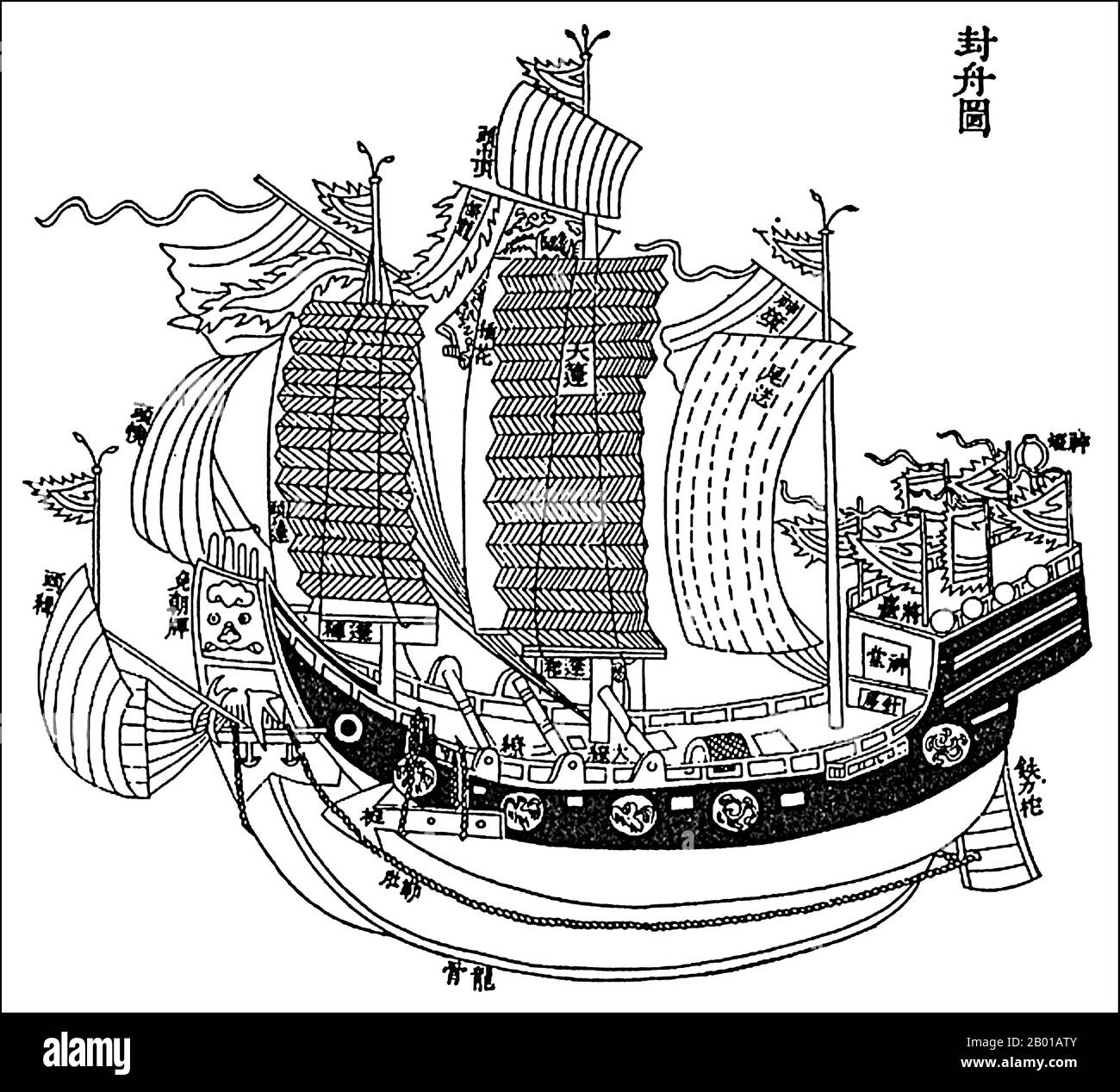 China: A Mongol/Yuan Dynasty war junk (Hai Fanchuan). Drawing from the book 'Liuqiu Guozhi Lue' (Annals of Ryukyu) by Zhou Huang (1714-1785), c. 1757-1759. A junk is an ancient Chinese sailing vessel design still in use today. Junks were developed during the Han Dynasty (206 BCE – 220 CE) and were used as sea-going vessels as early as the 2nd century CE. They evolved in the later dynasties, and were used throughout Asia for extensive ocean voyages. They were found, and in lesser numbers are still found, throughout Southeast Asia and India, but primarily in China. Stock Photohttps://www.alamy.com/image-license-details/?v=1https://www.alamy.com/china-a-mongolyuan-dynasty-war-junk-hai-fanchuan-drawing-from-the-book-liuqiu-guozhi-lue-annals-of-ryukyu-by-zhou-huang-1714-1785-c-1757-1759-a-junk-is-an-ancient-chinese-sailing-vessel-design-still-in-use-today-junks-were-developed-during-the-han-dynasty-206-bce-220-ce-and-were-used-as-sea-going-vessels-as-early-as-the-2nd-century-ce-they-evolved-in-the-later-dynasties-and-were-used-throughout-asia-for-extensive-ocean-voyages-they-were-found-and-in-lesser-numbers-are-still-found-throughout-southeast-asia-and-india-but-primarily-in-china-image344237851.html
China: A Mongol/Yuan Dynasty war junk (Hai Fanchuan). Drawing from the book 'Liuqiu Guozhi Lue' (Annals of Ryukyu) by Zhou Huang (1714-1785), c. 1757-1759. A junk is an ancient Chinese sailing vessel design still in use today. Junks were developed during the Han Dynasty (206 BCE – 220 CE) and were used as sea-going vessels as early as the 2nd century CE. They evolved in the later dynasties, and were used throughout Asia for extensive ocean voyages. They were found, and in lesser numbers are still found, throughout Southeast Asia and India, but primarily in China. Stock Photohttps://www.alamy.com/image-license-details/?v=1https://www.alamy.com/china-a-mongolyuan-dynasty-war-junk-hai-fanchuan-drawing-from-the-book-liuqiu-guozhi-lue-annals-of-ryukyu-by-zhou-huang-1714-1785-c-1757-1759-a-junk-is-an-ancient-chinese-sailing-vessel-design-still-in-use-today-junks-were-developed-during-the-han-dynasty-206-bce-220-ce-and-were-used-as-sea-going-vessels-as-early-as-the-2nd-century-ce-they-evolved-in-the-later-dynasties-and-were-used-throughout-asia-for-extensive-ocean-voyages-they-were-found-and-in-lesser-numbers-are-still-found-throughout-southeast-asia-and-india-but-primarily-in-china-image344237851.htmlRM2B01ATY–China: A Mongol/Yuan Dynasty war junk (Hai Fanchuan). Drawing from the book 'Liuqiu Guozhi Lue' (Annals of Ryukyu) by Zhou Huang (1714-1785), c. 1757-1759. A junk is an ancient Chinese sailing vessel design still in use today. Junks were developed during the Han Dynasty (206 BCE – 220 CE) and were used as sea-going vessels as early as the 2nd century CE. They evolved in the later dynasties, and were used throughout Asia for extensive ocean voyages. They were found, and in lesser numbers are still found, throughout Southeast Asia and India, but primarily in China.
 China: A man plays a sanxian in a park in Wuwei, Gansu Province. The city of Wuwei has a population of around 500,000, mainly Han Chinese, but with visible numbers of Hui as well as Mongols and Tibetans. In earlier times it was called Liangzhou. Dominating the eastern end of the Hexi Corridor, it has long played a significant role on this major trade route. Wuwei’s most famous historic artefact, the celebrated Han Dynasty (206 BCE - 220 CE) bronze horse known as the Flying Horse of Gansu, was discovered here in a tomb beneath Leitai Temple (Leitai Si) in the north part of town. Stock Photohttps://www.alamy.com/image-license-details/?v=1https://www.alamy.com/china-a-man-plays-a-sanxian-in-a-park-in-wuwei-gansu-province-the-city-of-wuwei-has-a-population-of-around-500000-mainly-han-chinese-but-with-visible-numbers-of-hui-as-well-as-mongols-and-tibetans-in-earlier-times-it-was-called-liangzhou-dominating-the-eastern-end-of-the-hexi-corridor-it-has-long-played-a-significant-role-on-this-major-trade-route-wuweis-most-famous-historic-artefact-the-celebrated-han-dynasty-206-bce-220-ce-bronze-horse-known-as-the-flying-horse-of-gansu-was-discovered-here-in-a-tomb-beneath-leitai-temple-leitai-si-in-the-north-part-of-town-image344245583.html
China: A man plays a sanxian in a park in Wuwei, Gansu Province. The city of Wuwei has a population of around 500,000, mainly Han Chinese, but with visible numbers of Hui as well as Mongols and Tibetans. In earlier times it was called Liangzhou. Dominating the eastern end of the Hexi Corridor, it has long played a significant role on this major trade route. Wuwei’s most famous historic artefact, the celebrated Han Dynasty (206 BCE - 220 CE) bronze horse known as the Flying Horse of Gansu, was discovered here in a tomb beneath Leitai Temple (Leitai Si) in the north part of town. Stock Photohttps://www.alamy.com/image-license-details/?v=1https://www.alamy.com/china-a-man-plays-a-sanxian-in-a-park-in-wuwei-gansu-province-the-city-of-wuwei-has-a-population-of-around-500000-mainly-han-chinese-but-with-visible-numbers-of-hui-as-well-as-mongols-and-tibetans-in-earlier-times-it-was-called-liangzhou-dominating-the-eastern-end-of-the-hexi-corridor-it-has-long-played-a-significant-role-on-this-major-trade-route-wuweis-most-famous-historic-artefact-the-celebrated-han-dynasty-206-bce-220-ce-bronze-horse-known-as-the-flying-horse-of-gansu-was-discovered-here-in-a-tomb-beneath-leitai-temple-leitai-si-in-the-north-part-of-town-image344245583.htmlRM2B01MN3–China: A man plays a sanxian in a park in Wuwei, Gansu Province. The city of Wuwei has a population of around 500,000, mainly Han Chinese, but with visible numbers of Hui as well as Mongols and Tibetans. In earlier times it was called Liangzhou. Dominating the eastern end of the Hexi Corridor, it has long played a significant role on this major trade route. Wuwei’s most famous historic artefact, the celebrated Han Dynasty (206 BCE - 220 CE) bronze horse known as the Flying Horse of Gansu, was discovered here in a tomb beneath Leitai Temple (Leitai Si) in the north part of town.
 Pendant in the form of a Dragon, 206 BCE - 220 CE, 4 x 6 3/4 x 1/4 in. (10.16 x 17.15 x 0.56 cm), Green jade, China, 3rd century BCE - 3rd century CE Stock Photohttps://www.alamy.com/image-license-details/?v=1https://www.alamy.com/pendant-in-the-form-of-a-dragon-206-bce-220-ce-4-x-6-34-x-14-in-1016-x-1715-x-056-cm-green-jade-china-3rd-century-bce-3rd-century-ce-image573517121.html
Pendant in the form of a Dragon, 206 BCE - 220 CE, 4 x 6 3/4 x 1/4 in. (10.16 x 17.15 x 0.56 cm), Green jade, China, 3rd century BCE - 3rd century CE Stock Photohttps://www.alamy.com/image-license-details/?v=1https://www.alamy.com/pendant-in-the-form-of-a-dragon-206-bce-220-ce-4-x-6-34-x-14-in-1016-x-1715-x-056-cm-green-jade-china-3rd-century-bce-3rd-century-ce-image573517121.htmlRM2T91XX9–Pendant in the form of a Dragon, 206 BCE - 220 CE, 4 x 6 3/4 x 1/4 in. (10.16 x 17.15 x 0.56 cm), Green jade, China, 3rd century BCE - 3rd century CE
 China: A man plays a banhu in a park in Wuwei, Gansu Province. The city of Wuwei has a population of around 500,000, mainly Han Chinese, but with visible numbers of Hui as well as Mongols and Tibetans. In earlier times it was called Liangzhou. Dominating the eastern end of the Hexi Corridor, it has long played a significant role on this major trade route. Wuwei’s most famous historic artefact, the celebrated Han Dynasty (206 BCE - 220 CE) bronze horse known as the Flying Horse of Gansu, was discovered here in a tomb beneath Leitai Temple (Leitai Si) in the north part of town. Stock Photohttps://www.alamy.com/image-license-details/?v=1https://www.alamy.com/china-a-man-plays-a-banhu-in-a-park-in-wuwei-gansu-province-the-city-of-wuwei-has-a-population-of-around-500000-mainly-han-chinese-but-with-visible-numbers-of-hui-as-well-as-mongols-and-tibetans-in-earlier-times-it-was-called-liangzhou-dominating-the-eastern-end-of-the-hexi-corridor-it-has-long-played-a-significant-role-on-this-major-trade-route-wuweis-most-famous-historic-artefact-the-celebrated-han-dynasty-206-bce-220-ce-bronze-horse-known-as-the-flying-horse-of-gansu-was-discovered-here-in-a-tomb-beneath-leitai-temple-leitai-si-in-the-north-part-of-town-image344245589.html
China: A man plays a banhu in a park in Wuwei, Gansu Province. The city of Wuwei has a population of around 500,000, mainly Han Chinese, but with visible numbers of Hui as well as Mongols and Tibetans. In earlier times it was called Liangzhou. Dominating the eastern end of the Hexi Corridor, it has long played a significant role on this major trade route. Wuwei’s most famous historic artefact, the celebrated Han Dynasty (206 BCE - 220 CE) bronze horse known as the Flying Horse of Gansu, was discovered here in a tomb beneath Leitai Temple (Leitai Si) in the north part of town. Stock Photohttps://www.alamy.com/image-license-details/?v=1https://www.alamy.com/china-a-man-plays-a-banhu-in-a-park-in-wuwei-gansu-province-the-city-of-wuwei-has-a-population-of-around-500000-mainly-han-chinese-but-with-visible-numbers-of-hui-as-well-as-mongols-and-tibetans-in-earlier-times-it-was-called-liangzhou-dominating-the-eastern-end-of-the-hexi-corridor-it-has-long-played-a-significant-role-on-this-major-trade-route-wuweis-most-famous-historic-artefact-the-celebrated-han-dynasty-206-bce-220-ce-bronze-horse-known-as-the-flying-horse-of-gansu-was-discovered-here-in-a-tomb-beneath-leitai-temple-leitai-si-in-the-north-part-of-town-image344245589.htmlRM2B01MN9–China: A man plays a banhu in a park in Wuwei, Gansu Province. The city of Wuwei has a population of around 500,000, mainly Han Chinese, but with visible numbers of Hui as well as Mongols and Tibetans. In earlier times it was called Liangzhou. Dominating the eastern end of the Hexi Corridor, it has long played a significant role on this major trade route. Wuwei’s most famous historic artefact, the celebrated Han Dynasty (206 BCE - 220 CE) bronze horse known as the Flying Horse of Gansu, was discovered here in a tomb beneath Leitai Temple (Leitai Si) in the north part of town.
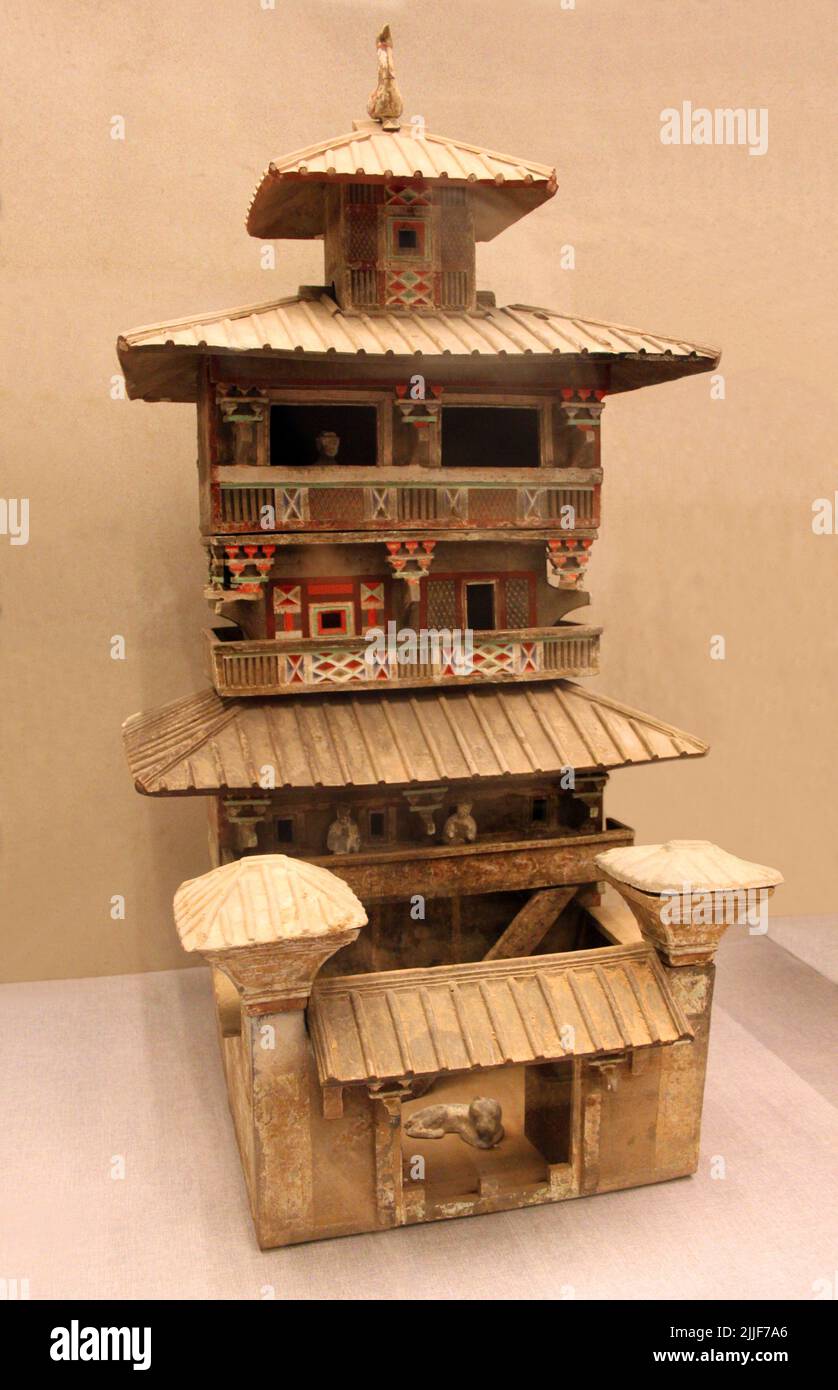 China: Ceramic model of a storage tower, Eastern Han Dynasty (25-220 CE), Shandong Provincial Museum, Jinan. The Han Dynasty was an imperial dynasty that ruled during a golden age in Chinese history and has influenced the identity of Chinese civilisation ever since. First established by Emperor Gao (Liu Bang), it was briefly usurped by the Xin Dynasty (9-23 CE), so is separated into two periods: the Western Han (202 BCE - 9 CE) and the Eastern Han (25-220 CE). Porcelain and ceramics were made in great quantities during the Han Dynasty years, with developments in new techniques and artforms l Stock Photohttps://www.alamy.com/image-license-details/?v=1https://www.alamy.com/china-ceramic-model-of-a-storage-tower-eastern-han-dynasty-25-220-ce-shandong-provincial-museum-jinan-the-han-dynasty-was-an-imperial-dynasty-that-ruled-during-a-golden-age-in-chinese-history-and-has-influenced-the-identity-of-chinese-civilisation-ever-since-first-established-by-emperor-gao-liu-bang-it-was-briefly-usurped-by-the-xin-dynasty-9-23-ce-so-is-separated-into-two-periods-the-western-han-202-bce-9-ce-and-the-eastern-han-25-220-ce-porcelain-and-ceramics-were-made-in-great-quantities-during-the-han-dynasty-years-with-developments-in-new-techniques-and-artforms-l-image476078798.html
China: Ceramic model of a storage tower, Eastern Han Dynasty (25-220 CE), Shandong Provincial Museum, Jinan. The Han Dynasty was an imperial dynasty that ruled during a golden age in Chinese history and has influenced the identity of Chinese civilisation ever since. First established by Emperor Gao (Liu Bang), it was briefly usurped by the Xin Dynasty (9-23 CE), so is separated into two periods: the Western Han (202 BCE - 9 CE) and the Eastern Han (25-220 CE). Porcelain and ceramics were made in great quantities during the Han Dynasty years, with developments in new techniques and artforms l Stock Photohttps://www.alamy.com/image-license-details/?v=1https://www.alamy.com/china-ceramic-model-of-a-storage-tower-eastern-han-dynasty-25-220-ce-shandong-provincial-museum-jinan-the-han-dynasty-was-an-imperial-dynasty-that-ruled-during-a-golden-age-in-chinese-history-and-has-influenced-the-identity-of-chinese-civilisation-ever-since-first-established-by-emperor-gao-liu-bang-it-was-briefly-usurped-by-the-xin-dynasty-9-23-ce-so-is-separated-into-two-periods-the-western-han-202-bce-9-ce-and-the-eastern-han-25-220-ce-porcelain-and-ceramics-were-made-in-great-quantities-during-the-han-dynasty-years-with-developments-in-new-techniques-and-artforms-l-image476078798.htmlRM2JJF7A6–China: Ceramic model of a storage tower, Eastern Han Dynasty (25-220 CE), Shandong Provincial Museum, Jinan. The Han Dynasty was an imperial dynasty that ruled during a golden age in Chinese history and has influenced the identity of Chinese civilisation ever since. First established by Emperor Gao (Liu Bang), it was briefly usurped by the Xin Dynasty (9-23 CE), so is separated into two periods: the Western Han (202 BCE - 9 CE) and the Eastern Han (25-220 CE). Porcelain and ceramics were made in great quantities during the Han Dynasty years, with developments in new techniques and artforms l
 Bixi Disc Pendant, 206 BCE - 220 CE, 2 15/16 x 1 13/16 x 1 in. (7.46 x 4.6 x 2.54 cm), Green-brown jade, China, 3rd century BCE - 3rd century CE Stock Photohttps://www.alamy.com/image-license-details/?v=1https://www.alamy.com/bixi-disc-pendant-206-bce-220-ce-2-1516-x-1-1316-x-1-in-746-x-46-x-254-cm-green-brown-jade-china-3rd-century-bce-3rd-century-ce-image573481875.html
Bixi Disc Pendant, 206 BCE - 220 CE, 2 15/16 x 1 13/16 x 1 in. (7.46 x 4.6 x 2.54 cm), Green-brown jade, China, 3rd century BCE - 3rd century CE Stock Photohttps://www.alamy.com/image-license-details/?v=1https://www.alamy.com/bixi-disc-pendant-206-bce-220-ce-2-1516-x-1-1316-x-1-in-746-x-46-x-254-cm-green-brown-jade-china-3rd-century-bce-3rd-century-ce-image573481875.htmlRM2T909YF–Bixi Disc Pendant, 206 BCE - 220 CE, 2 15/16 x 1 13/16 x 1 in. (7.46 x 4.6 x 2.54 cm), Green-brown jade, China, 3rd century BCE - 3rd century CE
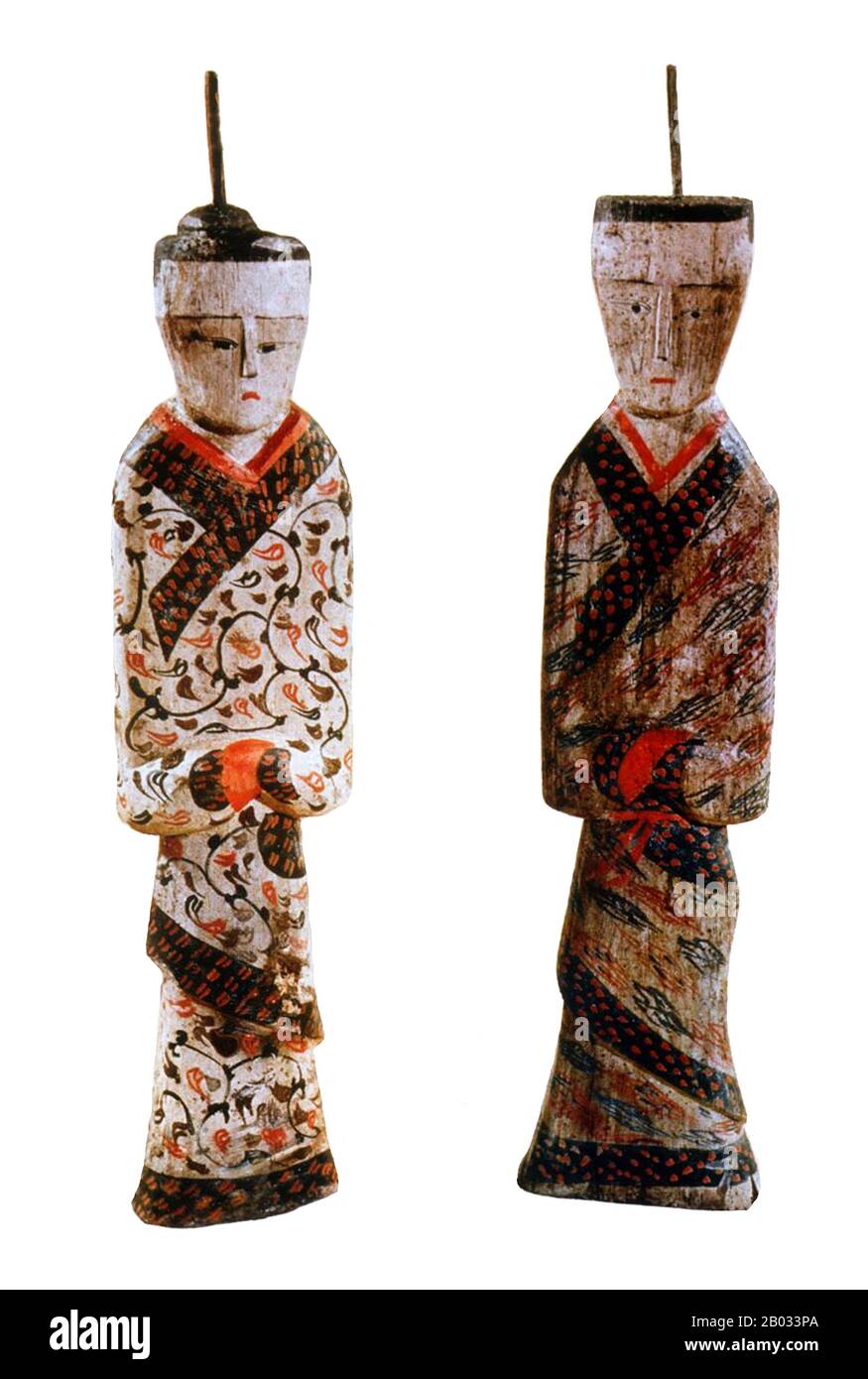 Xin Zhui (died 163 BCE), also known as Lady Dai or Marquise of Dai, was the wife of Li Cang, the Marquis of Dai, during the Han Dynasty (206 BCE – 220 CE). She gained fame more than 2,000 years after her death, when her tomb was discovered inside a hill known as Mawangdui, in Changsha, Hunan, China. After opening the tomb, workers discovered her exceptionally preserved remains alongside hundreds of valuable artifacts and documents. Her body and belongings are currently under the care of the Hunan Provincial Museum, which has allowed occasional international exhibits. Stock Photohttps://www.alamy.com/image-license-details/?v=1https://www.alamy.com/xin-zhui-died-163-bce-also-known-as-lady-dai-or-marquise-of-dai-was-the-wife-of-li-cang-the-marquis-of-dai-during-the-han-dynasty-206-bce-220-ce-she-gained-fame-more-than-2000-years-after-her-death-when-her-tomb-was-discovered-inside-a-hill-known-as-mawangdui-in-changsha-hunan-china-after-opening-the-tomb-workers-discovered-her-exceptionally-preserved-remains-alongside-hundreds-of-valuable-artifacts-and-documents-her-body-and-belongings-are-currently-under-the-care-of-the-hunan-provincial-museum-which-has-allowed-occasional-international-exhibits-image344276194.html
Xin Zhui (died 163 BCE), also known as Lady Dai or Marquise of Dai, was the wife of Li Cang, the Marquis of Dai, during the Han Dynasty (206 BCE – 220 CE). She gained fame more than 2,000 years after her death, when her tomb was discovered inside a hill known as Mawangdui, in Changsha, Hunan, China. After opening the tomb, workers discovered her exceptionally preserved remains alongside hundreds of valuable artifacts and documents. Her body and belongings are currently under the care of the Hunan Provincial Museum, which has allowed occasional international exhibits. Stock Photohttps://www.alamy.com/image-license-details/?v=1https://www.alamy.com/xin-zhui-died-163-bce-also-known-as-lady-dai-or-marquise-of-dai-was-the-wife-of-li-cang-the-marquis-of-dai-during-the-han-dynasty-206-bce-220-ce-she-gained-fame-more-than-2000-years-after-her-death-when-her-tomb-was-discovered-inside-a-hill-known-as-mawangdui-in-changsha-hunan-china-after-opening-the-tomb-workers-discovered-her-exceptionally-preserved-remains-alongside-hundreds-of-valuable-artifacts-and-documents-her-body-and-belongings-are-currently-under-the-care-of-the-hunan-provincial-museum-which-has-allowed-occasional-international-exhibits-image344276194.htmlRM2B033PA–Xin Zhui (died 163 BCE), also known as Lady Dai or Marquise of Dai, was the wife of Li Cang, the Marquis of Dai, during the Han Dynasty (206 BCE – 220 CE). She gained fame more than 2,000 years after her death, when her tomb was discovered inside a hill known as Mawangdui, in Changsha, Hunan, China. After opening the tomb, workers discovered her exceptionally preserved remains alongside hundreds of valuable artifacts and documents. Her body and belongings are currently under the care of the Hunan Provincial Museum, which has allowed occasional international exhibits.
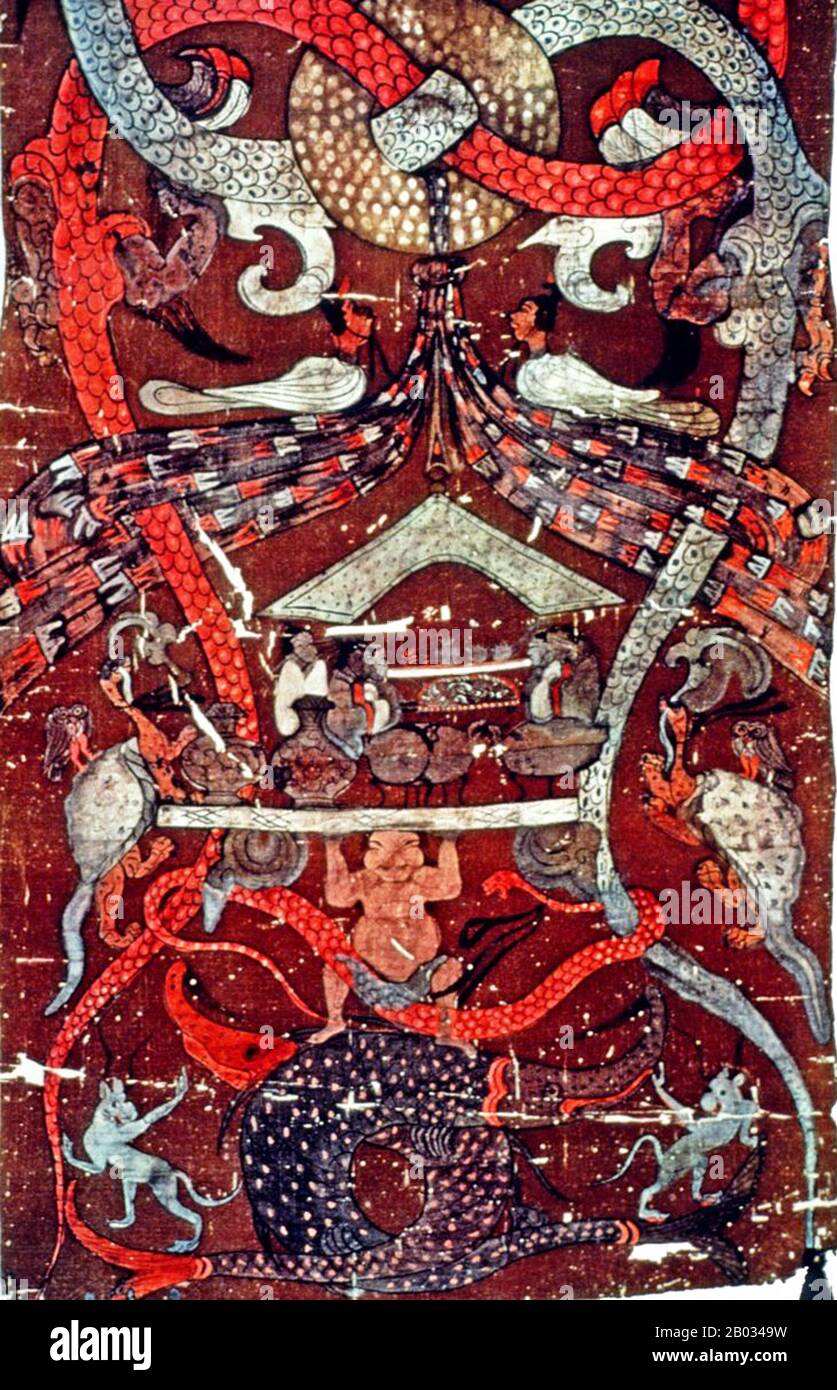 Xin Zhui (died 163 BCE), also known as Lady Dai or Marquise of Dai, was the wife of Li Cang, the Marquis of Dai, during the Han Dynasty (206 BCE – 220 CE). She gained fame more than 2,000 years after her death, when her tomb was discovered inside a hill known as Mawangdui, in Changsha, Hunan, China. After opening the tomb, workers discovered her exceptionally preserved remains alongside hundreds of valuable artifacts and documents. Her body and belongings are currently under the care of the Hunan Provincial Museum, which has allowed occasional international exhibits. Stock Photohttps://www.alamy.com/image-license-details/?v=1https://www.alamy.com/xin-zhui-died-163-bce-also-known-as-lady-dai-or-marquise-of-dai-was-the-wife-of-li-cang-the-marquis-of-dai-during-the-han-dynasty-206-bce-220-ce-she-gained-fame-more-than-2000-years-after-her-death-when-her-tomb-was-discovered-inside-a-hill-known-as-mawangdui-in-changsha-hunan-china-after-opening-the-tomb-workers-discovered-her-exceptionally-preserved-remains-alongside-hundreds-of-valuable-artifacts-and-documents-her-body-and-belongings-are-currently-under-the-care-of-the-hunan-provincial-museum-which-has-allowed-occasional-international-exhibits-image344276629.html
Xin Zhui (died 163 BCE), also known as Lady Dai or Marquise of Dai, was the wife of Li Cang, the Marquis of Dai, during the Han Dynasty (206 BCE – 220 CE). She gained fame more than 2,000 years after her death, when her tomb was discovered inside a hill known as Mawangdui, in Changsha, Hunan, China. After opening the tomb, workers discovered her exceptionally preserved remains alongside hundreds of valuable artifacts and documents. Her body and belongings are currently under the care of the Hunan Provincial Museum, which has allowed occasional international exhibits. Stock Photohttps://www.alamy.com/image-license-details/?v=1https://www.alamy.com/xin-zhui-died-163-bce-also-known-as-lady-dai-or-marquise-of-dai-was-the-wife-of-li-cang-the-marquis-of-dai-during-the-han-dynasty-206-bce-220-ce-she-gained-fame-more-than-2000-years-after-her-death-when-her-tomb-was-discovered-inside-a-hill-known-as-mawangdui-in-changsha-hunan-china-after-opening-the-tomb-workers-discovered-her-exceptionally-preserved-remains-alongside-hundreds-of-valuable-artifacts-and-documents-her-body-and-belongings-are-currently-under-the-care-of-the-hunan-provincial-museum-which-has-allowed-occasional-international-exhibits-image344276629.htmlRM2B0349W–Xin Zhui (died 163 BCE), also known as Lady Dai or Marquise of Dai, was the wife of Li Cang, the Marquis of Dai, during the Han Dynasty (206 BCE – 220 CE). She gained fame more than 2,000 years after her death, when her tomb was discovered inside a hill known as Mawangdui, in Changsha, Hunan, China. After opening the tomb, workers discovered her exceptionally preserved remains alongside hundreds of valuable artifacts and documents. Her body and belongings are currently under the care of the Hunan Provincial Museum, which has allowed occasional international exhibits.
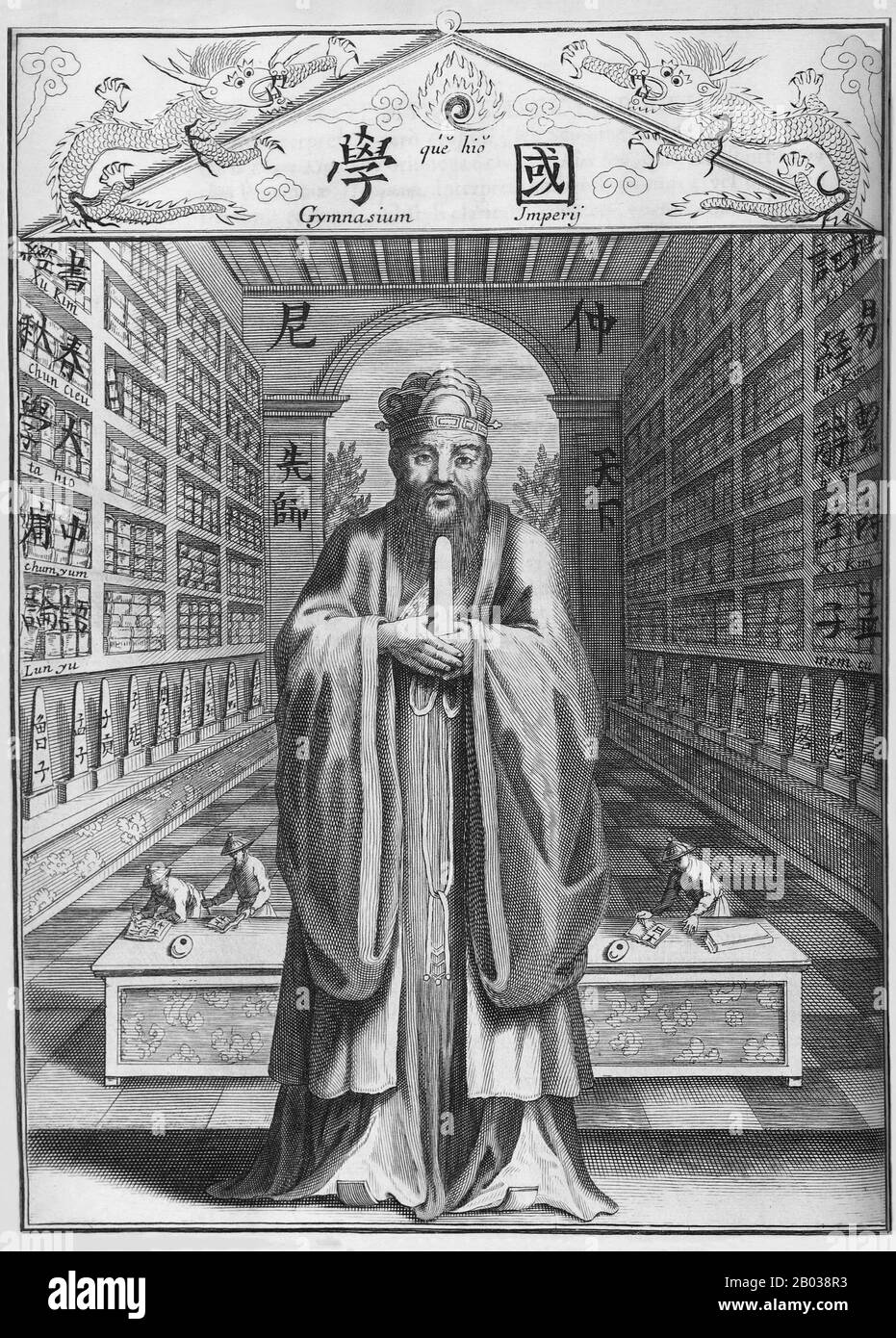 The philosophy of Confucius emphasises personal and governmental morality, correctness of social relationships, justice and sincerity. These values gained prominence in China during the Han Dynasty (206 BCE – 220 CE). Confucius' thoughts have been developed into a system of philosophy known as Confucianism. It was introduced to Europe by the Italian Jesuit Matteo Ricci, who was the first to Latinise the name as 'Confucius'. His teachings may be found in the Analects of Confucius, a collection of brief aphoristic fragments, which was compiled many years after his death. Stock Photohttps://www.alamy.com/image-license-details/?v=1https://www.alamy.com/the-philosophy-of-confucius-emphasises-personal-and-governmental-morality-correctness-of-social-relationships-justice-and-sincerity-these-values-gained-prominence-in-china-during-the-han-dynasty-206-bce-220-ce-confucius-thoughts-have-been-developed-into-a-system-of-philosophy-known-as-confucianism-it-was-introduced-to-europe-by-the-italian-jesuit-matteo-ricci-who-was-the-first-to-latinise-the-name-as-confucius-his-teachings-may-be-found-in-the-analects-of-confucius-a-collection-of-brief-aphoristic-fragments-which-was-compiled-many-years-after-his-death-image344280135.html
The philosophy of Confucius emphasises personal and governmental morality, correctness of social relationships, justice and sincerity. These values gained prominence in China during the Han Dynasty (206 BCE – 220 CE). Confucius' thoughts have been developed into a system of philosophy known as Confucianism. It was introduced to Europe by the Italian Jesuit Matteo Ricci, who was the first to Latinise the name as 'Confucius'. His teachings may be found in the Analects of Confucius, a collection of brief aphoristic fragments, which was compiled many years after his death. Stock Photohttps://www.alamy.com/image-license-details/?v=1https://www.alamy.com/the-philosophy-of-confucius-emphasises-personal-and-governmental-morality-correctness-of-social-relationships-justice-and-sincerity-these-values-gained-prominence-in-china-during-the-han-dynasty-206-bce-220-ce-confucius-thoughts-have-been-developed-into-a-system-of-philosophy-known-as-confucianism-it-was-introduced-to-europe-by-the-italian-jesuit-matteo-ricci-who-was-the-first-to-latinise-the-name-as-confucius-his-teachings-may-be-found-in-the-analects-of-confucius-a-collection-of-brief-aphoristic-fragments-which-was-compiled-many-years-after-his-death-image344280135.htmlRM2B038R3–The philosophy of Confucius emphasises personal and governmental morality, correctness of social relationships, justice and sincerity. These values gained prominence in China during the Han Dynasty (206 BCE – 220 CE). Confucius' thoughts have been developed into a system of philosophy known as Confucianism. It was introduced to Europe by the Italian Jesuit Matteo Ricci, who was the first to Latinise the name as 'Confucius'. His teachings may be found in the Analects of Confucius, a collection of brief aphoristic fragments, which was compiled many years after his death.
 The philosophy of Confucius emphasises personal and governmental morality, correctness of social relationships, justice and sincerity. These values gained prominence in China during the Han Dynasty (206 BCE – 220 CE). Confucius' thoughts have been developed into a system of philosophy known as Confucianism. It was introduced to Europe by the Italian Jesuit Matteo Ricci, who was the first to Latinise the name as 'Confucius'. His teachings may be found in the Analects of Confucius, a collection of brief aphoristic fragments, which was compiled many years after his death. Stock Photohttps://www.alamy.com/image-license-details/?v=1https://www.alamy.com/the-philosophy-of-confucius-emphasises-personal-and-governmental-morality-correctness-of-social-relationships-justice-and-sincerity-these-values-gained-prominence-in-china-during-the-han-dynasty-206-bce-220-ce-confucius-thoughts-have-been-developed-into-a-system-of-philosophy-known-as-confucianism-it-was-introduced-to-europe-by-the-italian-jesuit-matteo-ricci-who-was-the-first-to-latinise-the-name-as-confucius-his-teachings-may-be-found-in-the-analects-of-confucius-a-collection-of-brief-aphoristic-fragments-which-was-compiled-many-years-after-his-death-image344279611.html
The philosophy of Confucius emphasises personal and governmental morality, correctness of social relationships, justice and sincerity. These values gained prominence in China during the Han Dynasty (206 BCE – 220 CE). Confucius' thoughts have been developed into a system of philosophy known as Confucianism. It was introduced to Europe by the Italian Jesuit Matteo Ricci, who was the first to Latinise the name as 'Confucius'. His teachings may be found in the Analects of Confucius, a collection of brief aphoristic fragments, which was compiled many years after his death. Stock Photohttps://www.alamy.com/image-license-details/?v=1https://www.alamy.com/the-philosophy-of-confucius-emphasises-personal-and-governmental-morality-correctness-of-social-relationships-justice-and-sincerity-these-values-gained-prominence-in-china-during-the-han-dynasty-206-bce-220-ce-confucius-thoughts-have-been-developed-into-a-system-of-philosophy-known-as-confucianism-it-was-introduced-to-europe-by-the-italian-jesuit-matteo-ricci-who-was-the-first-to-latinise-the-name-as-confucius-his-teachings-may-be-found-in-the-analects-of-confucius-a-collection-of-brief-aphoristic-fragments-which-was-compiled-many-years-after-his-death-image344279611.htmlRM2B0384B–The philosophy of Confucius emphasises personal and governmental morality, correctness of social relationships, justice and sincerity. These values gained prominence in China during the Han Dynasty (206 BCE – 220 CE). Confucius' thoughts have been developed into a system of philosophy known as Confucianism. It was introduced to Europe by the Italian Jesuit Matteo Ricci, who was the first to Latinise the name as 'Confucius'. His teachings may be found in the Analects of Confucius, a collection of brief aphoristic fragments, which was compiled many years after his death.
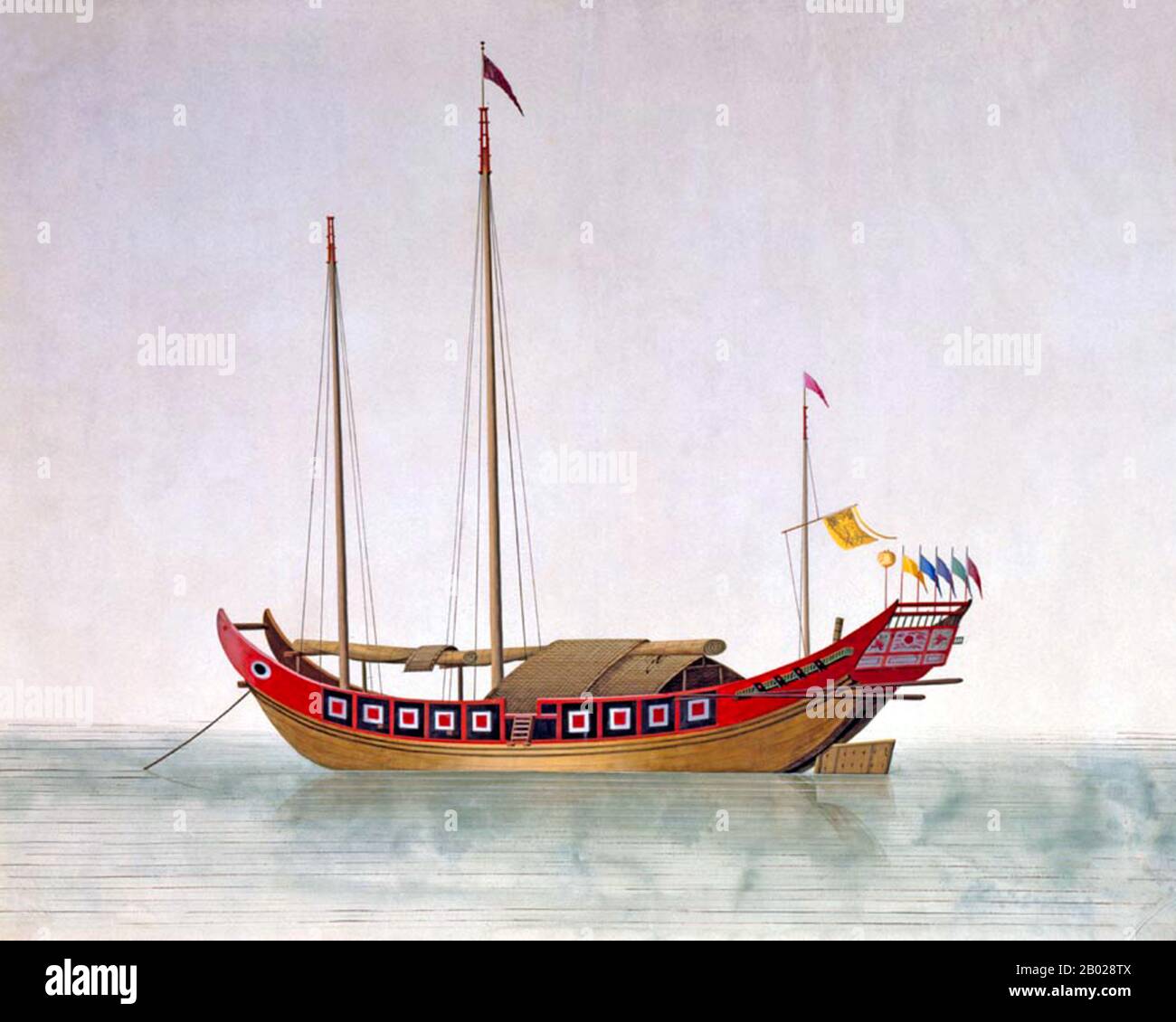 A junk is an ancient Chinese sailing vessel design still in use today. Junks were developed during the Han Dynasty (206 BCE – 220 CE) and were used as sea-going vessels as early as the 2nd century CE. They evolved in the later dynasties, and were used throughout Asia for extensive ocean voyages. They were found, and in lesser numbers are still found, throughout South-East Asia and India, but primarily in China, perhaps most famously in Hong Kong. Stock Photohttps://www.alamy.com/image-license-details/?v=1https://www.alamy.com/a-junk-is-an-ancient-chinese-sailing-vessel-design-still-in-use-today-junks-were-developed-during-the-han-dynasty-206-bce-220-ce-and-were-used-as-sea-going-vessels-as-early-as-the-2nd-century-ce-they-evolved-in-the-later-dynasties-and-were-used-throughout-asia-for-extensive-ocean-voyages-they-were-found-and-in-lesser-numbers-are-still-found-throughout-south-east-asia-and-india-but-primarily-in-china-perhaps-most-famously-in-hong-kong-image344258234.html
A junk is an ancient Chinese sailing vessel design still in use today. Junks were developed during the Han Dynasty (206 BCE – 220 CE) and were used as sea-going vessels as early as the 2nd century CE. They evolved in the later dynasties, and were used throughout Asia for extensive ocean voyages. They were found, and in lesser numbers are still found, throughout South-East Asia and India, but primarily in China, perhaps most famously in Hong Kong. Stock Photohttps://www.alamy.com/image-license-details/?v=1https://www.alamy.com/a-junk-is-an-ancient-chinese-sailing-vessel-design-still-in-use-today-junks-were-developed-during-the-han-dynasty-206-bce-220-ce-and-were-used-as-sea-going-vessels-as-early-as-the-2nd-century-ce-they-evolved-in-the-later-dynasties-and-were-used-throughout-asia-for-extensive-ocean-voyages-they-were-found-and-in-lesser-numbers-are-still-found-throughout-south-east-asia-and-india-but-primarily-in-china-perhaps-most-famously-in-hong-kong-image344258234.htmlRM2B028TX–A junk is an ancient Chinese sailing vessel design still in use today. Junks were developed during the Han Dynasty (206 BCE – 220 CE) and were used as sea-going vessels as early as the 2nd century CE. They evolved in the later dynasties, and were used throughout Asia for extensive ocean voyages. They were found, and in lesser numbers are still found, throughout South-East Asia and India, but primarily in China, perhaps most famously in Hong Kong.
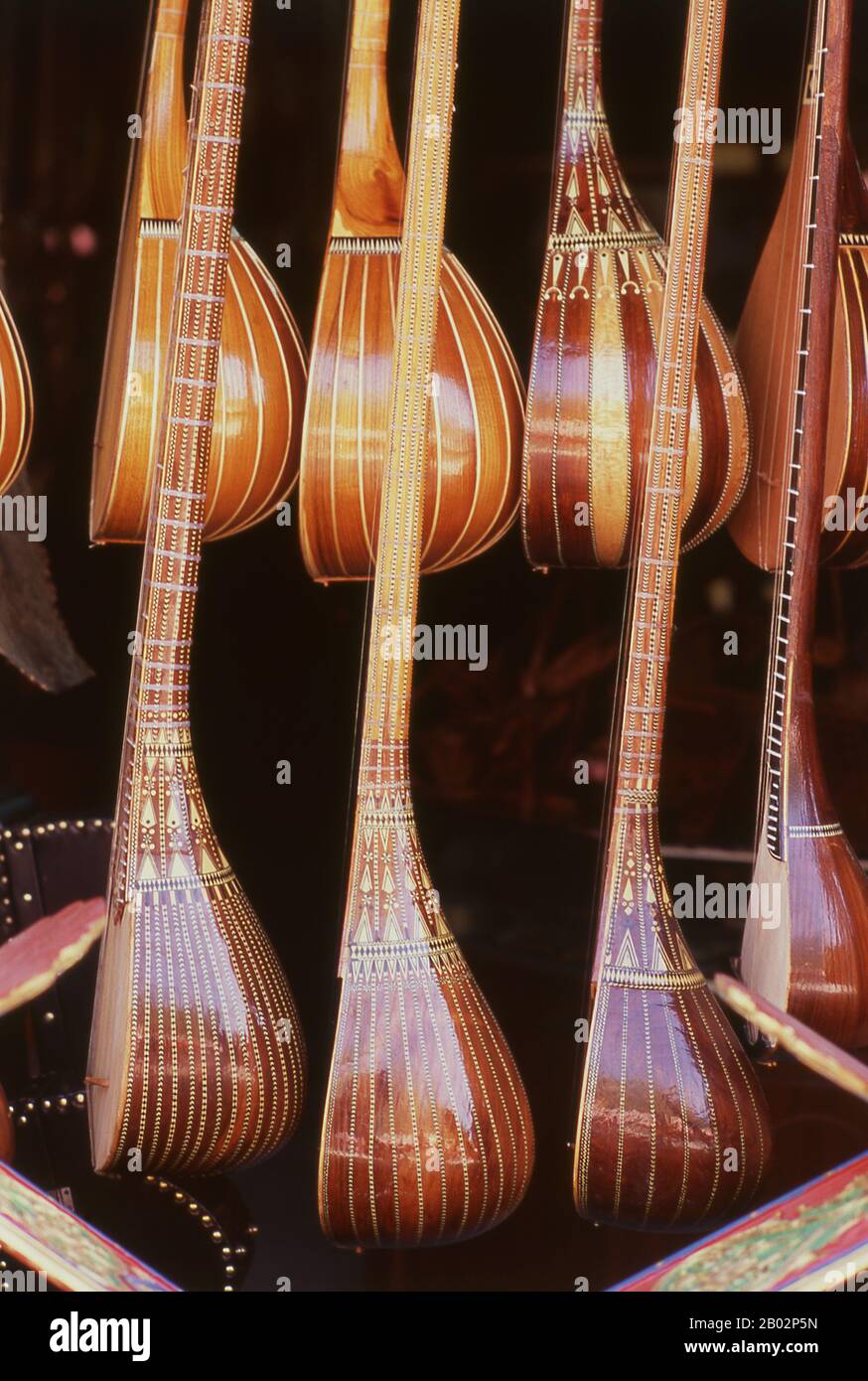 The dutar (also dotar or doutar) is a traditional long-necked two-stringed lute found in Iran and Central Asia. When played, the strings are usually plucked by the Uighurs of Western China and strummed and plucked by the Tajiks, Turkmen, and Uzbeks. The earliest mention of Kashgar occurs when a Chinese Han Dynasty (206 BCE – 220 CE) envoy traveled the Northern Silk Road to explore lands to the west. Another early mention of Kashgar is during the Former Han (also known as the Western Han Dynasty), when in 76 BCE the Chinese conquered the Xiongnu, Yutian (Khotan), Sulei (Kashgar), and a group Stock Photohttps://www.alamy.com/image-license-details/?v=1https://www.alamy.com/the-dutar-also-dotar-or-doutar-is-a-traditional-long-necked-two-stringed-lute-found-in-iran-and-central-asia-when-played-the-strings-are-usually-plucked-by-the-uighurs-of-western-china-and-strummed-and-plucked-by-the-tajiks-turkmen-and-uzbeks-the-earliest-mention-of-kashgar-occurs-when-a-chinese-han-dynasty-206-bce-220-ce-envoy-traveled-the-northern-silk-road-to-explore-lands-to-the-west-another-early-mention-of-kashgar-is-during-the-former-han-also-known-as-the-western-han-dynasty-when-in-76-bce-the-chinese-conquered-the-xiongnu-yutian-khotan-sulei-kashgar-and-a-group-image344268673.html
The dutar (also dotar or doutar) is a traditional long-necked two-stringed lute found in Iran and Central Asia. When played, the strings are usually plucked by the Uighurs of Western China and strummed and plucked by the Tajiks, Turkmen, and Uzbeks. The earliest mention of Kashgar occurs when a Chinese Han Dynasty (206 BCE – 220 CE) envoy traveled the Northern Silk Road to explore lands to the west. Another early mention of Kashgar is during the Former Han (also known as the Western Han Dynasty), when in 76 BCE the Chinese conquered the Xiongnu, Yutian (Khotan), Sulei (Kashgar), and a group Stock Photohttps://www.alamy.com/image-license-details/?v=1https://www.alamy.com/the-dutar-also-dotar-or-doutar-is-a-traditional-long-necked-two-stringed-lute-found-in-iran-and-central-asia-when-played-the-strings-are-usually-plucked-by-the-uighurs-of-western-china-and-strummed-and-plucked-by-the-tajiks-turkmen-and-uzbeks-the-earliest-mention-of-kashgar-occurs-when-a-chinese-han-dynasty-206-bce-220-ce-envoy-traveled-the-northern-silk-road-to-explore-lands-to-the-west-another-early-mention-of-kashgar-is-during-the-former-han-also-known-as-the-western-han-dynasty-when-in-76-bce-the-chinese-conquered-the-xiongnu-yutian-khotan-sulei-kashgar-and-a-group-image344268673.htmlRM2B02P5N–The dutar (also dotar or doutar) is a traditional long-necked two-stringed lute found in Iran and Central Asia. When played, the strings are usually plucked by the Uighurs of Western China and strummed and plucked by the Tajiks, Turkmen, and Uzbeks. The earliest mention of Kashgar occurs when a Chinese Han Dynasty (206 BCE – 220 CE) envoy traveled the Northern Silk Road to explore lands to the west. Another early mention of Kashgar is during the Former Han (also known as the Western Han Dynasty), when in 76 BCE the Chinese conquered the Xiongnu, Yutian (Khotan), Sulei (Kashgar), and a group
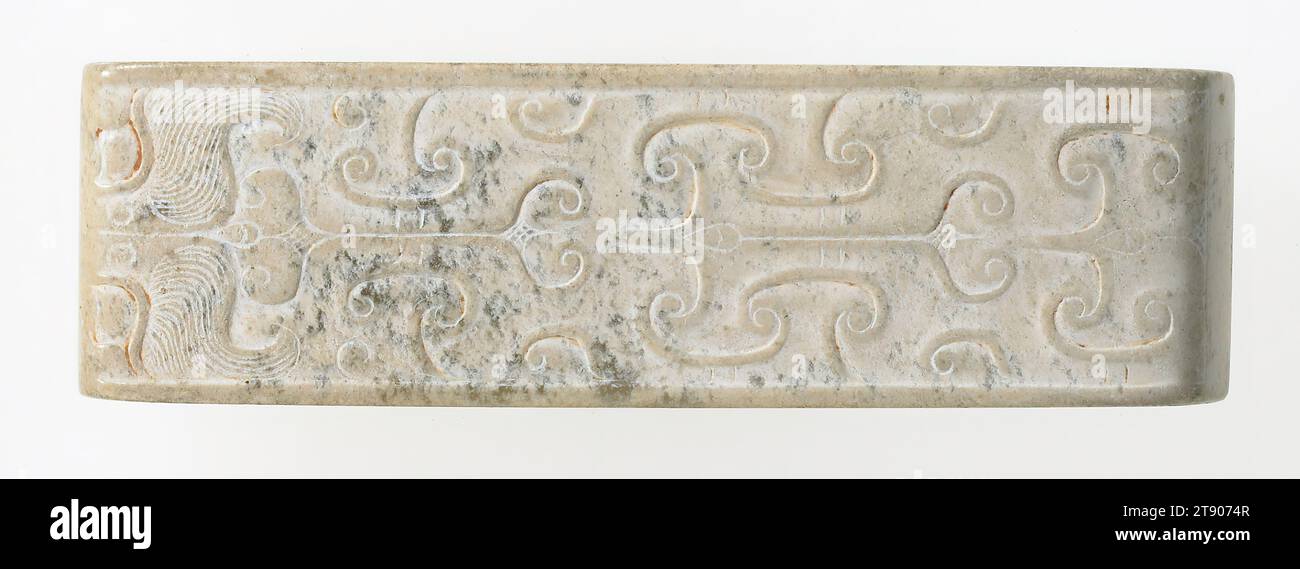 Wei Scabbard Buckle, 206 BCE - 220 CE, 3 7/16 x 1 x 1/2 in. (8.73 x 2.54 x 1.27 cm), Ivory jade with brown clouds, China, 3rd century BCE - 3rd century CE Stock Photohttps://www.alamy.com/image-license-details/?v=1https://www.alamy.com/wei-scabbard-buckle-206-bce-220-ce-3-716-x-1-x-12-in-873-x-254-x-127-cm-ivory-jade-with-brown-clouds-china-3rd-century-bce-3rd-century-ce-image573479671.html
Wei Scabbard Buckle, 206 BCE - 220 CE, 3 7/16 x 1 x 1/2 in. (8.73 x 2.54 x 1.27 cm), Ivory jade with brown clouds, China, 3rd century BCE - 3rd century CE Stock Photohttps://www.alamy.com/image-license-details/?v=1https://www.alamy.com/wei-scabbard-buckle-206-bce-220-ce-3-716-x-1-x-12-in-873-x-254-x-127-cm-ivory-jade-with-brown-clouds-china-3rd-century-bce-3rd-century-ce-image573479671.htmlRM2T9074R–Wei Scabbard Buckle, 206 BCE - 220 CE, 3 7/16 x 1 x 1/2 in. (8.73 x 2.54 x 1.27 cm), Ivory jade with brown clouds, China, 3rd century BCE - 3rd century CE
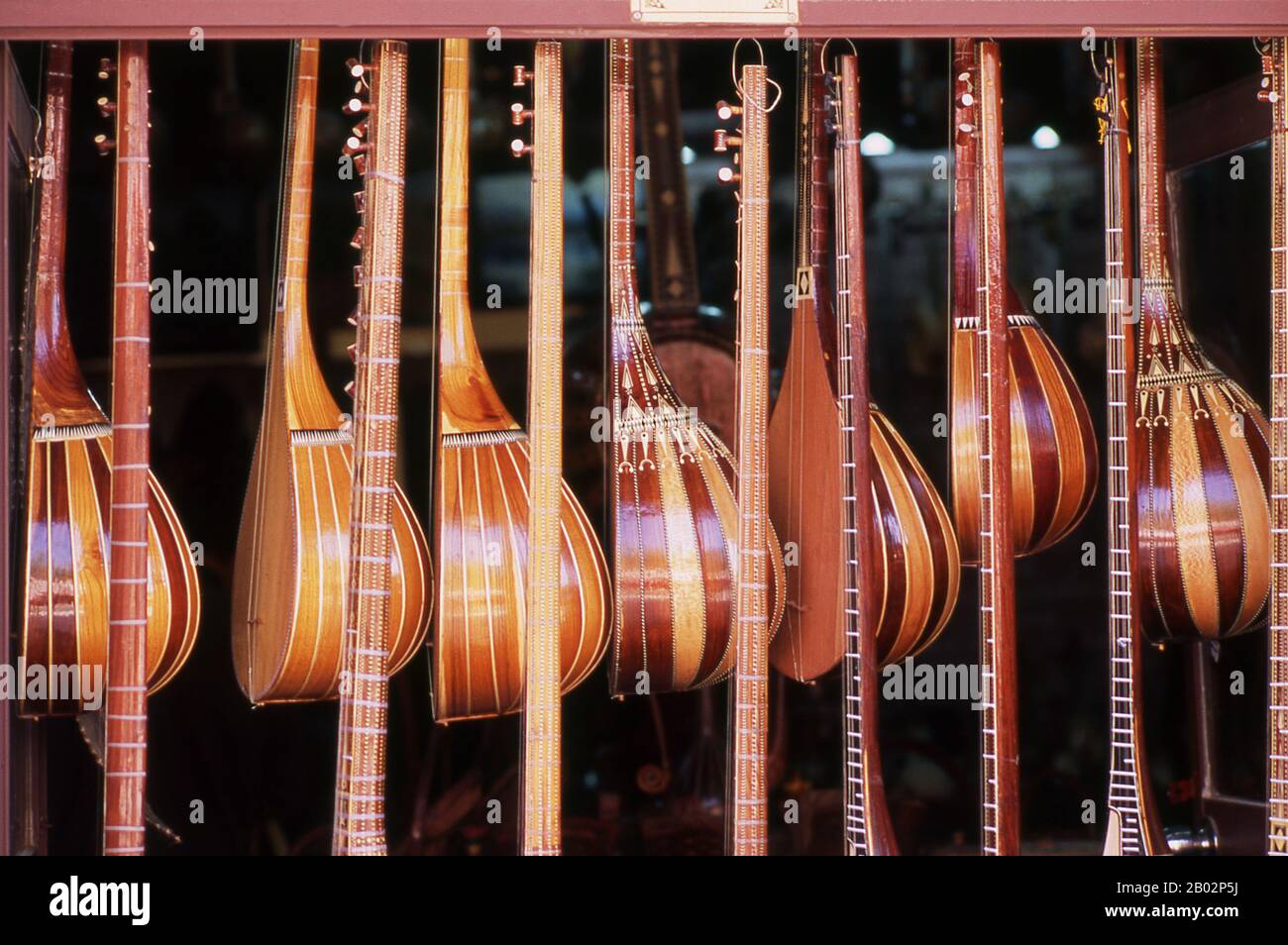 The dutar (also dotar or doutar) is a traditional long-necked two-stringed lute found in Iran and Central Asia. When played, the strings are usually plucked by the Uighurs of Western China and strummed and plucked by the Tajiks, Turkmen, and Uzbeks. The earliest mention of Kashgar occurs when a Chinese Han Dynasty (206 BCE – 220 CE) envoy traveled the Northern Silk Road to explore lands to the west. Another early mention of Kashgar is during the Former Han (also known as the Western Han Dynasty), when in 76 BCE the Chinese conquered the Xiongnu, Yutian (Khotan), Sulei (Kashgar), and a group Stock Photohttps://www.alamy.com/image-license-details/?v=1https://www.alamy.com/the-dutar-also-dotar-or-doutar-is-a-traditional-long-necked-two-stringed-lute-found-in-iran-and-central-asia-when-played-the-strings-are-usually-plucked-by-the-uighurs-of-western-china-and-strummed-and-plucked-by-the-tajiks-turkmen-and-uzbeks-the-earliest-mention-of-kashgar-occurs-when-a-chinese-han-dynasty-206-bce-220-ce-envoy-traveled-the-northern-silk-road-to-explore-lands-to-the-west-another-early-mention-of-kashgar-is-during-the-former-han-also-known-as-the-western-han-dynasty-when-in-76-bce-the-chinese-conquered-the-xiongnu-yutian-khotan-sulei-kashgar-and-a-group-image344268670.html
The dutar (also dotar or doutar) is a traditional long-necked two-stringed lute found in Iran and Central Asia. When played, the strings are usually plucked by the Uighurs of Western China and strummed and plucked by the Tajiks, Turkmen, and Uzbeks. The earliest mention of Kashgar occurs when a Chinese Han Dynasty (206 BCE – 220 CE) envoy traveled the Northern Silk Road to explore lands to the west. Another early mention of Kashgar is during the Former Han (also known as the Western Han Dynasty), when in 76 BCE the Chinese conquered the Xiongnu, Yutian (Khotan), Sulei (Kashgar), and a group Stock Photohttps://www.alamy.com/image-license-details/?v=1https://www.alamy.com/the-dutar-also-dotar-or-doutar-is-a-traditional-long-necked-two-stringed-lute-found-in-iran-and-central-asia-when-played-the-strings-are-usually-plucked-by-the-uighurs-of-western-china-and-strummed-and-plucked-by-the-tajiks-turkmen-and-uzbeks-the-earliest-mention-of-kashgar-occurs-when-a-chinese-han-dynasty-206-bce-220-ce-envoy-traveled-the-northern-silk-road-to-explore-lands-to-the-west-another-early-mention-of-kashgar-is-during-the-former-han-also-known-as-the-western-han-dynasty-when-in-76-bce-the-chinese-conquered-the-xiongnu-yutian-khotan-sulei-kashgar-and-a-group-image344268670.htmlRM2B02P5J–The dutar (also dotar or doutar) is a traditional long-necked two-stringed lute found in Iran and Central Asia. When played, the strings are usually plucked by the Uighurs of Western China and strummed and plucked by the Tajiks, Turkmen, and Uzbeks. The earliest mention of Kashgar occurs when a Chinese Han Dynasty (206 BCE – 220 CE) envoy traveled the Northern Silk Road to explore lands to the west. Another early mention of Kashgar is during the Former Han (also known as the Western Han Dynasty), when in 76 BCE the Chinese conquered the Xiongnu, Yutian (Khotan), Sulei (Kashgar), and a group
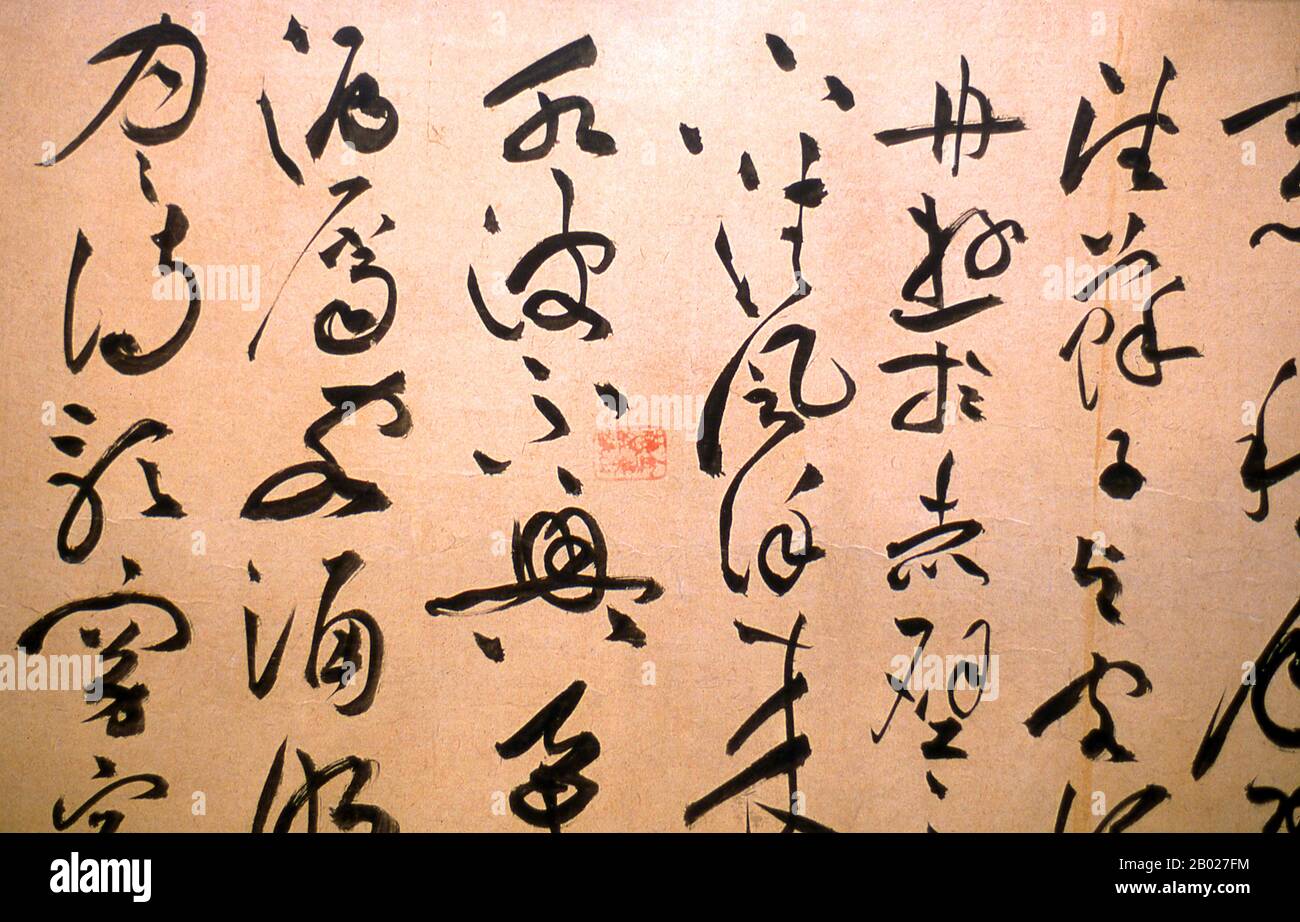 Cursive script (simplified Chinese: 草书; traditional Chinese: 草書; pinyin: cǎoshū) is a style of Chinese calligraphy. Cursive script is faster to write than other styles, but difficult to read for those unfamiliar with it. It functions primarily as a kind of shorthand script or calligraphic style. Cursive script originated in China during the Han dynasty (206 BCE - 220 CE) through the Jin Dynasty period (266 - 420 CE), in two phases. First, an early form of cursive developed as a cursory way to write the popular and not yet mature clerical script. Faster ways to write characters developed throu Stock Photohttps://www.alamy.com/image-license-details/?v=1https://www.alamy.com/cursive-script-simplified-chinese-traditional-chinese-pinyin-cosh-is-a-style-of-chinese-calligraphy-cursive-script-is-faster-to-write-than-other-styles-but-difficult-to-read-for-those-unfamiliar-with-it-it-functions-primarily-as-a-kind-of-shorthand-script-or-calligraphic-style-cursive-script-originated-in-china-during-the-han-dynasty-206-bce-220-ce-through-the-jin-dynasty-period-266-420-ce-in-two-phases-first-an-early-form-of-cursive-developed-as-a-cursory-way-to-write-the-popular-and-not-yet-mature-clerical-script-faster-ways-to-write-characters-developed-throu-image344257192.html
Cursive script (simplified Chinese: 草书; traditional Chinese: 草書; pinyin: cǎoshū) is a style of Chinese calligraphy. Cursive script is faster to write than other styles, but difficult to read for those unfamiliar with it. It functions primarily as a kind of shorthand script or calligraphic style. Cursive script originated in China during the Han dynasty (206 BCE - 220 CE) through the Jin Dynasty period (266 - 420 CE), in two phases. First, an early form of cursive developed as a cursory way to write the popular and not yet mature clerical script. Faster ways to write characters developed throu Stock Photohttps://www.alamy.com/image-license-details/?v=1https://www.alamy.com/cursive-script-simplified-chinese-traditional-chinese-pinyin-cosh-is-a-style-of-chinese-calligraphy-cursive-script-is-faster-to-write-than-other-styles-but-difficult-to-read-for-those-unfamiliar-with-it-it-functions-primarily-as-a-kind-of-shorthand-script-or-calligraphic-style-cursive-script-originated-in-china-during-the-han-dynasty-206-bce-220-ce-through-the-jin-dynasty-period-266-420-ce-in-two-phases-first-an-early-form-of-cursive-developed-as-a-cursory-way-to-write-the-popular-and-not-yet-mature-clerical-script-faster-ways-to-write-characters-developed-throu-image344257192.htmlRM2B027FM–Cursive script (simplified Chinese: 草书; traditional Chinese: 草書; pinyin: cǎoshū) is a style of Chinese calligraphy. Cursive script is faster to write than other styles, but difficult to read for those unfamiliar with it. It functions primarily as a kind of shorthand script or calligraphic style. Cursive script originated in China during the Han dynasty (206 BCE - 220 CE) through the Jin Dynasty period (266 - 420 CE), in two phases. First, an early form of cursive developed as a cursory way to write the popular and not yet mature clerical script. Faster ways to write characters developed throu
 Pendant in the form of a Dragon, 206 BCE - 220 CE, 4 3/4 x 5 7/8 x 3/8 in. (12.1 x 14.9 x 0.9 cm), Jade, China, 3rd century BCE - 3rd century CE Stock Photohttps://www.alamy.com/image-license-details/?v=1https://www.alamy.com/pendant-in-the-form-of-a-dragon-206-bce-220-ce-4-34-x-5-78-x-38-in-121-x-149-x-09-cm-jade-china-3rd-century-bce-3rd-century-ce-image573492922.html
Pendant in the form of a Dragon, 206 BCE - 220 CE, 4 3/4 x 5 7/8 x 3/8 in. (12.1 x 14.9 x 0.9 cm), Jade, China, 3rd century BCE - 3rd century CE Stock Photohttps://www.alamy.com/image-license-details/?v=1https://www.alamy.com/pendant-in-the-form-of-a-dragon-206-bce-220-ce-4-34-x-5-78-x-38-in-121-x-149-x-09-cm-jade-china-3rd-century-bce-3rd-century-ce-image573492922.htmlRM2T90T22–Pendant in the form of a Dragon, 206 BCE - 220 CE, 4 3/4 x 5 7/8 x 3/8 in. (12.1 x 14.9 x 0.9 cm), Jade, China, 3rd century BCE - 3rd century CE
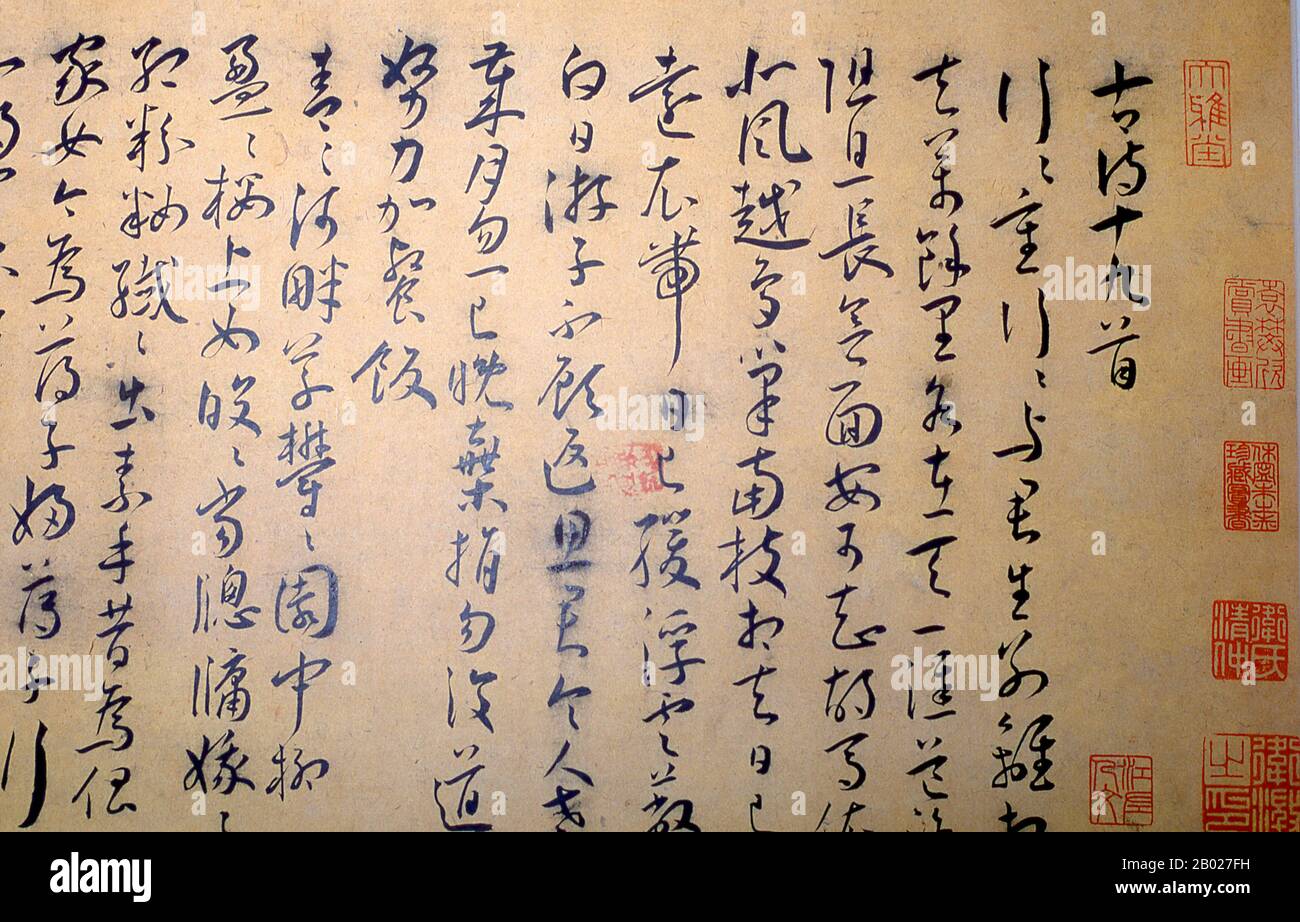 Cursive script (simplified Chinese: 草书; traditional Chinese: 草書; pinyin: cǎoshū) is a style of Chinese calligraphy. Cursive script is faster to write than other styles, but difficult to read for those unfamiliar with it. It functions primarily as a kind of shorthand script or calligraphic style. Cursive script originated in China during the Han dynasty (206 BCE - 220 CE) through the Jin Dynasty period (266 - 420 CE), in two phases. First, an early form of cursive developed as a cursory way to write the popular and not yet mature clerical script. Faster ways to write characters developed throu Stock Photohttps://www.alamy.com/image-license-details/?v=1https://www.alamy.com/cursive-script-simplified-chinese-traditional-chinese-pinyin-cosh-is-a-style-of-chinese-calligraphy-cursive-script-is-faster-to-write-than-other-styles-but-difficult-to-read-for-those-unfamiliar-with-it-it-functions-primarily-as-a-kind-of-shorthand-script-or-calligraphic-style-cursive-script-originated-in-china-during-the-han-dynasty-206-bce-220-ce-through-the-jin-dynasty-period-266-420-ce-in-two-phases-first-an-early-form-of-cursive-developed-as-a-cursory-way-to-write-the-popular-and-not-yet-mature-clerical-script-faster-ways-to-write-characters-developed-throu-image344257189.html
Cursive script (simplified Chinese: 草书; traditional Chinese: 草書; pinyin: cǎoshū) is a style of Chinese calligraphy. Cursive script is faster to write than other styles, but difficult to read for those unfamiliar with it. It functions primarily as a kind of shorthand script or calligraphic style. Cursive script originated in China during the Han dynasty (206 BCE - 220 CE) through the Jin Dynasty period (266 - 420 CE), in two phases. First, an early form of cursive developed as a cursory way to write the popular and not yet mature clerical script. Faster ways to write characters developed throu Stock Photohttps://www.alamy.com/image-license-details/?v=1https://www.alamy.com/cursive-script-simplified-chinese-traditional-chinese-pinyin-cosh-is-a-style-of-chinese-calligraphy-cursive-script-is-faster-to-write-than-other-styles-but-difficult-to-read-for-those-unfamiliar-with-it-it-functions-primarily-as-a-kind-of-shorthand-script-or-calligraphic-style-cursive-script-originated-in-china-during-the-han-dynasty-206-bce-220-ce-through-the-jin-dynasty-period-266-420-ce-in-two-phases-first-an-early-form-of-cursive-developed-as-a-cursory-way-to-write-the-popular-and-not-yet-mature-clerical-script-faster-ways-to-write-characters-developed-throu-image344257189.htmlRM2B027FH–Cursive script (simplified Chinese: 草书; traditional Chinese: 草書; pinyin: cǎoshū) is a style of Chinese calligraphy. Cursive script is faster to write than other styles, but difficult to read for those unfamiliar with it. It functions primarily as a kind of shorthand script or calligraphic style. Cursive script originated in China during the Han dynasty (206 BCE - 220 CE) through the Jin Dynasty period (266 - 420 CE), in two phases. First, an early form of cursive developed as a cursory way to write the popular and not yet mature clerical script. Faster ways to write characters developed throu
 Cong, 206 BCE - 220 CE, 6 9/16 x 2 1/2 x 3/8 in. (16.67 x 6.35 x 0.95 cm), Brownish tan jade with red veins, China, 3rd century BCE - 3rd century CE Stock Photohttps://www.alamy.com/image-license-details/?v=1https://www.alamy.com/cong-206-bce-220-ce-6-916-x-2-12-x-38-in-1667-x-635-x-095-cm-brownish-tan-jade-with-red-veins-china-3rd-century-bce-3rd-century-ce-image573517333.html
Cong, 206 BCE - 220 CE, 6 9/16 x 2 1/2 x 3/8 in. (16.67 x 6.35 x 0.95 cm), Brownish tan jade with red veins, China, 3rd century BCE - 3rd century CE Stock Photohttps://www.alamy.com/image-license-details/?v=1https://www.alamy.com/cong-206-bce-220-ce-6-916-x-2-12-x-38-in-1667-x-635-x-095-cm-brownish-tan-jade-with-red-veins-china-3rd-century-bce-3rd-century-ce-image573517333.htmlRM2T91Y5W–Cong, 206 BCE - 220 CE, 6 9/16 x 2 1/2 x 3/8 in. (16.67 x 6.35 x 0.95 cm), Brownish tan jade with red veins, China, 3rd century BCE - 3rd century CE
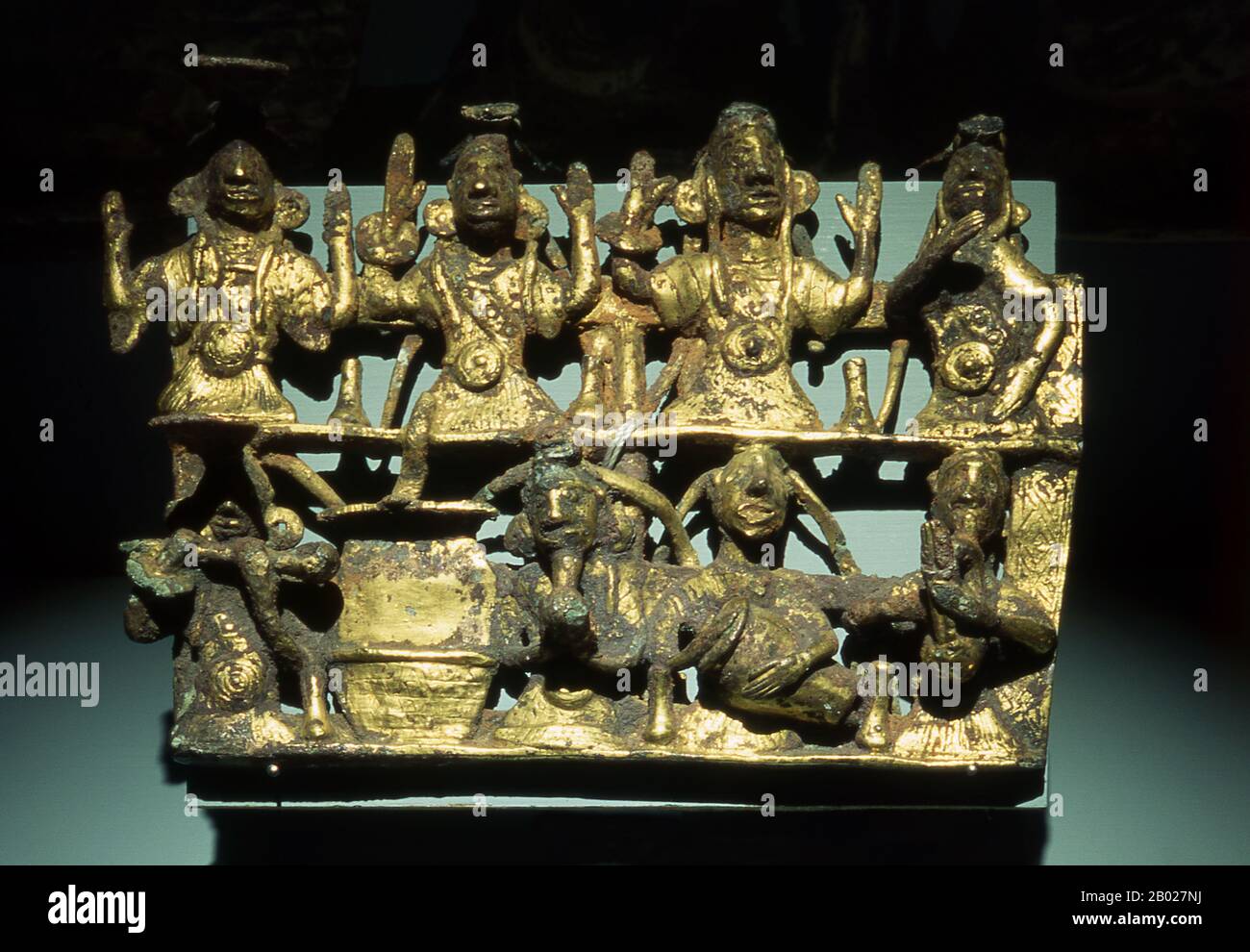 The Dian Kingdom (Chinese: 滇國 or 滇王國) was established by the Dian people, who lived around Lake Dian in northern Yunnan, China from the late Spring and Autumn Period (771 - 476 BCE) until the Eastern Han Dynasty (25 - 220 CE). The Dian were first mentioned historically in Sima Qian's Shiji and according to Chinese sources, the Chinese Chu general Zhuang Qiao was the founder of the Dian Kingdom. Chinese soldiers who accompanied him married the local people. Zhuang was engaged in a war to conquer the 'barbarian' peoples of the area, but he and his army were prevented from going back to Chu by e Stock Photohttps://www.alamy.com/image-license-details/?v=1https://www.alamy.com/the-dian-kingdom-chinese-or-was-established-by-the-dian-people-who-lived-around-lake-dian-in-northern-yunnan-china-from-the-late-spring-and-autumn-period-771-476-bce-until-the-eastern-han-dynasty-25-220-ce-the-dian-were-first-mentioned-historically-in-sima-qians-shiji-and-according-to-chinese-sources-the-chinese-chu-general-zhuang-qiao-was-the-founder-of-the-dian-kingdom-chinese-soldiers-who-accompanied-him-married-the-local-people-zhuang-was-engaged-in-a-war-to-conquer-the-barbarian-peoples-of-the-area-but-he-and-his-army-were-prevented-from-going-back-to-chu-by-e-image344257358.html
The Dian Kingdom (Chinese: 滇國 or 滇王國) was established by the Dian people, who lived around Lake Dian in northern Yunnan, China from the late Spring and Autumn Period (771 - 476 BCE) until the Eastern Han Dynasty (25 - 220 CE). The Dian were first mentioned historically in Sima Qian's Shiji and according to Chinese sources, the Chinese Chu general Zhuang Qiao was the founder of the Dian Kingdom. Chinese soldiers who accompanied him married the local people. Zhuang was engaged in a war to conquer the 'barbarian' peoples of the area, but he and his army were prevented from going back to Chu by e Stock Photohttps://www.alamy.com/image-license-details/?v=1https://www.alamy.com/the-dian-kingdom-chinese-or-was-established-by-the-dian-people-who-lived-around-lake-dian-in-northern-yunnan-china-from-the-late-spring-and-autumn-period-771-476-bce-until-the-eastern-han-dynasty-25-220-ce-the-dian-were-first-mentioned-historically-in-sima-qians-shiji-and-according-to-chinese-sources-the-chinese-chu-general-zhuang-qiao-was-the-founder-of-the-dian-kingdom-chinese-soldiers-who-accompanied-him-married-the-local-people-zhuang-was-engaged-in-a-war-to-conquer-the-barbarian-peoples-of-the-area-but-he-and-his-army-were-prevented-from-going-back-to-chu-by-e-image344257358.htmlRM2B027NJ–The Dian Kingdom (Chinese: 滇國 or 滇王國) was established by the Dian people, who lived around Lake Dian in northern Yunnan, China from the late Spring and Autumn Period (771 - 476 BCE) until the Eastern Han Dynasty (25 - 220 CE). The Dian were first mentioned historically in Sima Qian's Shiji and according to Chinese sources, the Chinese Chu general Zhuang Qiao was the founder of the Dian Kingdom. Chinese soldiers who accompanied him married the local people. Zhuang was engaged in a war to conquer the 'barbarian' peoples of the area, but he and his army were prevented from going back to Chu by e
 Grain Mill, 206 BCE - 220 CE, 2 3/8 x 1 1/8 x 5 7/8 in. (6 x 2.9 x 14.92 cm), Low-fired earthenware with green glaze, China, 3rd century BCE - 3rd century CE Stock Photohttps://www.alamy.com/image-license-details/?v=1https://www.alamy.com/grain-mill-206-bce-220-ce-2-38-x-1-18-x-5-78-in-6-x-29-x-1492-cm-low-fired-earthenware-with-green-glaze-china-3rd-century-bce-3rd-century-ce-image573499412.html
Grain Mill, 206 BCE - 220 CE, 2 3/8 x 1 1/8 x 5 7/8 in. (6 x 2.9 x 14.92 cm), Low-fired earthenware with green glaze, China, 3rd century BCE - 3rd century CE Stock Photohttps://www.alamy.com/image-license-details/?v=1https://www.alamy.com/grain-mill-206-bce-220-ce-2-38-x-1-18-x-5-78-in-6-x-29-x-1492-cm-low-fired-earthenware-with-green-glaze-china-3rd-century-bce-3rd-century-ce-image573499412.htmlRM2T9149T–Grain Mill, 206 BCE - 220 CE, 2 3/8 x 1 1/8 x 5 7/8 in. (6 x 2.9 x 14.92 cm), Low-fired earthenware with green glaze, China, 3rd century BCE - 3rd century CE
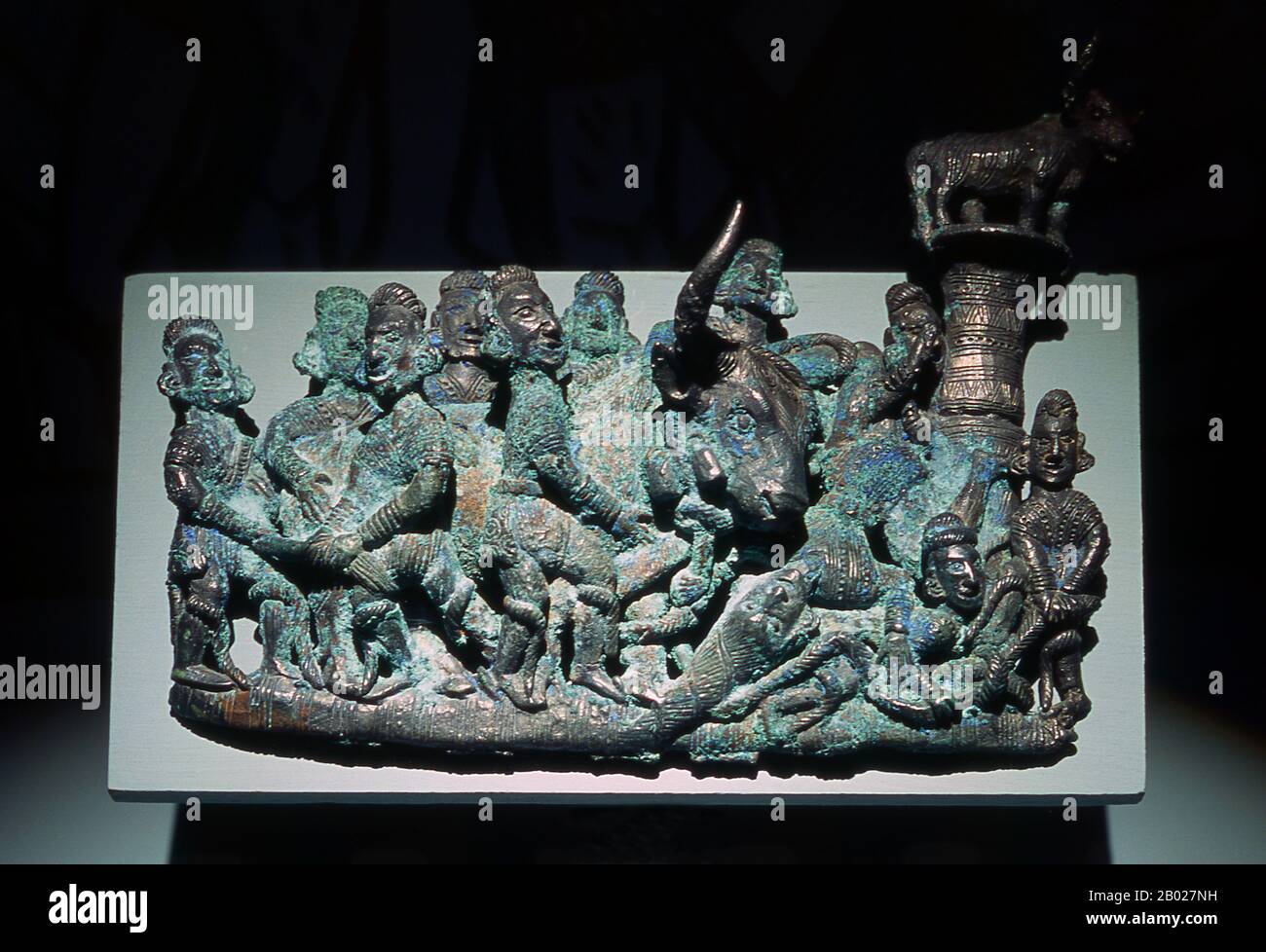 The Dian Kingdom (Chinese: 滇國 or 滇王國) was established by the Dian people, who lived around Lake Dian in northern Yunnan, China from the late Spring and Autumn Period (771 - 476 BCE) until the Eastern Han Dynasty (25 - 220 CE). The Dian were first mentioned historically in Sima Qian's Shiji and according to Chinese sources, the Chinese Chu general Zhuang Qiao was the founder of the Dian Kingdom. Chinese soldiers who accompanied him married the local people. Zhuang was engaged in a war to conquer the 'barbarian' peoples of the area, but he and his army were prevented from going back to Chu by e Stock Photohttps://www.alamy.com/image-license-details/?v=1https://www.alamy.com/the-dian-kingdom-chinese-or-was-established-by-the-dian-people-who-lived-around-lake-dian-in-northern-yunnan-china-from-the-late-spring-and-autumn-period-771-476-bce-until-the-eastern-han-dynasty-25-220-ce-the-dian-were-first-mentioned-historically-in-sima-qians-shiji-and-according-to-chinese-sources-the-chinese-chu-general-zhuang-qiao-was-the-founder-of-the-dian-kingdom-chinese-soldiers-who-accompanied-him-married-the-local-people-zhuang-was-engaged-in-a-war-to-conquer-the-barbarian-peoples-of-the-area-but-he-and-his-army-were-prevented-from-going-back-to-chu-by-e-image344257357.html
The Dian Kingdom (Chinese: 滇國 or 滇王國) was established by the Dian people, who lived around Lake Dian in northern Yunnan, China from the late Spring and Autumn Period (771 - 476 BCE) until the Eastern Han Dynasty (25 - 220 CE). The Dian were first mentioned historically in Sima Qian's Shiji and according to Chinese sources, the Chinese Chu general Zhuang Qiao was the founder of the Dian Kingdom. Chinese soldiers who accompanied him married the local people. Zhuang was engaged in a war to conquer the 'barbarian' peoples of the area, but he and his army were prevented from going back to Chu by e Stock Photohttps://www.alamy.com/image-license-details/?v=1https://www.alamy.com/the-dian-kingdom-chinese-or-was-established-by-the-dian-people-who-lived-around-lake-dian-in-northern-yunnan-china-from-the-late-spring-and-autumn-period-771-476-bce-until-the-eastern-han-dynasty-25-220-ce-the-dian-were-first-mentioned-historically-in-sima-qians-shiji-and-according-to-chinese-sources-the-chinese-chu-general-zhuang-qiao-was-the-founder-of-the-dian-kingdom-chinese-soldiers-who-accompanied-him-married-the-local-people-zhuang-was-engaged-in-a-war-to-conquer-the-barbarian-peoples-of-the-area-but-he-and-his-army-were-prevented-from-going-back-to-chu-by-e-image344257357.htmlRM2B027NH–The Dian Kingdom (Chinese: 滇國 or 滇王國) was established by the Dian people, who lived around Lake Dian in northern Yunnan, China from the late Spring and Autumn Period (771 - 476 BCE) until the Eastern Han Dynasty (25 - 220 CE). The Dian were first mentioned historically in Sima Qian's Shiji and according to Chinese sources, the Chinese Chu general Zhuang Qiao was the founder of the Dian Kingdom. Chinese soldiers who accompanied him married the local people. Zhuang was engaged in a war to conquer the 'barbarian' peoples of the area, but he and his army were prevented from going back to Chu by e
 Belt Hook, 206 BCE- 220 CE, 7 × 13/16 × 15/16 in., 0.2 lb. (17.78 × 2.06 × 2.38 cm, 0.1 kg), Bronze, gold, turquoise, China, 3rd century BCE- 3rd century CE Stock Photohttps://www.alamy.com/image-license-details/?v=1https://www.alamy.com/belt-hook-206-bce-220-ce-7-1316-1516-in-02-lb-1778-206-238-cm-01-kg-bronze-gold-turquoise-china-3rd-century-bce-3rd-century-ce-image573501728.html
Belt Hook, 206 BCE- 220 CE, 7 × 13/16 × 15/16 in., 0.2 lb. (17.78 × 2.06 × 2.38 cm, 0.1 kg), Bronze, gold, turquoise, China, 3rd century BCE- 3rd century CE Stock Photohttps://www.alamy.com/image-license-details/?v=1https://www.alamy.com/belt-hook-206-bce-220-ce-7-1316-1516-in-02-lb-1778-206-238-cm-01-kg-bronze-gold-turquoise-china-3rd-century-bce-3rd-century-ce-image573501728.htmlRM2T9178G–Belt Hook, 206 BCE- 220 CE, 7 × 13/16 × 15/16 in., 0.2 lb. (17.78 × 2.06 × 2.38 cm, 0.1 kg), Bronze, gold, turquoise, China, 3rd century BCE- 3rd century CE
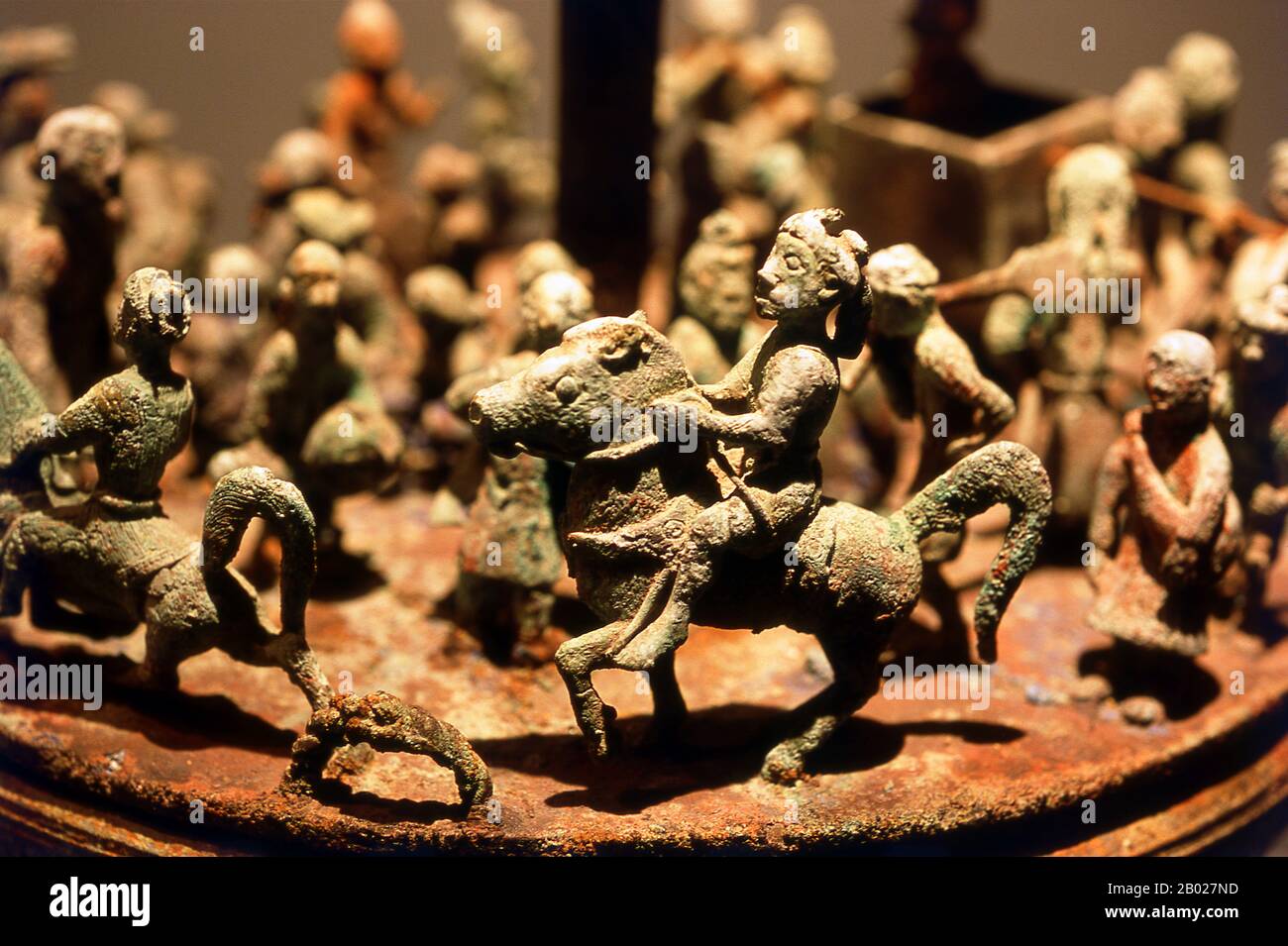 The Dian Kingdom (Chinese: 滇國 or 滇王國) was established by the Dian people, who lived around Lake Dian in northern Yunnan, China from the late Spring and Autumn Period (771 - 476 BCE) until the Eastern Han Dynasty (25 - 220 CE). The Dian were first mentioned historically in Sima Qian's Shiji and according to Chinese sources, the Chinese Chu general Zhuang Qiao was the founder of the Dian Kingdom. Chinese soldiers who accompanied him married the local people. Zhuang was engaged in a war to conquer the 'barbarian' peoples of the area, but he and his army were prevented from going back to Chu by e Stock Photohttps://www.alamy.com/image-license-details/?v=1https://www.alamy.com/the-dian-kingdom-chinese-or-was-established-by-the-dian-people-who-lived-around-lake-dian-in-northern-yunnan-china-from-the-late-spring-and-autumn-period-771-476-bce-until-the-eastern-han-dynasty-25-220-ce-the-dian-were-first-mentioned-historically-in-sima-qians-shiji-and-according-to-chinese-sources-the-chinese-chu-general-zhuang-qiao-was-the-founder-of-the-dian-kingdom-chinese-soldiers-who-accompanied-him-married-the-local-people-zhuang-was-engaged-in-a-war-to-conquer-the-barbarian-peoples-of-the-area-but-he-and-his-army-were-prevented-from-going-back-to-chu-by-e-image344257353.html
The Dian Kingdom (Chinese: 滇國 or 滇王國) was established by the Dian people, who lived around Lake Dian in northern Yunnan, China from the late Spring and Autumn Period (771 - 476 BCE) until the Eastern Han Dynasty (25 - 220 CE). The Dian were first mentioned historically in Sima Qian's Shiji and according to Chinese sources, the Chinese Chu general Zhuang Qiao was the founder of the Dian Kingdom. Chinese soldiers who accompanied him married the local people. Zhuang was engaged in a war to conquer the 'barbarian' peoples of the area, but he and his army were prevented from going back to Chu by e Stock Photohttps://www.alamy.com/image-license-details/?v=1https://www.alamy.com/the-dian-kingdom-chinese-or-was-established-by-the-dian-people-who-lived-around-lake-dian-in-northern-yunnan-china-from-the-late-spring-and-autumn-period-771-476-bce-until-the-eastern-han-dynasty-25-220-ce-the-dian-were-first-mentioned-historically-in-sima-qians-shiji-and-according-to-chinese-sources-the-chinese-chu-general-zhuang-qiao-was-the-founder-of-the-dian-kingdom-chinese-soldiers-who-accompanied-him-married-the-local-people-zhuang-was-engaged-in-a-war-to-conquer-the-barbarian-peoples-of-the-area-but-he-and-his-army-were-prevented-from-going-back-to-chu-by-e-image344257353.htmlRM2B027ND–The Dian Kingdom (Chinese: 滇國 or 滇王國) was established by the Dian people, who lived around Lake Dian in northern Yunnan, China from the late Spring and Autumn Period (771 - 476 BCE) until the Eastern Han Dynasty (25 - 220 CE). The Dian were first mentioned historically in Sima Qian's Shiji and according to Chinese sources, the Chinese Chu general Zhuang Qiao was the founder of the Dian Kingdom. Chinese soldiers who accompanied him married the local people. Zhuang was engaged in a war to conquer the 'barbarian' peoples of the area, but he and his army were prevented from going back to Chu by e
 Belt Ornament, 206 BCE - 220 CE, 1 7/8 x 5/8 x 7/8 in. (4.76 x 1.59 x 2.22 cm), Semi-translucent grey jade marked with brown clouds, China, 3rd century BCE - 3rd century CE Stock Photohttps://www.alamy.com/image-license-details/?v=1https://www.alamy.com/belt-ornament-206-bce-220-ce-1-78-x-58-x-78-in-476-x-159-x-222-cm-semi-translucent-grey-jade-marked-with-brown-clouds-china-3rd-century-bce-3rd-century-ce-image573493109.html
Belt Ornament, 206 BCE - 220 CE, 1 7/8 x 5/8 x 7/8 in. (4.76 x 1.59 x 2.22 cm), Semi-translucent grey jade marked with brown clouds, China, 3rd century BCE - 3rd century CE Stock Photohttps://www.alamy.com/image-license-details/?v=1https://www.alamy.com/belt-ornament-206-bce-220-ce-1-78-x-58-x-78-in-476-x-159-x-222-cm-semi-translucent-grey-jade-marked-with-brown-clouds-china-3rd-century-bce-3rd-century-ce-image573493109.htmlRM2T90T8N–Belt Ornament, 206 BCE - 220 CE, 1 7/8 x 5/8 x 7/8 in. (4.76 x 1.59 x 2.22 cm), Semi-translucent grey jade marked with brown clouds, China, 3rd century BCE - 3rd century CE
 The Dian Kingdom (Chinese: 滇國 or 滇王國) was established by the Dian people, who lived around Lake Dian in northern Yunnan, China from the late Spring and Autumn Period (771 - 476 BCE) until the Eastern Han Dynasty (25 - 220 CE). The Dian were first mentioned historically in Sima Qian's Shiji and according to Chinese sources, the Chinese Chu general Zhuang Qiao was the founder of the Dian Kingdom. Chinese soldiers who accompanied him married the local people. Zhuang was engaged in a war to conquer the 'barbarian' peoples of the area, but he and his army were prevented from going back to Chu by e Stock Photohttps://www.alamy.com/image-license-details/?v=1https://www.alamy.com/the-dian-kingdom-chinese-or-was-established-by-the-dian-people-who-lived-around-lake-dian-in-northern-yunnan-china-from-the-late-spring-and-autumn-period-771-476-bce-until-the-eastern-han-dynasty-25-220-ce-the-dian-were-first-mentioned-historically-in-sima-qians-shiji-and-according-to-chinese-sources-the-chinese-chu-general-zhuang-qiao-was-the-founder-of-the-dian-kingdom-chinese-soldiers-who-accompanied-him-married-the-local-people-zhuang-was-engaged-in-a-war-to-conquer-the-barbarian-peoples-of-the-area-but-he-and-his-army-were-prevented-from-going-back-to-chu-by-e-image344257355.html
The Dian Kingdom (Chinese: 滇國 or 滇王國) was established by the Dian people, who lived around Lake Dian in northern Yunnan, China from the late Spring and Autumn Period (771 - 476 BCE) until the Eastern Han Dynasty (25 - 220 CE). The Dian were first mentioned historically in Sima Qian's Shiji and according to Chinese sources, the Chinese Chu general Zhuang Qiao was the founder of the Dian Kingdom. Chinese soldiers who accompanied him married the local people. Zhuang was engaged in a war to conquer the 'barbarian' peoples of the area, but he and his army were prevented from going back to Chu by e Stock Photohttps://www.alamy.com/image-license-details/?v=1https://www.alamy.com/the-dian-kingdom-chinese-or-was-established-by-the-dian-people-who-lived-around-lake-dian-in-northern-yunnan-china-from-the-late-spring-and-autumn-period-771-476-bce-until-the-eastern-han-dynasty-25-220-ce-the-dian-were-first-mentioned-historically-in-sima-qians-shiji-and-according-to-chinese-sources-the-chinese-chu-general-zhuang-qiao-was-the-founder-of-the-dian-kingdom-chinese-soldiers-who-accompanied-him-married-the-local-people-zhuang-was-engaged-in-a-war-to-conquer-the-barbarian-peoples-of-the-area-but-he-and-his-army-were-prevented-from-going-back-to-chu-by-e-image344257355.htmlRM2B027NF–The Dian Kingdom (Chinese: 滇國 or 滇王國) was established by the Dian people, who lived around Lake Dian in northern Yunnan, China from the late Spring and Autumn Period (771 - 476 BCE) until the Eastern Han Dynasty (25 - 220 CE). The Dian were first mentioned historically in Sima Qian's Shiji and according to Chinese sources, the Chinese Chu general Zhuang Qiao was the founder of the Dian Kingdom. Chinese soldiers who accompanied him married the local people. Zhuang was engaged in a war to conquer the 'barbarian' peoples of the area, but he and his army were prevented from going back to Chu by e
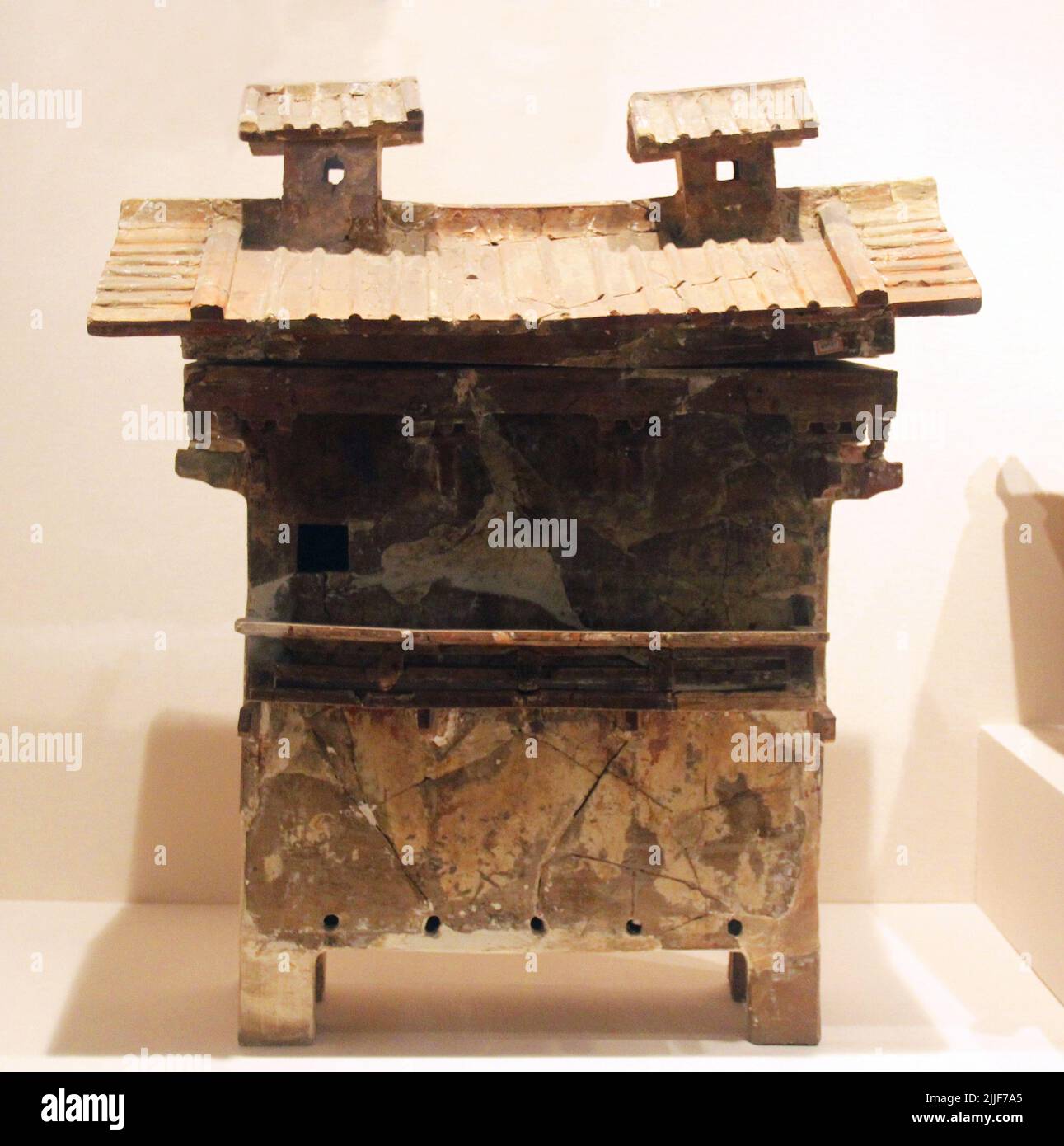 China: Ceramic model of a granary, Eastern Han Dynasty (25-220 CE), Shandong Provincial Museum, Jinan. The Han Dynasty was an imperial dynasty that ruled during a golden age in Chinese history and has influenced the identity of Chinese civilisation ever since. First established by Emperor Gao (Liu Bang), it was briefly usurped by the Xin Dynasty (9-23 CE), so is separated into two periods: the Western Han (202 BCE - 9 CE) and the Eastern Han (25-220 CE). Porcelain and ceramics were made in great quantities during the Han Dynasty years, with developments in new techniques and artforms leading Stock Photohttps://www.alamy.com/image-license-details/?v=1https://www.alamy.com/china-ceramic-model-of-a-granary-eastern-han-dynasty-25-220-ce-shandong-provincial-museum-jinan-the-han-dynasty-was-an-imperial-dynasty-that-ruled-during-a-golden-age-in-chinese-history-and-has-influenced-the-identity-of-chinese-civilisation-ever-since-first-established-by-emperor-gao-liu-bang-it-was-briefly-usurped-by-the-xin-dynasty-9-23-ce-so-is-separated-into-two-periods-the-western-han-202-bce-9-ce-and-the-eastern-han-25-220-ce-porcelain-and-ceramics-were-made-in-great-quantities-during-the-han-dynasty-years-with-developments-in-new-techniques-and-artforms-leading-image476078797.html
China: Ceramic model of a granary, Eastern Han Dynasty (25-220 CE), Shandong Provincial Museum, Jinan. The Han Dynasty was an imperial dynasty that ruled during a golden age in Chinese history and has influenced the identity of Chinese civilisation ever since. First established by Emperor Gao (Liu Bang), it was briefly usurped by the Xin Dynasty (9-23 CE), so is separated into two periods: the Western Han (202 BCE - 9 CE) and the Eastern Han (25-220 CE). Porcelain and ceramics were made in great quantities during the Han Dynasty years, with developments in new techniques and artforms leading Stock Photohttps://www.alamy.com/image-license-details/?v=1https://www.alamy.com/china-ceramic-model-of-a-granary-eastern-han-dynasty-25-220-ce-shandong-provincial-museum-jinan-the-han-dynasty-was-an-imperial-dynasty-that-ruled-during-a-golden-age-in-chinese-history-and-has-influenced-the-identity-of-chinese-civilisation-ever-since-first-established-by-emperor-gao-liu-bang-it-was-briefly-usurped-by-the-xin-dynasty-9-23-ce-so-is-separated-into-two-periods-the-western-han-202-bce-9-ce-and-the-eastern-han-25-220-ce-porcelain-and-ceramics-were-made-in-great-quantities-during-the-han-dynasty-years-with-developments-in-new-techniques-and-artforms-leading-image476078797.htmlRM2JJF7A5–China: Ceramic model of a granary, Eastern Han Dynasty (25-220 CE), Shandong Provincial Museum, Jinan. The Han Dynasty was an imperial dynasty that ruled during a golden age in Chinese history and has influenced the identity of Chinese civilisation ever since. First established by Emperor Gao (Liu Bang), it was briefly usurped by the Xin Dynasty (9-23 CE), so is separated into two periods: the Western Han (202 BCE - 9 CE) and the Eastern Han (25-220 CE). Porcelain and ceramics were made in great quantities during the Han Dynasty years, with developments in new techniques and artforms leading
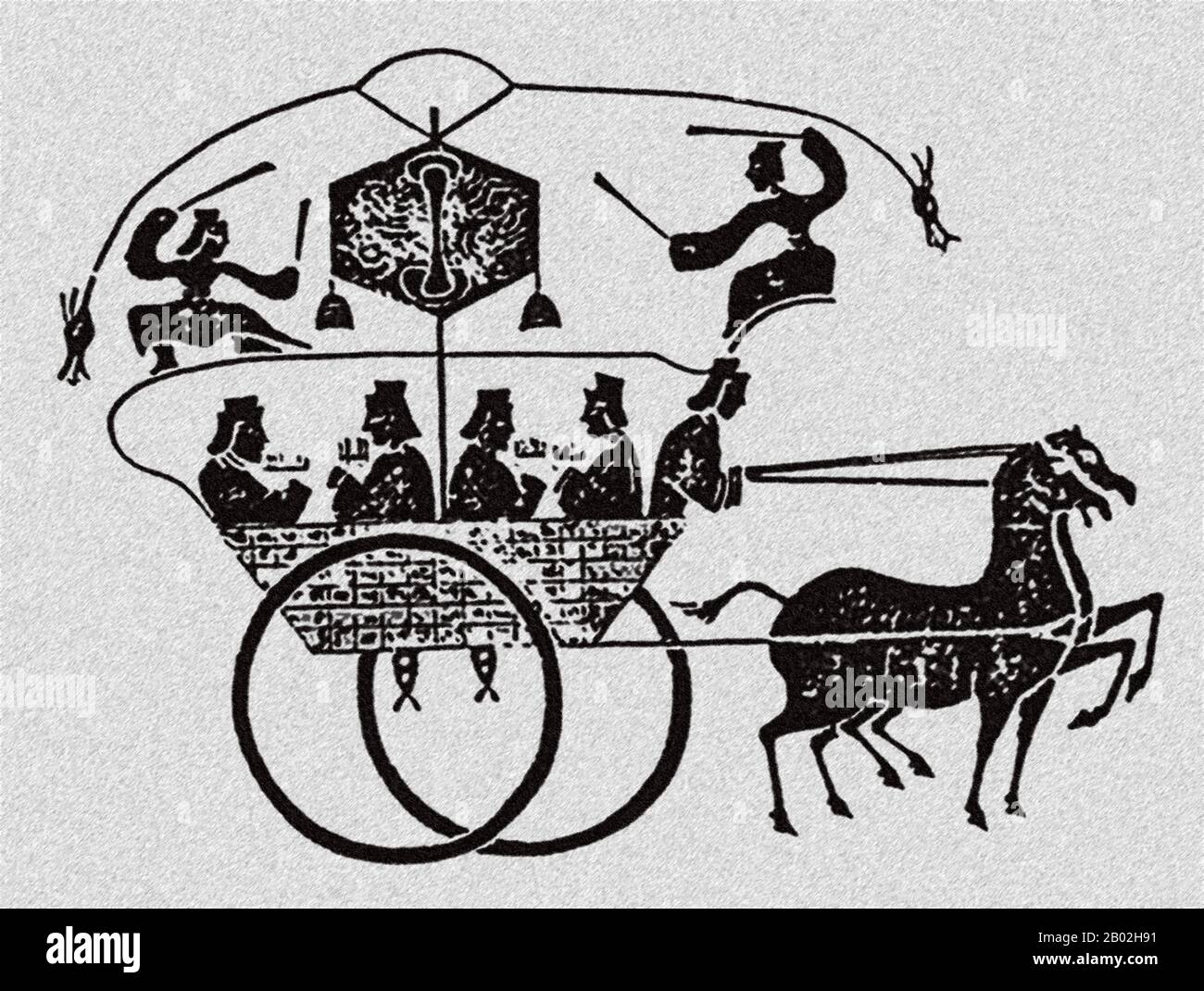 The Xiaotang Mountain Han Shrine (Chinese: 孝堂山汉墓祠; pinyin: Xiàotáng Shān Hàn Mù Cí) also known as the Guo Family Ancestral Hall (Chinese: 孝堂山郭氏墓石祠; pinyin: Xiàotángshān Guō Shì Mù Shí Cí, literally 'Xiaotang Mountain Guo Family Tomb Stone Ancestral Hall') is a funerary stone shrine from the early Eastern Han Dynasty (25-220 CE) situated on slopes of the Yellow River valley in the western part of Shandong Province, China. An odometer for measuring distance was first described by Vitruvius around 27 and 23 BCE, although the actual inventor may have been Archimedes of Syracuse (c. 287 BC – c. 21 Stock Photohttps://www.alamy.com/image-license-details/?v=1https://www.alamy.com/the-xiaotang-mountain-han-shrine-chinese-pinyin-xiotng-shn-hn-m-c-also-known-as-the-guo-family-ancestral-hall-chinese-pinyin-xiotngshn-gu-sh-m-sh-c-literally-xiaotang-mountain-guo-family-tomb-stone-ancestral-hall-is-a-funerary-stone-shrine-from-the-early-eastern-han-dynasty-25-220-ce-situated-on-slopes-of-the-yellow-river-valley-in-the-western-part-of-shandong-province-china-an-odometer-for-measuring-distance-was-first-described-by-vitruvius-around-27-and-23-bce-although-the-actual-inventor-may-have-been-archimedes-of-syracuse-c-287-bc-c-21-image344264845.html
The Xiaotang Mountain Han Shrine (Chinese: 孝堂山汉墓祠; pinyin: Xiàotáng Shān Hàn Mù Cí) also known as the Guo Family Ancestral Hall (Chinese: 孝堂山郭氏墓石祠; pinyin: Xiàotángshān Guō Shì Mù Shí Cí, literally 'Xiaotang Mountain Guo Family Tomb Stone Ancestral Hall') is a funerary stone shrine from the early Eastern Han Dynasty (25-220 CE) situated on slopes of the Yellow River valley in the western part of Shandong Province, China. An odometer for measuring distance was first described by Vitruvius around 27 and 23 BCE, although the actual inventor may have been Archimedes of Syracuse (c. 287 BC – c. 21 Stock Photohttps://www.alamy.com/image-license-details/?v=1https://www.alamy.com/the-xiaotang-mountain-han-shrine-chinese-pinyin-xiotng-shn-hn-m-c-also-known-as-the-guo-family-ancestral-hall-chinese-pinyin-xiotngshn-gu-sh-m-sh-c-literally-xiaotang-mountain-guo-family-tomb-stone-ancestral-hall-is-a-funerary-stone-shrine-from-the-early-eastern-han-dynasty-25-220-ce-situated-on-slopes-of-the-yellow-river-valley-in-the-western-part-of-shandong-province-china-an-odometer-for-measuring-distance-was-first-described-by-vitruvius-around-27-and-23-bce-although-the-actual-inventor-may-have-been-archimedes-of-syracuse-c-287-bc-c-21-image344264845.htmlRM2B02H91–The Xiaotang Mountain Han Shrine (Chinese: 孝堂山汉墓祠; pinyin: Xiàotáng Shān Hàn Mù Cí) also known as the Guo Family Ancestral Hall (Chinese: 孝堂山郭氏墓石祠; pinyin: Xiàotángshān Guō Shì Mù Shí Cí, literally 'Xiaotang Mountain Guo Family Tomb Stone Ancestral Hall') is a funerary stone shrine from the early Eastern Han Dynasty (25-220 CE) situated on slopes of the Yellow River valley in the western part of Shandong Province, China. An odometer for measuring distance was first described by Vitruvius around 27 and 23 BCE, although the actual inventor may have been Archimedes of Syracuse (c. 287 BC – c. 21
 Bi Scabbard Chape, 206 BCE - 220 CE, 1 1/2 x 5 5/16 x 5/8 in. (3.81 x 13.49 x 1.59 cm), Tan jade, now a yellowish opaque color, China, 3rd century BCE - 3rd century CE Stock Photohttps://www.alamy.com/image-license-details/?v=1https://www.alamy.com/bi-scabbard-chape-206-bce-220-ce-1-12-x-5-516-x-58-in-381-x-1349-x-159-cm-tan-jade-now-a-yellowish-opaque-color-china-3rd-century-bce-3rd-century-ce-image573516844.html
Bi Scabbard Chape, 206 BCE - 220 CE, 1 1/2 x 5 5/16 x 5/8 in. (3.81 x 13.49 x 1.59 cm), Tan jade, now a yellowish opaque color, China, 3rd century BCE - 3rd century CE Stock Photohttps://www.alamy.com/image-license-details/?v=1https://www.alamy.com/bi-scabbard-chape-206-bce-220-ce-1-12-x-5-516-x-58-in-381-x-1349-x-159-cm-tan-jade-now-a-yellowish-opaque-color-china-3rd-century-bce-3rd-century-ce-image573516844.htmlRM2T91XGC–Bi Scabbard Chape, 206 BCE - 220 CE, 1 1/2 x 5 5/16 x 5/8 in. (3.81 x 13.49 x 1.59 cm), Tan jade, now a yellowish opaque color, China, 3rd century BCE - 3rd century CE
 The Ghijäk or spike fiddle has a soundboard of stretched skin and is bowed. The Khushtar is also bowed,but its tone is lower and sofetr than the Ghijäk. The earliest mention of Kashgar occurs when a Chinese Han Dynasty (206 BCE – 220 CE) envoy traveled the Northern Silk Road to explore lands to the west. Another early mention of Kashgar is during the Former Han (also known as the Western Han Dynasty), when in 76 BCE the Chinese conquered the Xiongnu, Yutian (Khotan), Sulei (Kashgar), and a group of states in the Tarim basin almost up to the foot of the Tian Shan mountains. Ptolemy spoke of Stock Photohttps://www.alamy.com/image-license-details/?v=1https://www.alamy.com/the-ghijk-or-spike-fiddle-has-a-soundboard-of-stretched-skin-and-is-bowed-the-khushtar-is-also-bowedbut-its-tone-is-lower-and-sofetr-than-the-ghijk-the-earliest-mention-of-kashgar-occurs-when-a-chinese-han-dynasty-206-bce-220-ce-envoy-traveled-the-northern-silk-road-to-explore-lands-to-the-west-another-early-mention-of-kashgar-is-during-the-former-han-also-known-as-the-western-han-dynasty-when-in-76-bce-the-chinese-conquered-the-xiongnu-yutian-khotan-sulei-kashgar-and-a-group-of-states-in-the-tarim-basin-almost-up-to-the-foot-of-the-tian-shan-mountains-ptolemy-spoke-of-image344268675.html
The Ghijäk or spike fiddle has a soundboard of stretched skin and is bowed. The Khushtar is also bowed,but its tone is lower and sofetr than the Ghijäk. The earliest mention of Kashgar occurs when a Chinese Han Dynasty (206 BCE – 220 CE) envoy traveled the Northern Silk Road to explore lands to the west. Another early mention of Kashgar is during the Former Han (also known as the Western Han Dynasty), when in 76 BCE the Chinese conquered the Xiongnu, Yutian (Khotan), Sulei (Kashgar), and a group of states in the Tarim basin almost up to the foot of the Tian Shan mountains. Ptolemy spoke of Stock Photohttps://www.alamy.com/image-license-details/?v=1https://www.alamy.com/the-ghijk-or-spike-fiddle-has-a-soundboard-of-stretched-skin-and-is-bowed-the-khushtar-is-also-bowedbut-its-tone-is-lower-and-sofetr-than-the-ghijk-the-earliest-mention-of-kashgar-occurs-when-a-chinese-han-dynasty-206-bce-220-ce-envoy-traveled-the-northern-silk-road-to-explore-lands-to-the-west-another-early-mention-of-kashgar-is-during-the-former-han-also-known-as-the-western-han-dynasty-when-in-76-bce-the-chinese-conquered-the-xiongnu-yutian-khotan-sulei-kashgar-and-a-group-of-states-in-the-tarim-basin-almost-up-to-the-foot-of-the-tian-shan-mountains-ptolemy-spoke-of-image344268675.htmlRM2B02P5R–The Ghijäk or spike fiddle has a soundboard of stretched skin and is bowed. The Khushtar is also bowed,but its tone is lower and sofetr than the Ghijäk. The earliest mention of Kashgar occurs when a Chinese Han Dynasty (206 BCE – 220 CE) envoy traveled the Northern Silk Road to explore lands to the west. Another early mention of Kashgar is during the Former Han (also known as the Western Han Dynasty), when in 76 BCE the Chinese conquered the Xiongnu, Yutian (Khotan), Sulei (Kashgar), and a group of states in the Tarim basin almost up to the foot of the Tian Shan mountains. Ptolemy spoke of
 The earliest mention of Kashgar occurs when a Chinese Han Dynasty (206 BCE – 220 CE) envoy traveled the Northern Silk Road to explore lands to the west. Another early mention of Kashgar is during the Former Han (also known as the Western Han Dynasty), when in 76 BCE the Chinese conquered the Xiongnu, Yutian (Khotan), Sulei (Kashgar), and a group of states in the Tarim basin almost up to the foot of the Tian Shan mountains. Ptolemy spoke of Scythia beyond the Imaus, which is in a 'Kasia Regio', probably exhibiting the name from which Kashgar is formed. The country’s people practised Zoroastr Stock Photohttps://www.alamy.com/image-license-details/?v=1https://www.alamy.com/the-earliest-mention-of-kashgar-occurs-when-a-chinese-han-dynasty-206-bce-220-ce-envoy-traveled-the-northern-silk-road-to-explore-lands-to-the-west-another-early-mention-of-kashgar-is-during-the-former-han-also-known-as-the-western-han-dynasty-when-in-76-bce-the-chinese-conquered-the-xiongnu-yutian-khotan-sulei-kashgar-and-a-group-of-states-in-the-tarim-basin-almost-up-to-the-foot-of-the-tian-shan-mountains-ptolemy-spoke-of-scythia-beyond-the-imaus-which-is-in-a-kasia-regio-probably-exhibiting-the-name-from-which-kashgar-is-formed-the-countrys-people-practised-zoroastr-image344280738.html
The earliest mention of Kashgar occurs when a Chinese Han Dynasty (206 BCE – 220 CE) envoy traveled the Northern Silk Road to explore lands to the west. Another early mention of Kashgar is during the Former Han (also known as the Western Han Dynasty), when in 76 BCE the Chinese conquered the Xiongnu, Yutian (Khotan), Sulei (Kashgar), and a group of states in the Tarim basin almost up to the foot of the Tian Shan mountains. Ptolemy spoke of Scythia beyond the Imaus, which is in a 'Kasia Regio', probably exhibiting the name from which Kashgar is formed. The country’s people practised Zoroastr Stock Photohttps://www.alamy.com/image-license-details/?v=1https://www.alamy.com/the-earliest-mention-of-kashgar-occurs-when-a-chinese-han-dynasty-206-bce-220-ce-envoy-traveled-the-northern-silk-road-to-explore-lands-to-the-west-another-early-mention-of-kashgar-is-during-the-former-han-also-known-as-the-western-han-dynasty-when-in-76-bce-the-chinese-conquered-the-xiongnu-yutian-khotan-sulei-kashgar-and-a-group-of-states-in-the-tarim-basin-almost-up-to-the-foot-of-the-tian-shan-mountains-ptolemy-spoke-of-scythia-beyond-the-imaus-which-is-in-a-kasia-regio-probably-exhibiting-the-name-from-which-kashgar-is-formed-the-countrys-people-practised-zoroastr-image344280738.htmlRM2B039GJ–The earliest mention of Kashgar occurs when a Chinese Han Dynasty (206 BCE – 220 CE) envoy traveled the Northern Silk Road to explore lands to the west. Another early mention of Kashgar is during the Former Han (also known as the Western Han Dynasty), when in 76 BCE the Chinese conquered the Xiongnu, Yutian (Khotan), Sulei (Kashgar), and a group of states in the Tarim basin almost up to the foot of the Tian Shan mountains. Ptolemy spoke of Scythia beyond the Imaus, which is in a 'Kasia Regio', probably exhibiting the name from which Kashgar is formed. The country’s people practised Zoroastr
 The earliest mention of Kashgar occurs when a Chinese Han Dynasty (206 BCE – 220 CE) envoy traveled the Northern Silk Road to explore lands to the west. Another early mention of Kashgar is during the Former Han (also known as the Western Han Dynasty), when in 76 BCE the Chinese conquered the Xiongnu, Yutian (Khotan), Sulei (Kashgar), and a group of states in the Tarim basin almost up to the foot of the Tian Shan mountains. Ptolemy spoke of Scythia beyond the Imaus, which is in a 'Kasia Regio', probably exhibiting the name from which Kashgar is formed. The country’s people practised Zoroastr Stock Photohttps://www.alamy.com/image-license-details/?v=1https://www.alamy.com/the-earliest-mention-of-kashgar-occurs-when-a-chinese-han-dynasty-206-bce-220-ce-envoy-traveled-the-northern-silk-road-to-explore-lands-to-the-west-another-early-mention-of-kashgar-is-during-the-former-han-also-known-as-the-western-han-dynasty-when-in-76-bce-the-chinese-conquered-the-xiongnu-yutian-khotan-sulei-kashgar-and-a-group-of-states-in-the-tarim-basin-almost-up-to-the-foot-of-the-tian-shan-mountains-ptolemy-spoke-of-scythia-beyond-the-imaus-which-is-in-a-kasia-regio-probably-exhibiting-the-name-from-which-kashgar-is-formed-the-countrys-people-practised-zoroastr-image344279981.html
The earliest mention of Kashgar occurs when a Chinese Han Dynasty (206 BCE – 220 CE) envoy traveled the Northern Silk Road to explore lands to the west. Another early mention of Kashgar is during the Former Han (also known as the Western Han Dynasty), when in 76 BCE the Chinese conquered the Xiongnu, Yutian (Khotan), Sulei (Kashgar), and a group of states in the Tarim basin almost up to the foot of the Tian Shan mountains. Ptolemy spoke of Scythia beyond the Imaus, which is in a 'Kasia Regio', probably exhibiting the name from which Kashgar is formed. The country’s people practised Zoroastr Stock Photohttps://www.alamy.com/image-license-details/?v=1https://www.alamy.com/the-earliest-mention-of-kashgar-occurs-when-a-chinese-han-dynasty-206-bce-220-ce-envoy-traveled-the-northern-silk-road-to-explore-lands-to-the-west-another-early-mention-of-kashgar-is-during-the-former-han-also-known-as-the-western-han-dynasty-when-in-76-bce-the-chinese-conquered-the-xiongnu-yutian-khotan-sulei-kashgar-and-a-group-of-states-in-the-tarim-basin-almost-up-to-the-foot-of-the-tian-shan-mountains-ptolemy-spoke-of-scythia-beyond-the-imaus-which-is-in-a-kasia-regio-probably-exhibiting-the-name-from-which-kashgar-is-formed-the-countrys-people-practised-zoroastr-image344279981.htmlRM2B038HH–The earliest mention of Kashgar occurs when a Chinese Han Dynasty (206 BCE – 220 CE) envoy traveled the Northern Silk Road to explore lands to the west. Another early mention of Kashgar is during the Former Han (also known as the Western Han Dynasty), when in 76 BCE the Chinese conquered the Xiongnu, Yutian (Khotan), Sulei (Kashgar), and a group of states in the Tarim basin almost up to the foot of the Tian Shan mountains. Ptolemy spoke of Scythia beyond the Imaus, which is in a 'Kasia Regio', probably exhibiting the name from which Kashgar is formed. The country’s people practised Zoroastr
 The earliest mention of Kashgar occurs when a Chinese Han Dynasty (206 BCE – 220 CE) envoy traveled the Northern Silk Road to explore lands to the west. Another early mention of Kashgar is during the Former Han (also known as the Western Han Dynasty), when in 76 BCE the Chinese conquered the Xiongnu, Yutian (Khotan), Sulei (Kashgar), and a group of states in the Tarim basin almost up to the foot of the Tian Shan mountains. Ptolemy spoke of Scythia beyond the Imaus, which is in a 'Kasia Regio', probably exhibiting the name from which Kashgar is formed. The country’s people practised Zoroastr Stock Photohttps://www.alamy.com/image-license-details/?v=1https://www.alamy.com/the-earliest-mention-of-kashgar-occurs-when-a-chinese-han-dynasty-206-bce-220-ce-envoy-traveled-the-northern-silk-road-to-explore-lands-to-the-west-another-early-mention-of-kashgar-is-during-the-former-han-also-known-as-the-western-han-dynasty-when-in-76-bce-the-chinese-conquered-the-xiongnu-yutian-khotan-sulei-kashgar-and-a-group-of-states-in-the-tarim-basin-almost-up-to-the-foot-of-the-tian-shan-mountains-ptolemy-spoke-of-scythia-beyond-the-imaus-which-is-in-a-kasia-regio-probably-exhibiting-the-name-from-which-kashgar-is-formed-the-countrys-people-practised-zoroastr-image344279964.html
The earliest mention of Kashgar occurs when a Chinese Han Dynasty (206 BCE – 220 CE) envoy traveled the Northern Silk Road to explore lands to the west. Another early mention of Kashgar is during the Former Han (also known as the Western Han Dynasty), when in 76 BCE the Chinese conquered the Xiongnu, Yutian (Khotan), Sulei (Kashgar), and a group of states in the Tarim basin almost up to the foot of the Tian Shan mountains. Ptolemy spoke of Scythia beyond the Imaus, which is in a 'Kasia Regio', probably exhibiting the name from which Kashgar is formed. The country’s people practised Zoroastr Stock Photohttps://www.alamy.com/image-license-details/?v=1https://www.alamy.com/the-earliest-mention-of-kashgar-occurs-when-a-chinese-han-dynasty-206-bce-220-ce-envoy-traveled-the-northern-silk-road-to-explore-lands-to-the-west-another-early-mention-of-kashgar-is-during-the-former-han-also-known-as-the-western-han-dynasty-when-in-76-bce-the-chinese-conquered-the-xiongnu-yutian-khotan-sulei-kashgar-and-a-group-of-states-in-the-tarim-basin-almost-up-to-the-foot-of-the-tian-shan-mountains-ptolemy-spoke-of-scythia-beyond-the-imaus-which-is-in-a-kasia-regio-probably-exhibiting-the-name-from-which-kashgar-is-formed-the-countrys-people-practised-zoroastr-image344279964.htmlRM2B038H0–The earliest mention of Kashgar occurs when a Chinese Han Dynasty (206 BCE – 220 CE) envoy traveled the Northern Silk Road to explore lands to the west. Another early mention of Kashgar is during the Former Han (also known as the Western Han Dynasty), when in 76 BCE the Chinese conquered the Xiongnu, Yutian (Khotan), Sulei (Kashgar), and a group of states in the Tarim basin almost up to the foot of the Tian Shan mountains. Ptolemy spoke of Scythia beyond the Imaus, which is in a 'Kasia Regio', probably exhibiting the name from which Kashgar is formed. The country’s people practised Zoroastr
 Pendant in the Form of An Archer's Thumb Ring, 206 BCE - 220 CE, 2 3/4 x 2 1/2 x 1/4 in. (6.99 x 6.35 x 0.64 cm), Translucent yellow-grey jade, China, 3rd century BCE - 3rd century CE Stock Photohttps://www.alamy.com/image-license-details/?v=1https://www.alamy.com/pendant-in-the-form-of-an-archers-thumb-ring-206-bce-220-ce-2-34-x-2-12-x-14-in-699-x-635-x-064-cm-translucent-yellow-grey-jade-china-3rd-century-bce-3rd-century-ce-image573481040.html
Pendant in the Form of An Archer's Thumb Ring, 206 BCE - 220 CE, 2 3/4 x 2 1/2 x 1/4 in. (6.99 x 6.35 x 0.64 cm), Translucent yellow-grey jade, China, 3rd century BCE - 3rd century CE Stock Photohttps://www.alamy.com/image-license-details/?v=1https://www.alamy.com/pendant-in-the-form-of-an-archers-thumb-ring-206-bce-220-ce-2-34-x-2-12-x-14-in-699-x-635-x-064-cm-translucent-yellow-grey-jade-china-3rd-century-bce-3rd-century-ce-image573481040.htmlRM2T908WM–Pendant in the Form of An Archer's Thumb Ring, 206 BCE - 220 CE, 2 3/4 x 2 1/2 x 1/4 in. (6.99 x 6.35 x 0.64 cm), Translucent yellow-grey jade, China, 3rd century BCE - 3rd century CE
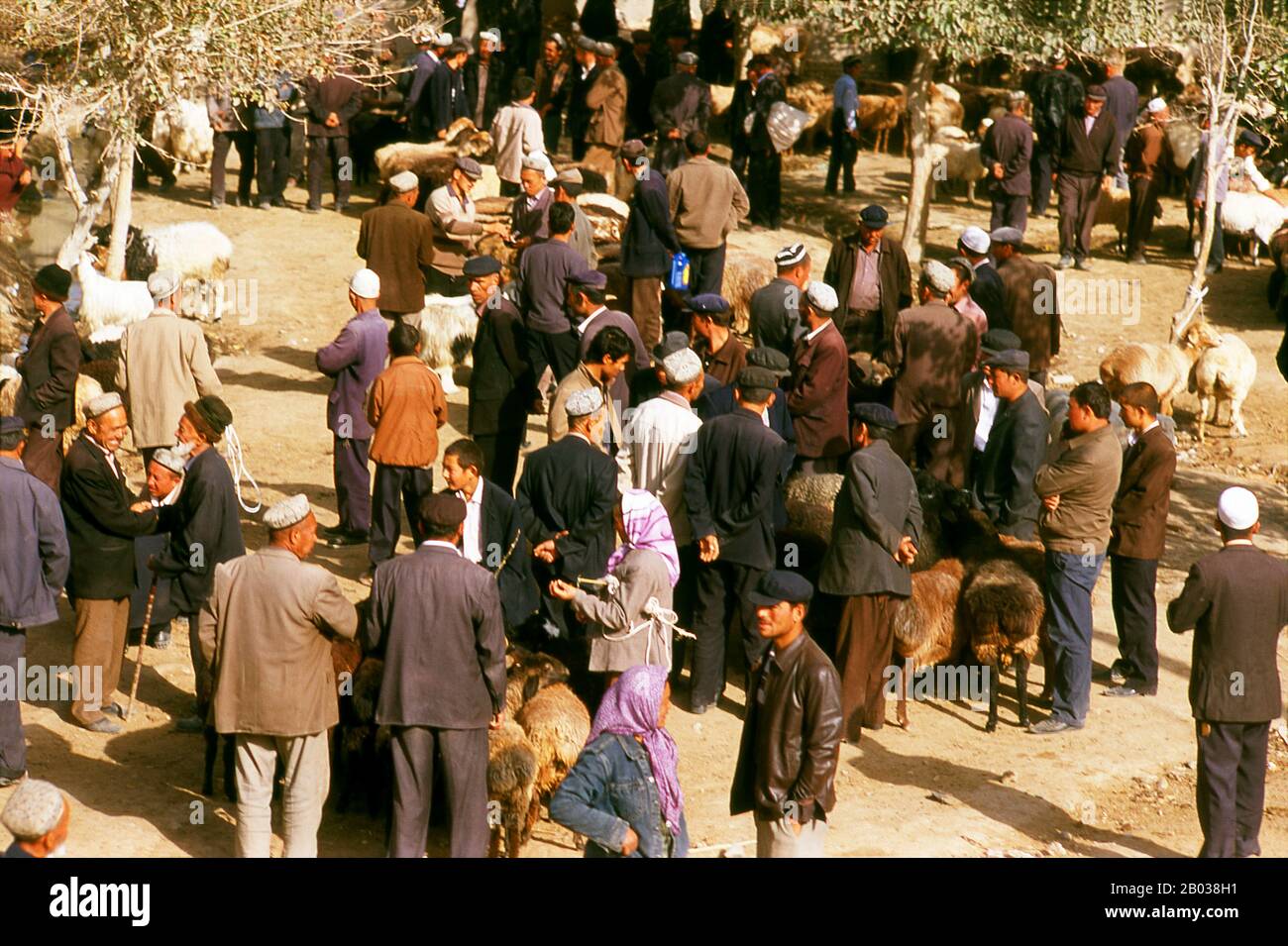 The earliest mention of Kashgar occurs when a Chinese Han Dynasty (206 BCE – 220 CE) envoy traveled the Northern Silk Road to explore lands to the west. Another early mention of Kashgar is during the Former Han (also known as the Western Han Dynasty), when in 76 BCE the Chinese conquered the Xiongnu, Yutian (Khotan), Sulei (Kashgar), and a group of states in the Tarim basin almost up to the foot of the Tian Shan mountains. Ptolemy spoke of Scythia beyond the Imaus, which is in a 'Kasia Regio', probably exhibiting the name from which Kashgar is formed. The country’s people practised Zoroastr Stock Photohttps://www.alamy.com/image-license-details/?v=1https://www.alamy.com/the-earliest-mention-of-kashgar-occurs-when-a-chinese-han-dynasty-206-bce-220-ce-envoy-traveled-the-northern-silk-road-to-explore-lands-to-the-west-another-early-mention-of-kashgar-is-during-the-former-han-also-known-as-the-western-han-dynasty-when-in-76-bce-the-chinese-conquered-the-xiongnu-yutian-khotan-sulei-kashgar-and-a-group-of-states-in-the-tarim-basin-almost-up-to-the-foot-of-the-tian-shan-mountains-ptolemy-spoke-of-scythia-beyond-the-imaus-which-is-in-a-kasia-regio-probably-exhibiting-the-name-from-which-kashgar-is-formed-the-countrys-people-practised-zoroastr-image344279965.html
The earliest mention of Kashgar occurs when a Chinese Han Dynasty (206 BCE – 220 CE) envoy traveled the Northern Silk Road to explore lands to the west. Another early mention of Kashgar is during the Former Han (also known as the Western Han Dynasty), when in 76 BCE the Chinese conquered the Xiongnu, Yutian (Khotan), Sulei (Kashgar), and a group of states in the Tarim basin almost up to the foot of the Tian Shan mountains. Ptolemy spoke of Scythia beyond the Imaus, which is in a 'Kasia Regio', probably exhibiting the name from which Kashgar is formed. The country’s people practised Zoroastr Stock Photohttps://www.alamy.com/image-license-details/?v=1https://www.alamy.com/the-earliest-mention-of-kashgar-occurs-when-a-chinese-han-dynasty-206-bce-220-ce-envoy-traveled-the-northern-silk-road-to-explore-lands-to-the-west-another-early-mention-of-kashgar-is-during-the-former-han-also-known-as-the-western-han-dynasty-when-in-76-bce-the-chinese-conquered-the-xiongnu-yutian-khotan-sulei-kashgar-and-a-group-of-states-in-the-tarim-basin-almost-up-to-the-foot-of-the-tian-shan-mountains-ptolemy-spoke-of-scythia-beyond-the-imaus-which-is-in-a-kasia-regio-probably-exhibiting-the-name-from-which-kashgar-is-formed-the-countrys-people-practised-zoroastr-image344279965.htmlRM2B038H1–The earliest mention of Kashgar occurs when a Chinese Han Dynasty (206 BCE – 220 CE) envoy traveled the Northern Silk Road to explore lands to the west. Another early mention of Kashgar is during the Former Han (also known as the Western Han Dynasty), when in 76 BCE the Chinese conquered the Xiongnu, Yutian (Khotan), Sulei (Kashgar), and a group of states in the Tarim basin almost up to the foot of the Tian Shan mountains. Ptolemy spoke of Scythia beyond the Imaus, which is in a 'Kasia Regio', probably exhibiting the name from which Kashgar is formed. The country’s people practised Zoroastr
 Dog, One of Three, 206 BCE - 220 CE, 3 5/16 × 5 1/4 × 1 5/8 in., 0.4 lb. (8.41 × 13.34 × 4.13 cm, 0.2 kg), Bronze, China, 3rd century BCE - 3rd century CE Stock Photohttps://www.alamy.com/image-license-details/?v=1https://www.alamy.com/dog-one-of-three-206-bce-220-ce-3-516-5-14-1-58-in-04-lb-841-1334-413-cm-02-kg-bronze-china-3rd-century-bce-3rd-century-ce-image573492909.html
Dog, One of Three, 206 BCE - 220 CE, 3 5/16 × 5 1/4 × 1 5/8 in., 0.4 lb. (8.41 × 13.34 × 4.13 cm, 0.2 kg), Bronze, China, 3rd century BCE - 3rd century CE Stock Photohttps://www.alamy.com/image-license-details/?v=1https://www.alamy.com/dog-one-of-three-206-bce-220-ce-3-516-5-14-1-58-in-04-lb-841-1334-413-cm-02-kg-bronze-china-3rd-century-bce-3rd-century-ce-image573492909.htmlRM2T90T1H–Dog, One of Three, 206 BCE - 220 CE, 3 5/16 × 5 1/4 × 1 5/8 in., 0.4 lb. (8.41 × 13.34 × 4.13 cm, 0.2 kg), Bronze, China, 3rd century BCE - 3rd century CE
 The earliest mention of Kashgar occurs when a Chinese Han Dynasty (206 BCE – 220 CE) envoy traveled the Northern Silk Road to explore lands to the west. Another early mention of Kashgar is during the Former Han (also known as the Western Han Dynasty), when in 76 BCE the Chinese conquered the Xiongnu, Yutian (Khotan), Sulei (Kashgar), and a group of states in the Tarim basin almost up to the foot of the Tian Shan mountains. Ptolemy spoke of Scythia beyond the Imaus, which is in a 'Kasia Regio', probably exhibiting the name from which Kashgar is formed. The country’s people practised Zoroastr Stock Photohttps://www.alamy.com/image-license-details/?v=1https://www.alamy.com/the-earliest-mention-of-kashgar-occurs-when-a-chinese-han-dynasty-206-bce-220-ce-envoy-traveled-the-northern-silk-road-to-explore-lands-to-the-west-another-early-mention-of-kashgar-is-during-the-former-han-also-known-as-the-western-han-dynasty-when-in-76-bce-the-chinese-conquered-the-xiongnu-yutian-khotan-sulei-kashgar-and-a-group-of-states-in-the-tarim-basin-almost-up-to-the-foot-of-the-tian-shan-mountains-ptolemy-spoke-of-scythia-beyond-the-imaus-which-is-in-a-kasia-regio-probably-exhibiting-the-name-from-which-kashgar-is-formed-the-countrys-people-practised-zoroastr-image344279982.html
The earliest mention of Kashgar occurs when a Chinese Han Dynasty (206 BCE – 220 CE) envoy traveled the Northern Silk Road to explore lands to the west. Another early mention of Kashgar is during the Former Han (also known as the Western Han Dynasty), when in 76 BCE the Chinese conquered the Xiongnu, Yutian (Khotan), Sulei (Kashgar), and a group of states in the Tarim basin almost up to the foot of the Tian Shan mountains. Ptolemy spoke of Scythia beyond the Imaus, which is in a 'Kasia Regio', probably exhibiting the name from which Kashgar is formed. The country’s people practised Zoroastr Stock Photohttps://www.alamy.com/image-license-details/?v=1https://www.alamy.com/the-earliest-mention-of-kashgar-occurs-when-a-chinese-han-dynasty-206-bce-220-ce-envoy-traveled-the-northern-silk-road-to-explore-lands-to-the-west-another-early-mention-of-kashgar-is-during-the-former-han-also-known-as-the-western-han-dynasty-when-in-76-bce-the-chinese-conquered-the-xiongnu-yutian-khotan-sulei-kashgar-and-a-group-of-states-in-the-tarim-basin-almost-up-to-the-foot-of-the-tian-shan-mountains-ptolemy-spoke-of-scythia-beyond-the-imaus-which-is-in-a-kasia-regio-probably-exhibiting-the-name-from-which-kashgar-is-formed-the-countrys-people-practised-zoroastr-image344279982.htmlRM2B038HJ–The earliest mention of Kashgar occurs when a Chinese Han Dynasty (206 BCE – 220 CE) envoy traveled the Northern Silk Road to explore lands to the west. Another early mention of Kashgar is during the Former Han (also known as the Western Han Dynasty), when in 76 BCE the Chinese conquered the Xiongnu, Yutian (Khotan), Sulei (Kashgar), and a group of states in the Tarim basin almost up to the foot of the Tian Shan mountains. Ptolemy spoke of Scythia beyond the Imaus, which is in a 'Kasia Regio', probably exhibiting the name from which Kashgar is formed. The country’s people practised Zoroastr
 Hu (Ritual Storage Vessel), 206 BCE - 220 CE, 15 1/2 x 12 in. (39.4 x 30.48 cm), Stoneware with green glaze over molded decor, China, 3rd century BCE - 3rd century CE, The earliest lead glazed pottery has been found in the tombs of Middle Western Han. This was a revolutionary ware in that it marked the beginning of controlled colored glazes, primarily green, yellow, and brown. The term 'lead glaze' refers to the addition of lead flux to the glaze compound which lowers the melting point of the glaze thereby speeding up the firing process. Stock Photohttps://www.alamy.com/image-license-details/?v=1https://www.alamy.com/hu-ritual-storage-vessel-206-bce-220-ce-15-12-x-12-in-394-x-3048-cm-stoneware-with-green-glaze-over-molded-decor-china-3rd-century-bce-3rd-century-ce-the-earliest-lead-glazed-pottery-has-been-found-in-the-tombs-of-middle-western-han-this-was-a-revolutionary-ware-in-that-it-marked-the-beginning-of-controlled-colored-glazes-primarily-green-yellow-and-brown-the-term-lead-glaze-refers-to-the-addition-of-lead-flux-to-the-glaze-compound-which-lowers-the-melting-point-of-the-glaze-thereby-speeding-up-the-firing-process-image573500516.html
Hu (Ritual Storage Vessel), 206 BCE - 220 CE, 15 1/2 x 12 in. (39.4 x 30.48 cm), Stoneware with green glaze over molded decor, China, 3rd century BCE - 3rd century CE, The earliest lead glazed pottery has been found in the tombs of Middle Western Han. This was a revolutionary ware in that it marked the beginning of controlled colored glazes, primarily green, yellow, and brown. The term 'lead glaze' refers to the addition of lead flux to the glaze compound which lowers the melting point of the glaze thereby speeding up the firing process. Stock Photohttps://www.alamy.com/image-license-details/?v=1https://www.alamy.com/hu-ritual-storage-vessel-206-bce-220-ce-15-12-x-12-in-394-x-3048-cm-stoneware-with-green-glaze-over-molded-decor-china-3rd-century-bce-3rd-century-ce-the-earliest-lead-glazed-pottery-has-been-found-in-the-tombs-of-middle-western-han-this-was-a-revolutionary-ware-in-that-it-marked-the-beginning-of-controlled-colored-glazes-primarily-green-yellow-and-brown-the-term-lead-glaze-refers-to-the-addition-of-lead-flux-to-the-glaze-compound-which-lowers-the-melting-point-of-the-glaze-thereby-speeding-up-the-firing-process-image573500516.htmlRM2T915N8–Hu (Ritual Storage Vessel), 206 BCE - 220 CE, 15 1/2 x 12 in. (39.4 x 30.48 cm), Stoneware with green glaze over molded decor, China, 3rd century BCE - 3rd century CE, The earliest lead glazed pottery has been found in the tombs of Middle Western Han. This was a revolutionary ware in that it marked the beginning of controlled colored glazes, primarily green, yellow, and brown. The term 'lead glaze' refers to the addition of lead flux to the glaze compound which lowers the melting point of the glaze thereby speeding up the firing process.
 The earliest mention of Kashgar occurs when a Chinese Han Dynasty (206 BCE – 220 CE) envoy traveled the Northern Silk Road to explore lands to the west. Another early mention of Kashgar is during the Former Han (also known as the Western Han Dynasty), when in 76 BCE the Chinese conquered the Xiongnu, Yutian (Khotan), Sulei (Kashgar), and a group of states in the Tarim basin almost up to the foot of the Tian Shan mountains. Ptolemy spoke of Scythia beyond the Imaus, which is in a 'Kasia Regio', probably exhibiting the name from which Kashgar is formed. The country’s people practised Zoroastr Stock Photohttps://www.alamy.com/image-license-details/?v=1https://www.alamy.com/the-earliest-mention-of-kashgar-occurs-when-a-chinese-han-dynasty-206-bce-220-ce-envoy-traveled-the-northern-silk-road-to-explore-lands-to-the-west-another-early-mention-of-kashgar-is-during-the-former-han-also-known-as-the-western-han-dynasty-when-in-76-bce-the-chinese-conquered-the-xiongnu-yutian-khotan-sulei-kashgar-and-a-group-of-states-in-the-tarim-basin-almost-up-to-the-foot-of-the-tian-shan-mountains-ptolemy-spoke-of-scythia-beyond-the-imaus-which-is-in-a-kasia-regio-probably-exhibiting-the-name-from-which-kashgar-is-formed-the-countrys-people-practised-zoroastr-image344279963.html
The earliest mention of Kashgar occurs when a Chinese Han Dynasty (206 BCE – 220 CE) envoy traveled the Northern Silk Road to explore lands to the west. Another early mention of Kashgar is during the Former Han (also known as the Western Han Dynasty), when in 76 BCE the Chinese conquered the Xiongnu, Yutian (Khotan), Sulei (Kashgar), and a group of states in the Tarim basin almost up to the foot of the Tian Shan mountains. Ptolemy spoke of Scythia beyond the Imaus, which is in a 'Kasia Regio', probably exhibiting the name from which Kashgar is formed. The country’s people practised Zoroastr Stock Photohttps://www.alamy.com/image-license-details/?v=1https://www.alamy.com/the-earliest-mention-of-kashgar-occurs-when-a-chinese-han-dynasty-206-bce-220-ce-envoy-traveled-the-northern-silk-road-to-explore-lands-to-the-west-another-early-mention-of-kashgar-is-during-the-former-han-also-known-as-the-western-han-dynasty-when-in-76-bce-the-chinese-conquered-the-xiongnu-yutian-khotan-sulei-kashgar-and-a-group-of-states-in-the-tarim-basin-almost-up-to-the-foot-of-the-tian-shan-mountains-ptolemy-spoke-of-scythia-beyond-the-imaus-which-is-in-a-kasia-regio-probably-exhibiting-the-name-from-which-kashgar-is-formed-the-countrys-people-practised-zoroastr-image344279963.htmlRM2B038GY–The earliest mention of Kashgar occurs when a Chinese Han Dynasty (206 BCE – 220 CE) envoy traveled the Northern Silk Road to explore lands to the west. Another early mention of Kashgar is during the Former Han (also known as the Western Han Dynasty), when in 76 BCE the Chinese conquered the Xiongnu, Yutian (Khotan), Sulei (Kashgar), and a group of states in the Tarim basin almost up to the foot of the Tian Shan mountains. Ptolemy spoke of Scythia beyond the Imaus, which is in a 'Kasia Regio', probably exhibiting the name from which Kashgar is formed. The country’s people practised Zoroastr
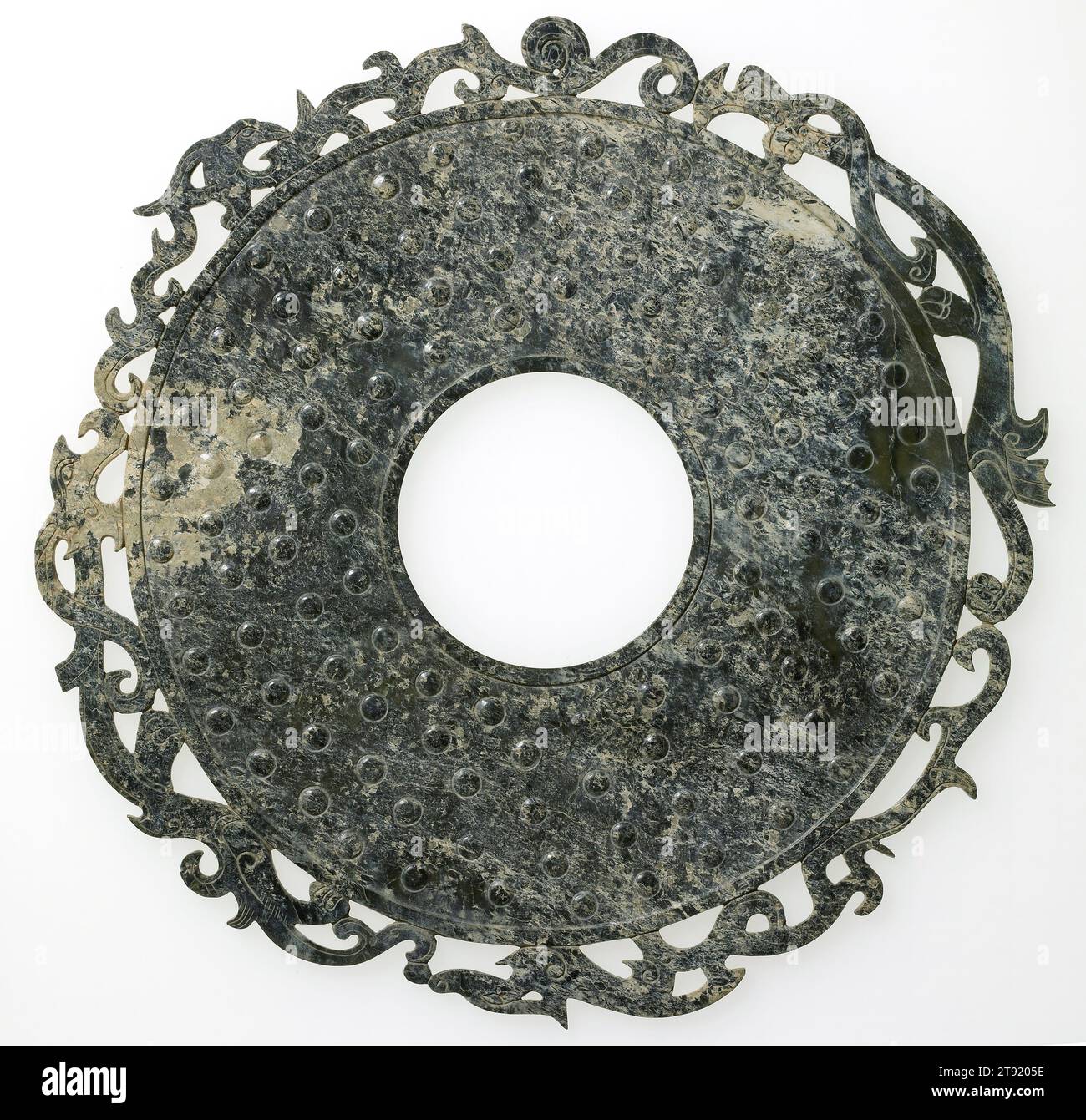 Bi Disk, 206 BCE - 220 CE, 9 5/16 x 1/8 in. (23.65 x 0.32 cm) (outer diameter), Grey-green mottled nephrite (jade), China, 1st century CE, Originating in the Hongshan culture of the Neolithic period around 4000–3000 BCE, the bi disk, according to later Bronze Age interpretation, is emblematic of heaven. Although they retain the same decorative organization of the earliest examples, the bi disks from the Han dynasty tend to be more elaborate than their Neolithic predecessors. The outer band of this bi boasts openwork designs of pairs of dragons and phoenixes Stock Photohttps://www.alamy.com/image-license-details/?v=1https://www.alamy.com/bi-disk-206-bce-220-ce-9-516-x-18-in-2365-x-032-cm-outer-diameter-grey-green-mottled-nephrite-jade-china-1st-century-ce-originating-in-the-hongshan-culture-of-the-neolithic-period-around-40003000-bce-the-bi-disk-according-to-later-bronze-age-interpretation-is-emblematic-of-heaven-although-they-retain-the-same-decorative-organization-of-the-earliest-examples-the-bi-disks-from-the-han-dynasty-tend-to-be-more-elaborate-than-their-neolithic-predecessors-the-outer-band-of-this-bi-boasts-openwork-designs-of-pairs-of-dragons-and-phoenixes-image573518106.html
Bi Disk, 206 BCE - 220 CE, 9 5/16 x 1/8 in. (23.65 x 0.32 cm) (outer diameter), Grey-green mottled nephrite (jade), China, 1st century CE, Originating in the Hongshan culture of the Neolithic period around 4000–3000 BCE, the bi disk, according to later Bronze Age interpretation, is emblematic of heaven. Although they retain the same decorative organization of the earliest examples, the bi disks from the Han dynasty tend to be more elaborate than their Neolithic predecessors. The outer band of this bi boasts openwork designs of pairs of dragons and phoenixes Stock Photohttps://www.alamy.com/image-license-details/?v=1https://www.alamy.com/bi-disk-206-bce-220-ce-9-516-x-18-in-2365-x-032-cm-outer-diameter-grey-green-mottled-nephrite-jade-china-1st-century-ce-originating-in-the-hongshan-culture-of-the-neolithic-period-around-40003000-bce-the-bi-disk-according-to-later-bronze-age-interpretation-is-emblematic-of-heaven-although-they-retain-the-same-decorative-organization-of-the-earliest-examples-the-bi-disks-from-the-han-dynasty-tend-to-be-more-elaborate-than-their-neolithic-predecessors-the-outer-band-of-this-bi-boasts-openwork-designs-of-pairs-of-dragons-and-phoenixes-image573518106.htmlRM2T9205E–Bi Disk, 206 BCE - 220 CE, 9 5/16 x 1/8 in. (23.65 x 0.32 cm) (outer diameter), Grey-green mottled nephrite (jade), China, 1st century CE, Originating in the Hongshan culture of the Neolithic period around 4000–3000 BCE, the bi disk, according to later Bronze Age interpretation, is emblematic of heaven. Although they retain the same decorative organization of the earliest examples, the bi disks from the Han dynasty tend to be more elaborate than their Neolithic predecessors. The outer band of this bi boasts openwork designs of pairs of dragons and phoenixes
 The earliest mention of Kashgar occurs when a Chinese Han Dynasty (206 BCE – 220 CE) envoy traveled the Northern Silk Road to explore lands to the west. Another early mention of Kashgar is during the Former Han (also known as the Western Han Dynasty), when in 76 BCE the Chinese conquered the Xiongnu, Yutian (Khotan), Sulei (Kashgar), and a group of states in the Tarim basin almost up to the foot of the Tian Shan mountains. Ptolemy spoke of Scythia beyond the Imaus, which is in a 'Kasia Regio', probably exhibiting the name from which Kashgar is formed. The country’s people practised Zoroastr Stock Photohttps://www.alamy.com/image-license-details/?v=1https://www.alamy.com/the-earliest-mention-of-kashgar-occurs-when-a-chinese-han-dynasty-206-bce-220-ce-envoy-traveled-the-northern-silk-road-to-explore-lands-to-the-west-another-early-mention-of-kashgar-is-during-the-former-han-also-known-as-the-western-han-dynasty-when-in-76-bce-the-chinese-conquered-the-xiongnu-yutian-khotan-sulei-kashgar-and-a-group-of-states-in-the-tarim-basin-almost-up-to-the-foot-of-the-tian-shan-mountains-ptolemy-spoke-of-scythia-beyond-the-imaus-which-is-in-a-kasia-regio-probably-exhibiting-the-name-from-which-kashgar-is-formed-the-countrys-people-practised-zoroastr-image344279961.html
The earliest mention of Kashgar occurs when a Chinese Han Dynasty (206 BCE – 220 CE) envoy traveled the Northern Silk Road to explore lands to the west. Another early mention of Kashgar is during the Former Han (also known as the Western Han Dynasty), when in 76 BCE the Chinese conquered the Xiongnu, Yutian (Khotan), Sulei (Kashgar), and a group of states in the Tarim basin almost up to the foot of the Tian Shan mountains. Ptolemy spoke of Scythia beyond the Imaus, which is in a 'Kasia Regio', probably exhibiting the name from which Kashgar is formed. The country’s people practised Zoroastr Stock Photohttps://www.alamy.com/image-license-details/?v=1https://www.alamy.com/the-earliest-mention-of-kashgar-occurs-when-a-chinese-han-dynasty-206-bce-220-ce-envoy-traveled-the-northern-silk-road-to-explore-lands-to-the-west-another-early-mention-of-kashgar-is-during-the-former-han-also-known-as-the-western-han-dynasty-when-in-76-bce-the-chinese-conquered-the-xiongnu-yutian-khotan-sulei-kashgar-and-a-group-of-states-in-the-tarim-basin-almost-up-to-the-foot-of-the-tian-shan-mountains-ptolemy-spoke-of-scythia-beyond-the-imaus-which-is-in-a-kasia-regio-probably-exhibiting-the-name-from-which-kashgar-is-formed-the-countrys-people-practised-zoroastr-image344279961.htmlRM2B038GW–The earliest mention of Kashgar occurs when a Chinese Han Dynasty (206 BCE – 220 CE) envoy traveled the Northern Silk Road to explore lands to the west. Another early mention of Kashgar is during the Former Han (also known as the Western Han Dynasty), when in 76 BCE the Chinese conquered the Xiongnu, Yutian (Khotan), Sulei (Kashgar), and a group of states in the Tarim basin almost up to the foot of the Tian Shan mountains. Ptolemy spoke of Scythia beyond the Imaus, which is in a 'Kasia Regio', probably exhibiting the name from which Kashgar is formed. The country’s people practised Zoroastr
 Milling Shed, 206 BCE - 220 CE, 5 1/2 x 10 3/4 x 8 1/2 in. (13.97 x 27.31 x 21.59 cm), Low-fired earthenware with green glaze, China, 3rd century BCE- 3rd century CE, Made from the standard orange earthenware body of Han green glazed tomb models, this miniature milling station features a circular millstone and a foot-operated mortar and pestle grain pounder under its shed roof. Both of these farm tools can still be seen in use throughout rural China. Han tombs provide an abundance of agricultural models reflecting the belief that agriculture was fundamental to the prosperity of the country Stock Photohttps://www.alamy.com/image-license-details/?v=1https://www.alamy.com/milling-shed-206-bce-220-ce-5-12-x-10-34-x-8-12-in-1397-x-2731-x-2159-cm-low-fired-earthenware-with-green-glaze-china-3rd-century-bce-3rd-century-ce-made-from-the-standard-orange-earthenware-body-of-han-green-glazed-tomb-models-this-miniature-milling-station-features-a-circular-millstone-and-a-foot-operated-mortar-and-pestle-grain-pounder-under-its-shed-roof-both-of-these-farm-tools-can-still-be-seen-in-use-throughout-rural-china-han-tombs-provide-an-abundance-of-agricultural-models-reflecting-the-belief-that-agriculture-was-fundamental-to-the-prosperity-of-the-country-image573504851.html
Milling Shed, 206 BCE - 220 CE, 5 1/2 x 10 3/4 x 8 1/2 in. (13.97 x 27.31 x 21.59 cm), Low-fired earthenware with green glaze, China, 3rd century BCE- 3rd century CE, Made from the standard orange earthenware body of Han green glazed tomb models, this miniature milling station features a circular millstone and a foot-operated mortar and pestle grain pounder under its shed roof. Both of these farm tools can still be seen in use throughout rural China. Han tombs provide an abundance of agricultural models reflecting the belief that agriculture was fundamental to the prosperity of the country Stock Photohttps://www.alamy.com/image-license-details/?v=1https://www.alamy.com/milling-shed-206-bce-220-ce-5-12-x-10-34-x-8-12-in-1397-x-2731-x-2159-cm-low-fired-earthenware-with-green-glaze-china-3rd-century-bce-3rd-century-ce-made-from-the-standard-orange-earthenware-body-of-han-green-glazed-tomb-models-this-miniature-milling-station-features-a-circular-millstone-and-a-foot-operated-mortar-and-pestle-grain-pounder-under-its-shed-roof-both-of-these-farm-tools-can-still-be-seen-in-use-throughout-rural-china-han-tombs-provide-an-abundance-of-agricultural-models-reflecting-the-belief-that-agriculture-was-fundamental-to-the-prosperity-of-the-country-image573504851.htmlRM2T91B83–Milling Shed, 206 BCE - 220 CE, 5 1/2 x 10 3/4 x 8 1/2 in. (13.97 x 27.31 x 21.59 cm), Low-fired earthenware with green glaze, China, 3rd century BCE- 3rd century CE, Made from the standard orange earthenware body of Han green glazed tomb models, this miniature milling station features a circular millstone and a foot-operated mortar and pestle grain pounder under its shed roof. Both of these farm tools can still be seen in use throughout rural China. Han tombs provide an abundance of agricultural models reflecting the belief that agriculture was fundamental to the prosperity of the country
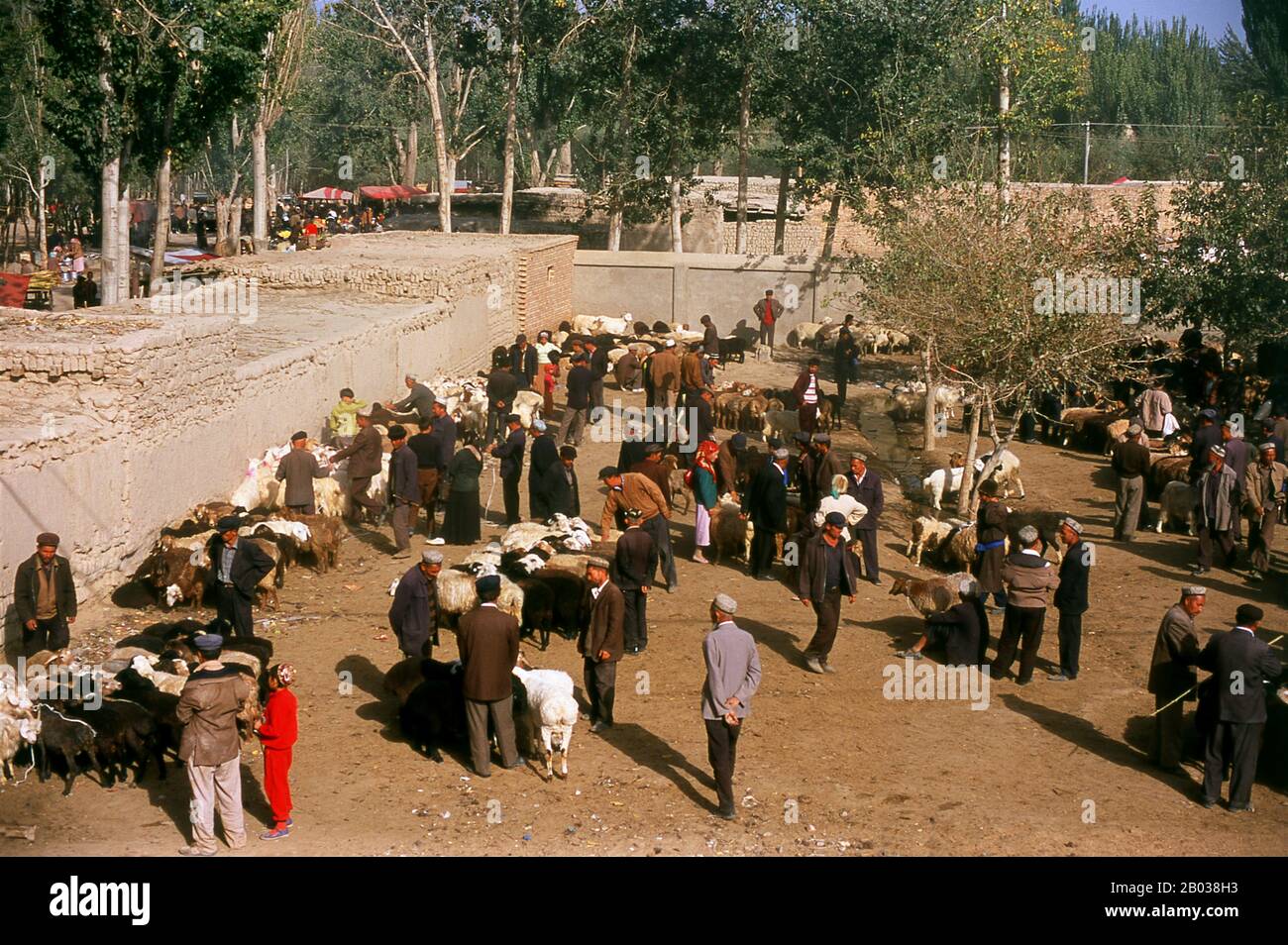 The earliest mention of Kashgar occurs when a Chinese Han Dynasty (206 BCE – 220 CE) envoy traveled the Northern Silk Road to explore lands to the west. Another early mention of Kashgar is during the Former Han (also known as the Western Han Dynasty), when in 76 BCE the Chinese conquered the Xiongnu, Yutian (Khotan), Sulei (Kashgar), and a group of states in the Tarim basin almost up to the foot of the Tian Shan mountains. Ptolemy spoke of Scythia beyond the Imaus, which is in a 'Kasia Regio', probably exhibiting the name from which Kashgar is formed. The country’s people practised Zoroastr Stock Photohttps://www.alamy.com/image-license-details/?v=1https://www.alamy.com/the-earliest-mention-of-kashgar-occurs-when-a-chinese-han-dynasty-206-bce-220-ce-envoy-traveled-the-northern-silk-road-to-explore-lands-to-the-west-another-early-mention-of-kashgar-is-during-the-former-han-also-known-as-the-western-han-dynasty-when-in-76-bce-the-chinese-conquered-the-xiongnu-yutian-khotan-sulei-kashgar-and-a-group-of-states-in-the-tarim-basin-almost-up-to-the-foot-of-the-tian-shan-mountains-ptolemy-spoke-of-scythia-beyond-the-imaus-which-is-in-a-kasia-regio-probably-exhibiting-the-name-from-which-kashgar-is-formed-the-countrys-people-practised-zoroastr-image344279967.html
The earliest mention of Kashgar occurs when a Chinese Han Dynasty (206 BCE – 220 CE) envoy traveled the Northern Silk Road to explore lands to the west. Another early mention of Kashgar is during the Former Han (also known as the Western Han Dynasty), when in 76 BCE the Chinese conquered the Xiongnu, Yutian (Khotan), Sulei (Kashgar), and a group of states in the Tarim basin almost up to the foot of the Tian Shan mountains. Ptolemy spoke of Scythia beyond the Imaus, which is in a 'Kasia Regio', probably exhibiting the name from which Kashgar is formed. The country’s people practised Zoroastr Stock Photohttps://www.alamy.com/image-license-details/?v=1https://www.alamy.com/the-earliest-mention-of-kashgar-occurs-when-a-chinese-han-dynasty-206-bce-220-ce-envoy-traveled-the-northern-silk-road-to-explore-lands-to-the-west-another-early-mention-of-kashgar-is-during-the-former-han-also-known-as-the-western-han-dynasty-when-in-76-bce-the-chinese-conquered-the-xiongnu-yutian-khotan-sulei-kashgar-and-a-group-of-states-in-the-tarim-basin-almost-up-to-the-foot-of-the-tian-shan-mountains-ptolemy-spoke-of-scythia-beyond-the-imaus-which-is-in-a-kasia-regio-probably-exhibiting-the-name-from-which-kashgar-is-formed-the-countrys-people-practised-zoroastr-image344279967.htmlRM2B038H3–The earliest mention of Kashgar occurs when a Chinese Han Dynasty (206 BCE – 220 CE) envoy traveled the Northern Silk Road to explore lands to the west. Another early mention of Kashgar is during the Former Han (also known as the Western Han Dynasty), when in 76 BCE the Chinese conquered the Xiongnu, Yutian (Khotan), Sulei (Kashgar), and a group of states in the Tarim basin almost up to the foot of the Tian Shan mountains. Ptolemy spoke of Scythia beyond the Imaus, which is in a 'Kasia Regio', probably exhibiting the name from which Kashgar is formed. The country’s people practised Zoroastr
 Dish, 3rd-2nd century BCE, 1 3/8 x 8 3/4 in. (3.49 x 22.23 cm), Lacquer over wood core, China, 3rd-2nd century BCE, Lacquerware vessels were widely used for food and drink in the palaces and households of the Han aristocracy. Made from the sap of a type of sumac, lacquer was difficult and expensive to produce, but greatly treasured. Light, durable, impervious to water, and conducive to painted decoration, it had nearly replaced inlaid bronze and gilt vessels by the end of Han (206 B.C.-A.D. 220 Stock Photohttps://www.alamy.com/image-license-details/?v=1https://www.alamy.com/dish-3rd-2nd-century-bce-1-38-x-8-34-in-349-x-2223-cm-lacquer-over-wood-core-china-3rd-2nd-century-bce-lacquerware-vessels-were-widely-used-for-food-and-drink-in-the-palaces-and-households-of-the-han-aristocracy-made-from-the-sap-of-a-type-of-sumac-lacquer-was-difficult-and-expensive-to-produce-but-greatly-treasured-light-durable-impervious-to-water-and-conducive-to-painted-decoration-it-had-nearly-replaced-inlaid-bronze-and-gilt-vessels-by-the-end-of-han-206-bc-ad-220-image573517678.html
Dish, 3rd-2nd century BCE, 1 3/8 x 8 3/4 in. (3.49 x 22.23 cm), Lacquer over wood core, China, 3rd-2nd century BCE, Lacquerware vessels were widely used for food and drink in the palaces and households of the Han aristocracy. Made from the sap of a type of sumac, lacquer was difficult and expensive to produce, but greatly treasured. Light, durable, impervious to water, and conducive to painted decoration, it had nearly replaced inlaid bronze and gilt vessels by the end of Han (206 B.C.-A.D. 220 Stock Photohttps://www.alamy.com/image-license-details/?v=1https://www.alamy.com/dish-3rd-2nd-century-bce-1-38-x-8-34-in-349-x-2223-cm-lacquer-over-wood-core-china-3rd-2nd-century-bce-lacquerware-vessels-were-widely-used-for-food-and-drink-in-the-palaces-and-households-of-the-han-aristocracy-made-from-the-sap-of-a-type-of-sumac-lacquer-was-difficult-and-expensive-to-produce-but-greatly-treasured-light-durable-impervious-to-water-and-conducive-to-painted-decoration-it-had-nearly-replaced-inlaid-bronze-and-gilt-vessels-by-the-end-of-han-206-bc-ad-220-image573517678.htmlRM2T91YJ6–Dish, 3rd-2nd century BCE, 1 3/8 x 8 3/4 in. (3.49 x 22.23 cm), Lacquer over wood core, China, 3rd-2nd century BCE, Lacquerware vessels were widely used for food and drink in the palaces and households of the Han aristocracy. Made from the sap of a type of sumac, lacquer was difficult and expensive to produce, but greatly treasured. Light, durable, impervious to water, and conducive to painted decoration, it had nearly replaced inlaid bronze and gilt vessels by the end of Han (206 B.C.-A.D. 220
 The earliest mention of Kashgar occurs when a Chinese Han Dynasty (206 BCE – 220 CE) envoy traveled the Northern Silk Road to explore lands to the west. Another early mention of Kashgar is during the Former Han (also known as the Western Han Dynasty), when in 76 BCE the Chinese conquered the Xiongnu, Yutian (Khotan), Sulei (Kashgar), and a group of states in the Tarim basin almost up to the foot of the Tian Shan mountains. Ptolemy spoke of Scythia beyond the Imaus, which is in a 'Kasia Regio', probably exhibiting the name from which Kashgar is formed. The country’s people practised Zoroastr Stock Photohttps://www.alamy.com/image-license-details/?v=1https://www.alamy.com/the-earliest-mention-of-kashgar-occurs-when-a-chinese-han-dynasty-206-bce-220-ce-envoy-traveled-the-northern-silk-road-to-explore-lands-to-the-west-another-early-mention-of-kashgar-is-during-the-former-han-also-known-as-the-western-han-dynasty-when-in-76-bce-the-chinese-conquered-the-xiongnu-yutian-khotan-sulei-kashgar-and-a-group-of-states-in-the-tarim-basin-almost-up-to-the-foot-of-the-tian-shan-mountains-ptolemy-spoke-of-scythia-beyond-the-imaus-which-is-in-a-kasia-regio-probably-exhibiting-the-name-from-which-kashgar-is-formed-the-countrys-people-practised-zoroastr-image344279966.html
The earliest mention of Kashgar occurs when a Chinese Han Dynasty (206 BCE – 220 CE) envoy traveled the Northern Silk Road to explore lands to the west. Another early mention of Kashgar is during the Former Han (also known as the Western Han Dynasty), when in 76 BCE the Chinese conquered the Xiongnu, Yutian (Khotan), Sulei (Kashgar), and a group of states in the Tarim basin almost up to the foot of the Tian Shan mountains. Ptolemy spoke of Scythia beyond the Imaus, which is in a 'Kasia Regio', probably exhibiting the name from which Kashgar is formed. The country’s people practised Zoroastr Stock Photohttps://www.alamy.com/image-license-details/?v=1https://www.alamy.com/the-earliest-mention-of-kashgar-occurs-when-a-chinese-han-dynasty-206-bce-220-ce-envoy-traveled-the-northern-silk-road-to-explore-lands-to-the-west-another-early-mention-of-kashgar-is-during-the-former-han-also-known-as-the-western-han-dynasty-when-in-76-bce-the-chinese-conquered-the-xiongnu-yutian-khotan-sulei-kashgar-and-a-group-of-states-in-the-tarim-basin-almost-up-to-the-foot-of-the-tian-shan-mountains-ptolemy-spoke-of-scythia-beyond-the-imaus-which-is-in-a-kasia-regio-probably-exhibiting-the-name-from-which-kashgar-is-formed-the-countrys-people-practised-zoroastr-image344279966.htmlRM2B038H2–The earliest mention of Kashgar occurs when a Chinese Han Dynasty (206 BCE – 220 CE) envoy traveled the Northern Silk Road to explore lands to the west. Another early mention of Kashgar is during the Former Han (also known as the Western Han Dynasty), when in 76 BCE the Chinese conquered the Xiongnu, Yutian (Khotan), Sulei (Kashgar), and a group of states in the Tarim basin almost up to the foot of the Tian Shan mountains. Ptolemy spoke of Scythia beyond the Imaus, which is in a 'Kasia Regio', probably exhibiting the name from which Kashgar is formed. The country’s people practised Zoroastr